Glossary
Plant Care Library
C
Cactus Mystery Box
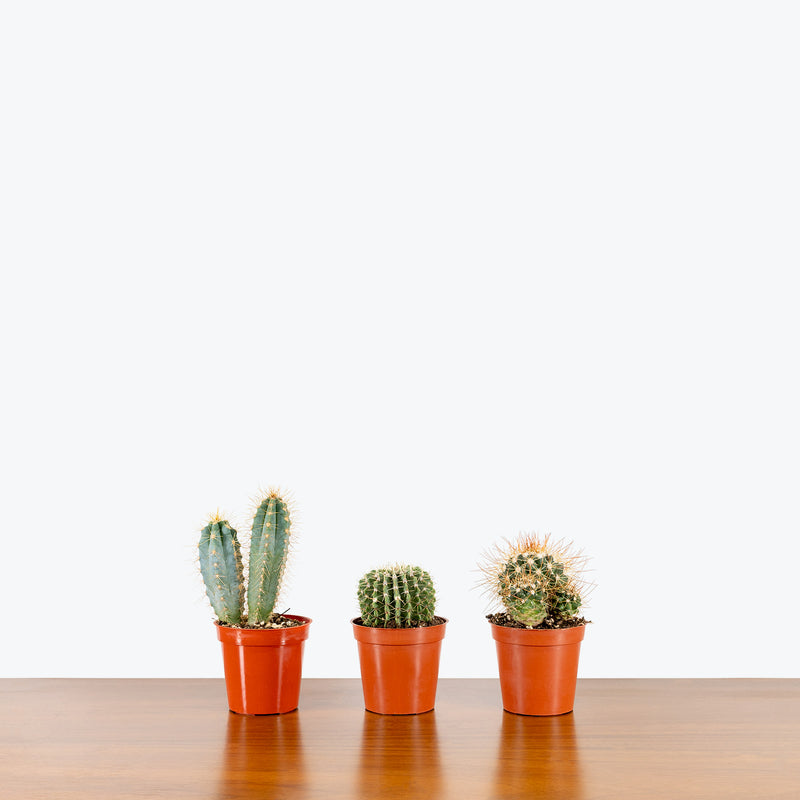
How to care for Cactus Mystery Box
They enjoy some direct sun, but they'll also do well in bright, indirect light. It is best to place this plant somewhere where it will receive some nice morning sun, or a couple hours of afternoon sun, and then indirect light the rest of the day.
They will do best in bright light. A nice bright place inside your home would be on the window sill or a stool that is right next to a window, either with or without blinds, depending on if the plant can handle sun. Remember that plants will grow based on how much light they receive.
They like the soil to be completely dry before the next watering. That usually takes about 4 weeks in an average home environment. It will vary depending on the time of year, your environment and lighting conditions, but for them, it's always safer to underwater or water when you see signs of lack of water (i.e. wrinkly or soft leaves).
Their humidity requirement is low, so do not mist them or put them in an enclosed terrarium.
As with all succulents, overwatering is sure to be fatal, so err on the side of too dry rather than too wet, never letting it sit in water. If the side of the plant facing the sun starts to turn yellow or brown, move the plant to a spot where it will receive less direct sunlight than it was receiving.
This plant is moderately toxic and can cause some adverse reactions when ingested so it is best to not let your pets eat it, which we advise for all plants in general. The severity of the reaction will depend on how much of the plant is ingested but, if you know your pet typically does not eat your plants, this plant will be suitable for your home..
Learn MoreView PlantCaladium Carolyn Whorton
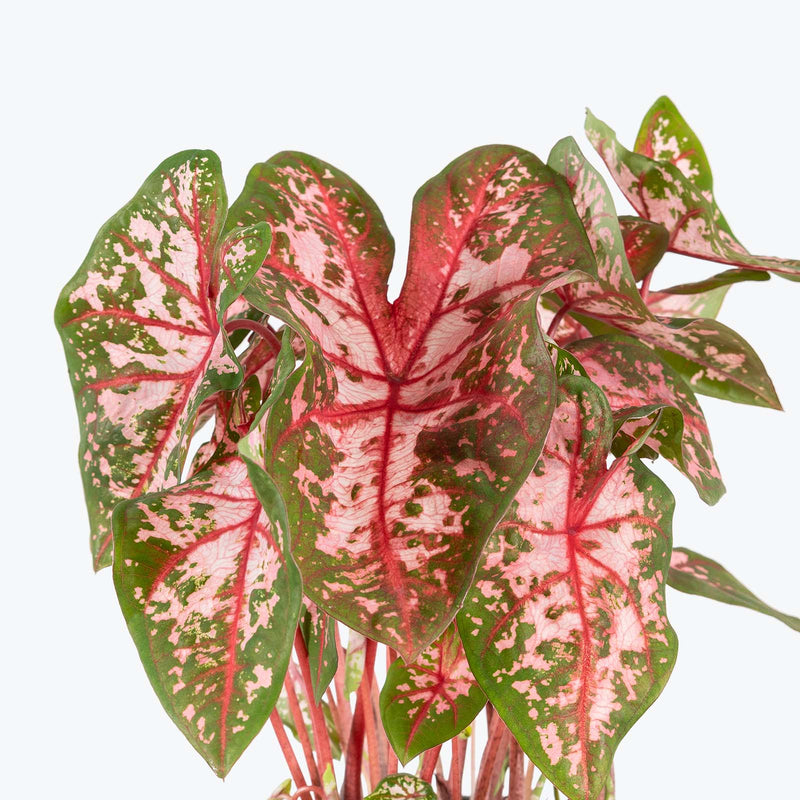
How to care for Caladium Carolyn Whorton
They should not be in a position to see the sun directly, although early morning or late evening sun is fine. Filtered sunlight through a sheer curtain is best and most homes are comprised primarily of indirect sunlight. The best spot for them is where they do not see the sun during the majority of the day but still get bright, indirect light.
They will thrive in bright light, but also can tolerate medium light. A good medium-light place in your home would be in the middle of a room that has a regular size window. They can be placed anywhere between the middle of the room and the window. Remember that plants will grow based on how much light they receive.
Allow the top quarter of the soil to dry before watering again. This usually takes about 3 - 4 days in an average home environment. It will vary depending on the time of year, your environment and lighting conditions. Expect to water more often in brighter light and less often in lower light. When the leaves start to die back in the fall, stop watering until the spring.
They like a high humidity environment, give them a mist daily or as often as possible. Alternatively, you can put them around a humidifier. Although they won't die if they don't receive enough humidity, their leaves may have some dry, crunchy, or yellow edges.
Caladium always go dormant throughout the winter, so do not fret when their foliage starts to die back after a few months, or in the fall. When this happens, stop watering, place the pot in a dark, warm place (no cooler than 16°C for at least 2 months), then bring it out again in the spring, give it fresh soil, and begin the watering cycle again! Fertilize your plant during the growing season.
This plant is moderately toxic and can cause some adverse reactions when ingested so it is best to not let your pets eat it, which we advise for all plants in general. The severity of the reaction will depend on how much of the plant is ingested but, if you know your pet typically does not eat your plants, this plant will be suitable for your home..
View PlantCaladium Monument
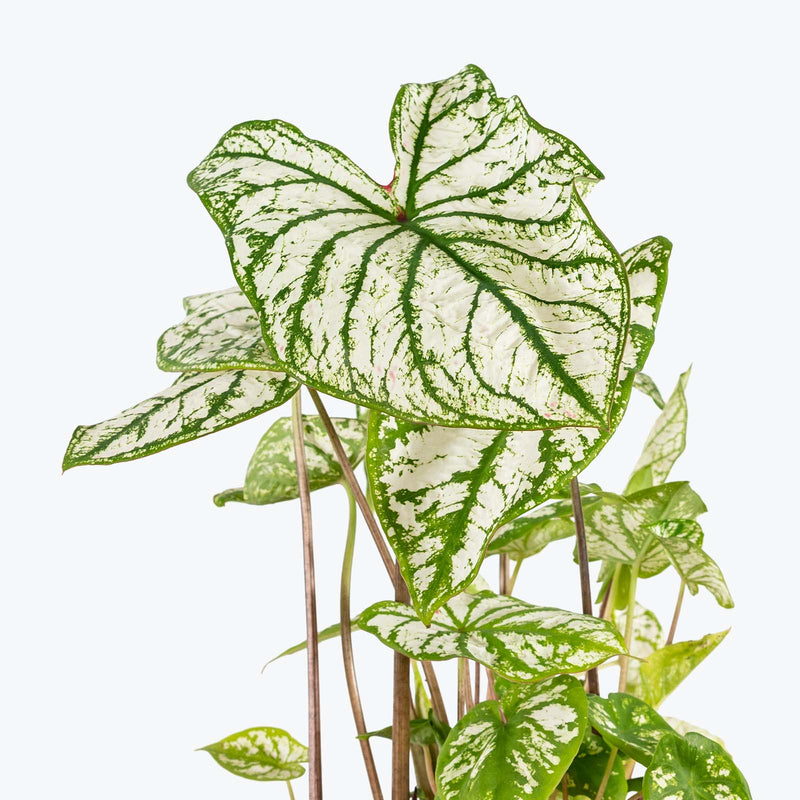
How to care for Caladium Monument
They should not be in a position to see the sun directly, although early morning or late evening sun is fine. Filtered sunlight through a sheer curtain is best and most homes are comprised primarily of indirect sunlight. The best spot for them is where they do not see the sun during the majority of the day but still get bright, indirect light.
They will thrive in bright light, but also can tolerate medium light. A good medium-light place in your home would be in the middle of a room that has a regular size window. They can be placed anywhere between the middle of the room and the window. Remember that plants will grow based on how much light they receive.
Allow the top quarter of the soil to dry before watering again. This usually takes about 3 - 4 days in an average home environment. It will vary depending on the time of year, your environment and lighting conditions. Expect to water more often in brighter light and less often in lower light. When the leaves start to die back in the fall, stop watering until the spring.
They like a high humidity environment, give them a mist daily or as often as possible. Alternatively, you can put them around a humidifier. Although they won't die if they don't receive enough humidity, their leaves may have some dry, crunchy, or yellow edges.
Caladium always go dormant throughout the winter, so do not fret when their foliage starts to die back after a few months, or in the fall. When this happens, stop watering, place the pot in a dark, warm place (no cooler than 16°C for at least 2 months), then bring it out again in the spring, give it fresh soil, and begin the watering cycle again! Fertilize your plant during the growing season.
This plant is moderately toxic and can cause some adverse reactions when ingested so it is best to not let your pets eat it, which we advise for all plants in general. The severity of the reaction will depend on how much of the plant is ingested but, if you know your pet typically does not eat your plants, this plant will be suitable for your home..
View PlantCaladium Pink Splash
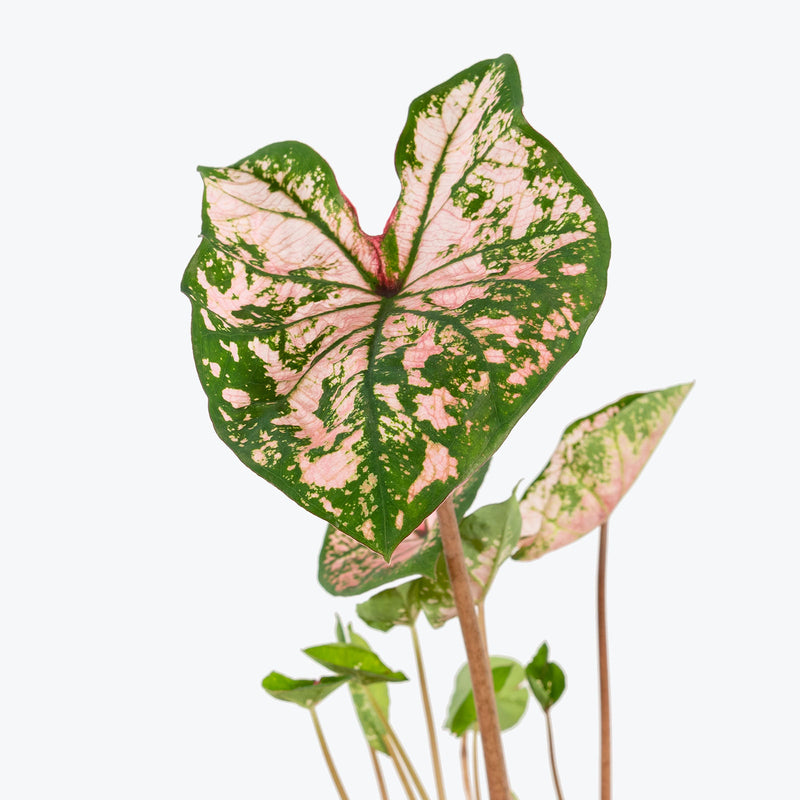
How to care for Caladium Pink Splash
They should not be in a position to see the sun directly, although early morning or late evening sun is fine. Filtered sunlight through a sheer curtain is best and most homes are comprised primarily of indirect sunlight. The best spot for them is where they do not see the sun during the majority of the day but still get bright, indirect light.
They will thrive in bright light, but also can tolerate medium light. A good medium-light place in your home would be in the middle of a room that has a regular size window. They can be placed anywhere between the middle of the room and the window. Remember that plants will grow based on how much light they receive.
Allow the top quarter of the soil to dry before watering again. This usually takes about 3 - 4 days in an average home environment. It will vary depending on the time of year, your environment and lighting conditions. Expect to water more often in brighter light and less often in lower light. When the leaves start to die back in the fall, stop watering until the spring.
They like a high humidity environment, give them a mist daily or as often as possible. Alternatively, you can put them around a humidifier. Although they won't die if they don't receive enough humidity, their leaves may have some dry, crunchy, or yellow edges.
Caladium always go dormant throughout the winter, so do not fret when their foliage starts to die back after a few months, or in the fall. When this happens, stop watering, place the pot in a dark, warm place (no cooler than 16°C for at least 2 months), then bring it out again in the spring, give it fresh soil, and begin the watering cycle again! Fertilize your plant during the growing season.
This plant is moderately toxic and can cause some adverse reactions when ingested so it is best to not let your pets eat it, which we advise for all plants in general. The severity of the reaction will depend on how much of the plant is ingested but, if you know your pet typically does not eat your plants, this plant will be suitable for your home..
View PlantCaladium Red Flash
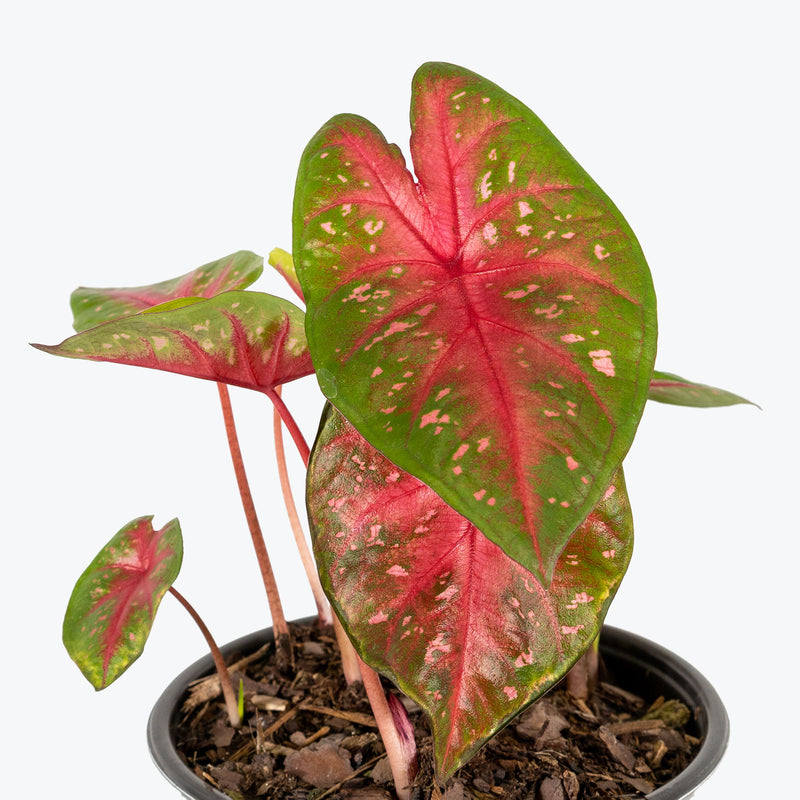
How to care for Caladium Red Flash
They should not be in a position to see the sun directly, although early morning or late evening sun is fine. Filtered sunlight through a sheer curtain is best and most homes are comprised primarily of indirect sunlight. The best spot for them is where they do not see the sun during the majority of the day but still get bright, indirect light.
They will thrive in bright light, but also can tolerate medium light. A good medium-light place in your home would be in the middle of a room that has a regular size window. They can be placed anywhere between the middle of the room and the window. Remember that plants will grow based on how much light they receive.
Allow the top quarter of the soil to dry before watering again. This usually takes about 3 - 4 days in an average home environment. It will vary depending on the time of year, your environment and lighting conditions. Expect to water more often in brighter light and less often in lower light. When the leaves start to die back in the fall, stop watering until the spring.
They like a high humidity environment, give them a mist daily or as often as possible. Alternatively, you can put them around a humidifier. Although they won't die if they don't receive enough humidity, their leaves may have some dry, crunchy, or yellow edges.
Caladium always go dormant throughout the winter, so do not fret when their foliage starts to die back after a few months, or in the fall. When this happens, stop watering, place the pot in a dark, warm place (no cooler than 16°C for at least 2 months), then bring it out again in the spring, give it fresh soil, and begin the watering cycle again! Fertilize your plant during the growing season.
This plant is moderately toxic and can cause some adverse reactions when ingested so it is best to not let your pets eat it, which we advise for all plants in general. The severity of the reaction will depend on how much of the plant is ingested but, if you know your pet typically does not eat your plants, this plant will be suitable for your home..
View PlantCaladium White Moonlight
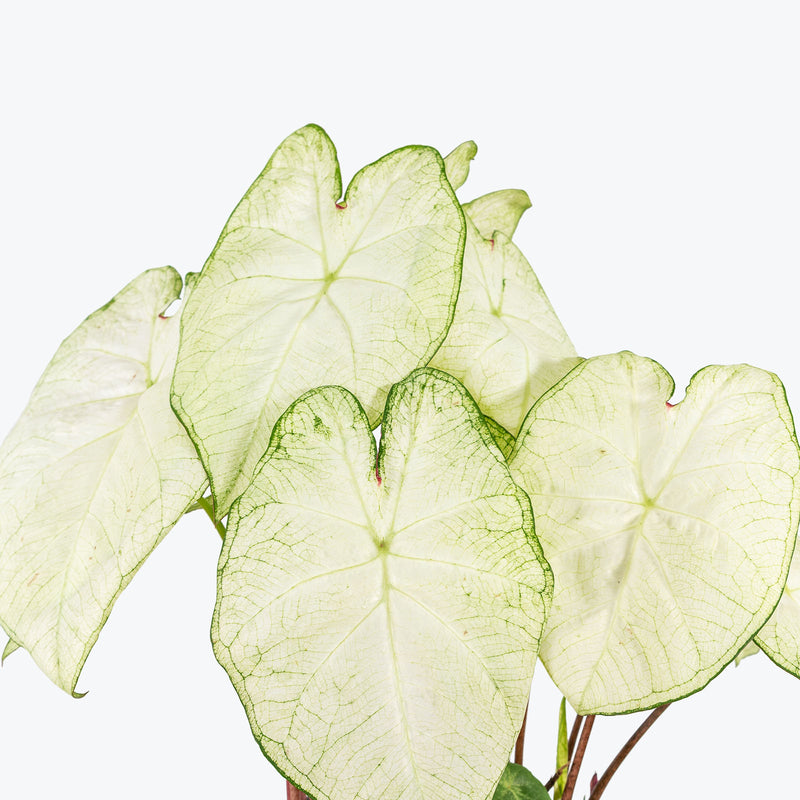
How to care for Caladium White Moonlight
They should not be in a position to see the sun directly, although early morning or late evening sun is fine. Filtered sunlight through a sheer curtain is best and most homes are comprised primarily of indirect sunlight. The best spot for them is where they do not see the sun during the majority of the day but still get bright, indirect light.
They will thrive in bright light, but also can tolerate medium light. A good medium-light place in your home would be in the middle of a room that has a regular size window. They can be placed anywhere between the middle of the room and the window. Remember that plants will grow based on how much light they receive.
Allow the top quarter of the soil to dry before watering again. This usually takes about 3 - 4 days in an average home environment. It will vary depending on the time of year, your environment and lighting conditions. Expect to water more often in brighter light and less often in lower light. When the leaves start to die back in the fall, stop watering until the spring.
They like a high humidity environment, give them a mist daily or as often as possible. Alternatively, you can put them around a humidifier. Although they won't die if they don't receive enough humidity, their leaves may have some dry, crunchy, or yellow edges.
Caladium always go dormant throughout the winter, so do not fret when their foliage starts to die back after a few months, or in the fall. When this happens, stop watering, place the pot in a dark, warm place (no cooler than 16°C for at least 2 months), then bring it out again in the spring, give it fresh soil, and begin the watering cycle again! Fertilize your plant during the growing season.
This plant is moderately toxic and can cause some adverse reactions when ingested so it is best to not let your pets eat it, which we advise for all plants in general. The severity of the reaction will depend on how much of the plant is ingested but, if you know your pet typically does not eat your plants, this plant will be suitable for your home..
View PlantCaladium White Queen
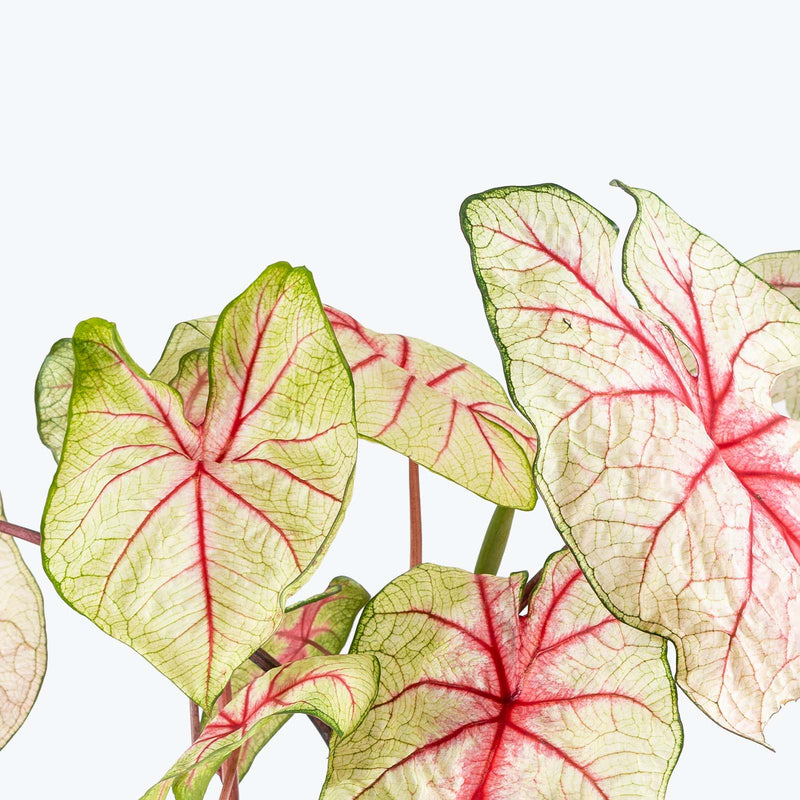
How to care for Caladium White Queen
They should not be in a position to see the sun directly, although early morning or late evening sun is fine. Filtered sunlight through a sheer curtain is best and most homes are comprised primarily of indirect sunlight. The best spot for them is where they do not see the sun during the majority of the day but still get bright, indirect light.
They will thrive in bright light, but also can tolerate medium light. A good medium-light place in your home would be in the middle of a room that has a regular size window. They can be placed anywhere between the middle of the room and the window. Remember that plants will grow based on how much light they receive.
Allow the top quarter of the soil to dry before watering again. This usually takes about 3 - 4 days in an average home environment. It will vary depending on the time of year, your environment and lighting conditions. Expect to water more often in brighter light and less often in lower light.
They like a high humidity environment, give them a mist daily or as often as possible. Alternatively, you can put them around a humidifier. Although they won't die if they don't receive enough humidity, their leaves may have some dry, crunchy, or yellow edges.
Caladium always go dormant throughout the winter, so do not fret when their foliage starts to die back after a few months, or in the fall. When this happens, stop watering, place the pot in a dark, warm place (no cooler than 16°C for at least 2 months), then bring it out again in the spring, give it fresh soil, and begin the watering cycle again! Fertilize your plant during the growing season.
This plant is moderately toxic and can cause some adverse reactions when ingested so it is best to not let your pets eat it, which we advise for all plants in general. The severity of the reaction will depend on how much of the plant is ingested but, if you know your pet typically does not eat your plants, this plant will be suitable for your home..
View PlantCalamondin Orange Tree
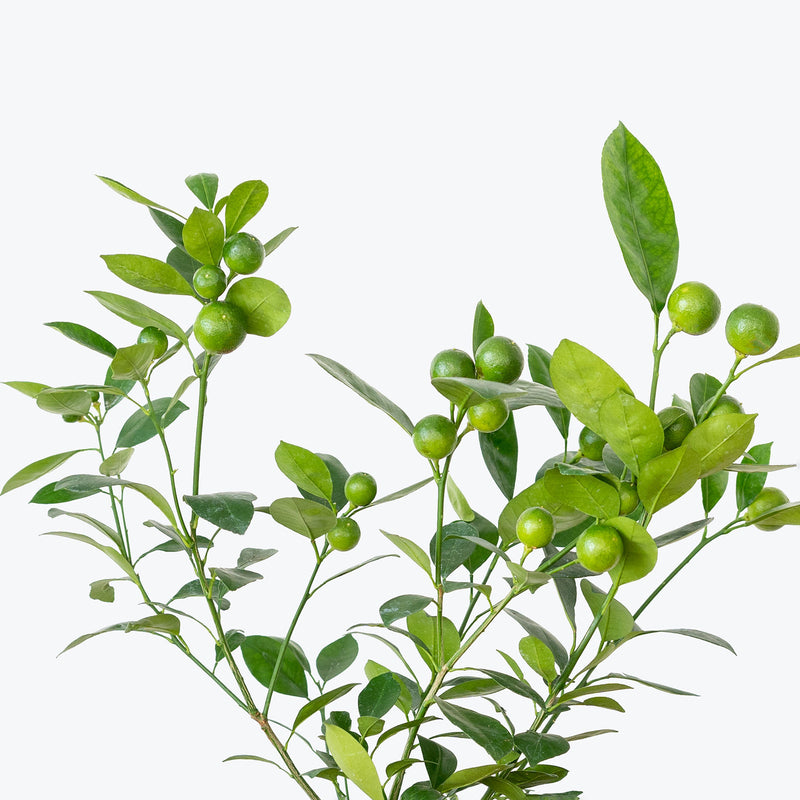
How to care for Calamondin Orange Tree
Calamondin Orange Tree loves as much sun as possible. The best spot for them is where they can see the sun during the majority of the day.
Calamondin Orange Tree will do best in bright light. A nice bright place inside your home would be on the window sill or a stool that is right next to a window, either with or without blinds, depending on if the plant can handle sun. Remember that plants will grow based on how much light they receive.
Calamondin Orange Tree needs to be watered when the top half of the soil is dry to the touch. That usually takes about 1 week in an average home environment. It will vary depending on the time of year, your environment and lighting conditions, but it's always safer to underwater or give the soil a check before you water again.
Calamondin Orange Tree will do well in average humidity environments but will appreciate a little bit of humidity if provided, give them a mist daily or get a humidifier.
Prune your Calamondin Orange Tree back in the spring when new growth starts to avoid it becoming "leggy", or stretched out, this will also encourage new branches to grow from just below the cut. To promote blooming, make sure to keep your plant snug in its pot, if there is too much room for the roots, it will not focus on flowering. Avoid putting the plant in a spot that has drafts.
Calamondin Orange Tree is moderately toxic and can cause some adverse reactions when ingested so it is best to not let your pets eat it, which we advise for all plants in general. The severity of the reaction will depend on how much of the plant is ingested but, if you know your pet typically does not eat your plants, this plant will be suitable for your home..
Learn MoreView PlantCalathea Beauty Star
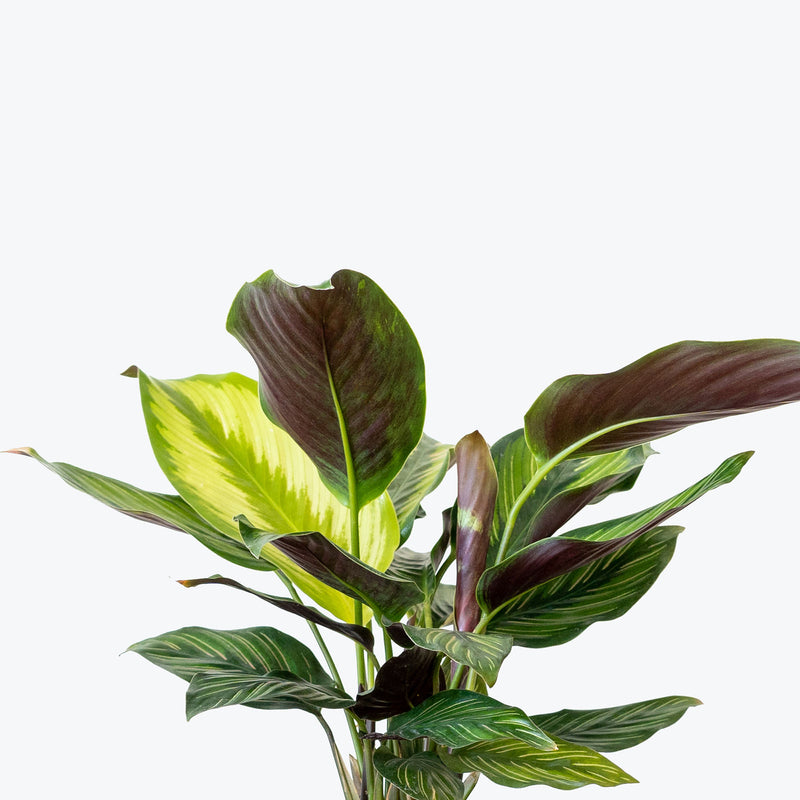
How to care for Calathea Beauty Star
They should not be in a position to see the sun directly, although early morning or late evening sun is fine. Filtered sunlight through a sheer curtain is best and most homes are comprised primarily of indirect sunlight. The best spot for them is where they do not see the sun during the majority of the day but still get bright, indirect light.
They will thrive in bright light, but also can tolerate medium light. A good medium-light place in your home would be in the middle of a room that has a regular size window. They can be placed anywhere between the middle of the room and the window. Remember that plants will grow based on how much light they receive.
They need to be watered when the top half of the soil is dry to the touch. That usually takes about 1 week in an average home environment. It will vary depending on the time of year, your environment and lighting conditions, but it's always safer to underwater or give the soil a check before you water again.
They like a high humidity environment, give them a mist daily or as often as possible. Alternatively, you can put them around a humidifier. Although they won't die if they don't receive enough humidity, their leaves may have some dry, crunchy, or yellow edges.
Although Calathea's are known as the divas of the plant world, once they are in the right environment, the payoff is phenomenal. No two leaves are alike and the colours that occur through all the varieties in the family are bold and beautiful. Keep in a highly humid environment with lots of bright, indirect light (no direct sun), watering only with distilled or rain water. Once this is achieved, you will sit and stare at your new plant for hours.
You can feel comfortable having this plant around your home in the potential case where your pet feels like nibbling on it. However, we typically recommend keeping your pets from eating any of your houseplants..
Learn MoreView PlantCalathea Compact Star
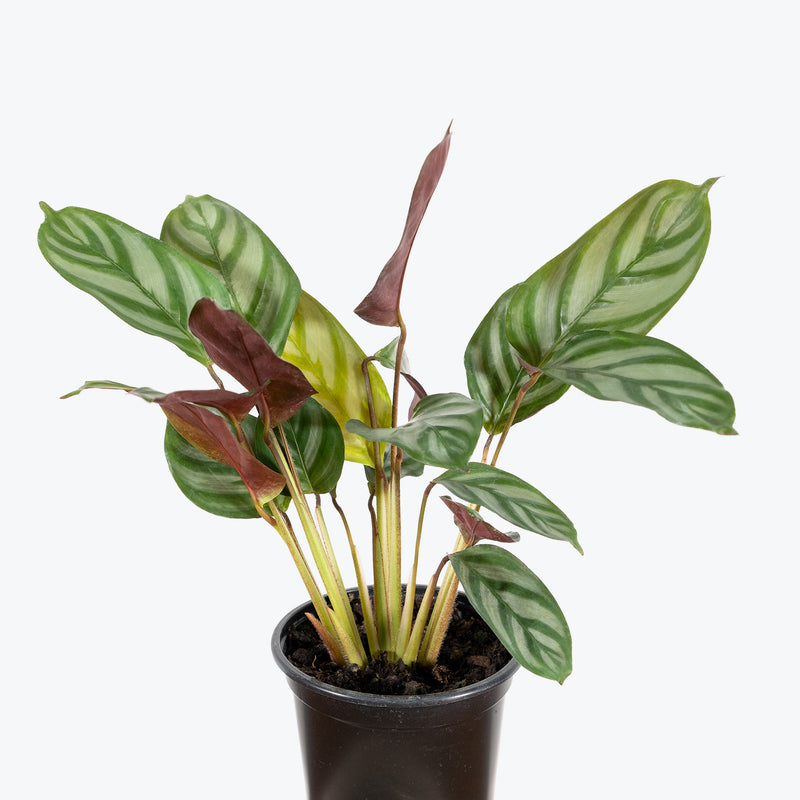
How to care for Calathea Compact Star
They should not be in a position to see the sun directly, although early morning or late evening sun is fine. Filtered sunlight through a sheer curtain is best and most homes are comprised primarily of indirect sunlight. The best spot for them is where they do not see the sun during the majority of the day but still get bright, indirect light.
They will thrive in bright light, but also can tolerate medium light. A good medium-light place in your home would be in the middle of a room that has a regular size window. They can be placed anywhere between the middle of the room and the window. Remember that plants will grow based on how much light they receive.
They need to be watered when the top half of the soil is dry to the touch. That usually takes about 1 week in an average home environment. It will vary depending on the time of year, your environment and lighting conditions, but it's always safer to underwater or give the soil a check before you water again.
They like a high humidity environment, give them a mist daily or as often as possible. Alternatively, you can put them around a humidifier. Although they won't die if they don't receive enough humidity, their leaves may have some dry, crunchy, or yellow edges.
Although Calathea's are known as the divas of the plant world, once they are in the right environment, the payoff is phenomenal. No two leaves are alike and the colours that occur through all the varieties in the family are bold and beautiful. Keep in a highly humid environment with lots of bright, indirect light (no direct sun), watering only with distilled or rain water. Once this is achieved, you will sit and stare at your new plant for hours.
You can feel comfortable having this plant around your home in the potential case where your pet feels like nibbling on it. However, we typically recommend keeping your pets from eating any of your houseplants..
Learn MoreView PlantCalathea Dottie
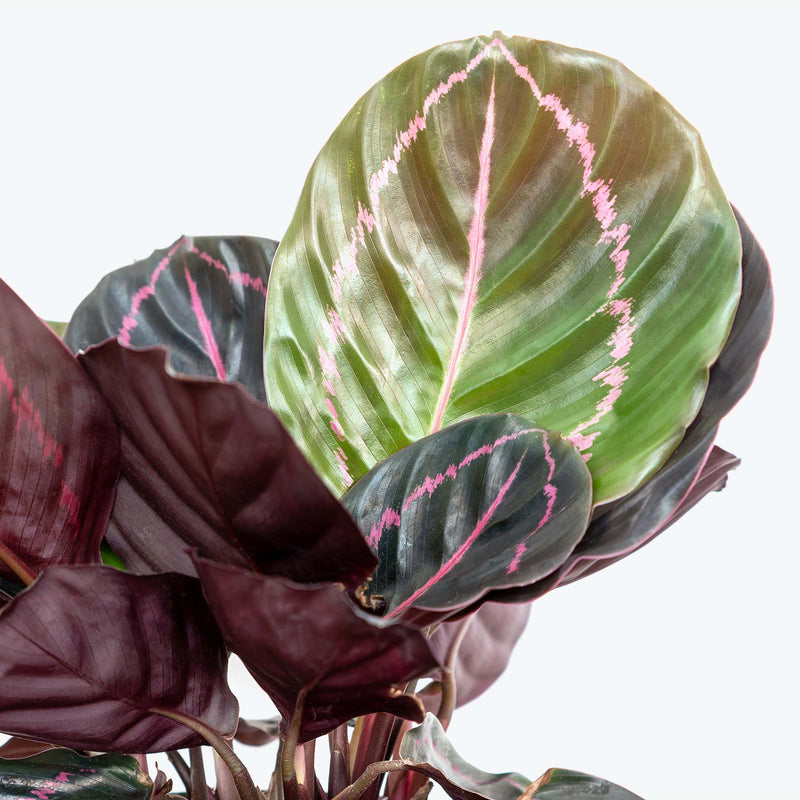
How to care for Calathea Dottie
They should not be in a position to see the sun directly, although early morning or late evening sun is fine. Filtered sunlight through a sheer curtain is best and most homes are comprised primarily of indirect sunlight. The best spot for them is where they do not see the sun during the majority of the day but still get bright, indirect light.
They will thrive in bright light, but also can tolerate medium light. A good medium-light place in your home would be in the middle of a room that has a regular size window. They can be placed anywhere between the middle of the room and the window. Remember that plants will grow based on how much light they receive.
They need to be watered when the top half of the soil is dry to the touch. That usually takes about 1 week in an average home environment. It will vary depending on the time of year, your environment and lighting conditions, but it's always safer to underwater or give the soil a check before you water again.
They like a high humidity environment, give them a mist daily or as often as possible. Alternatively, you can put them around a humidifier. Although they won't die if they don't receive enough humidity, their leaves may have some dry, crunchy, or yellow edges.
Although Calathea's are known as the divas of the plant world, once they are in the right environment, the payoff is phenomenal. No two leaves are alike and the colours that occur through all the varieties in the family are bold and beautiful. Keep in a highly humid environment with lots of bright, indirect light (no direct sun), watering only with distilled or rain water. Once this is achieved, you will sit and stare at your new plant for hours!
You can feel comfortable having this plant around your home in the potential case where your pet feels like nibbling on it. However, we typically recommend keeping your pets from eating any of your houseplants..
Learn MoreView PlantCalathea Fasciata Borrusica
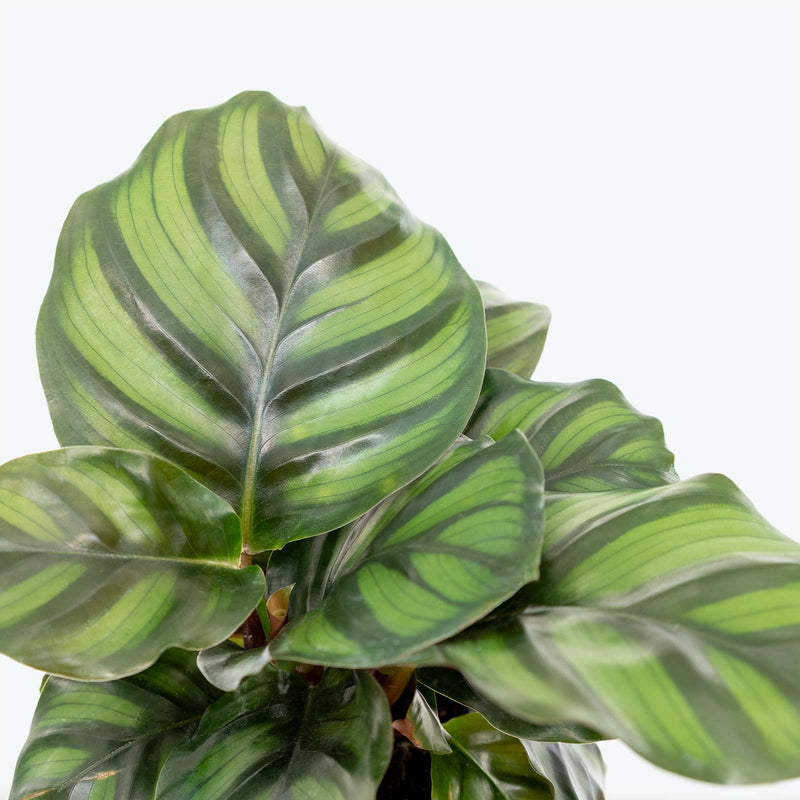
How to care for Calathea Fasciata Borrusica
Calathea Fasciata Borrusica should not be in a position to see the sun directly, although early morning or late evening sun is fine. Filtered sunlight through a sheer curtain is best and most homes are comprised primarily of indirect sunlight. The best spot for them is where they do not see the sun during the majority of the day but still get bright, indirect light.
Calathea Fasciata Borrusica will thrive in bright light, but also can tolerate medium light. A good medium-light place in your home would be in the middle of a room that has a regular size window. They can be placed anywhere between the middle of the room and the window. Remember that plants will grow based on how much light they receive.
Calathea Fasciata Borrusica needs to be watered when the top half of the soil is dry to the touch. That usually takes about 1 week in an average home environment. It will vary depending on the time of year, your environment and lighting conditions, but it's always safer to underwater or give the soil a check before you water again.
Calathea Fasciata Borrusica likes a high humidity environment, give them a mist daily or as often as possible. Alternatively, you can put them around a humidifier. Although they won't die if they don't receive enough humidity, their leaves may have some dry, crunchy, or yellow edges.
Although Calathea's are known as the divas of the plant world, once they are in the right environment, the payoff is phenomenal. No two leaves are alike and the colours that occur through all the varieties in the family are bold and beautiful. Keep Calathea Fasciata Borrusica in a highly humid environment with lots of bright, indirect light (no direct sun), watering only with distilled or rainwater. Once this is achieved, you will sit and stare at your new plant for hours!
You can feel comfortable having Calathea Fasciata Borrusica around your home in the potential case where your pet feels like nibbling on it. However, we typically recommend keeping your pets from eating any of your houseplants..
Learn MoreView PlantCalathea Flamestar

How to care for Calathea Flamestar
They should not be in a position to see the sun directly, although early morning or late evening sun is fine. Filtered sunlight through a sheer curtain is best and most homes are comprised primarily of indirect sunlight. The best spot for them is where they do not see the sun during the majority of the day but still get bright, indirect light.
They will do well in medium light but will grow faster with brighter light. A good medium-light place in your home would be in the middle of a room that has a regular size window. Remember that plants will grow based on how much light they receive.
They need to be watered when the top half of the soil is dry to the touch. That usually takes about 1 week in an average home environment. It will vary depending on the time of year, your environment and lighting conditions, but it's always safer to underwater or give the soil a check before you water again. Expect to water more often in brighter light and less often in lower light.
They like a high humidity environment, give them a mist daily or as often as possible. Alternatively, you can put them around a humidifier. Although they won't die if they don't receive enough humidity, their leaves may have some dry, crunchy, or yellow edges.
Although Calathea's are known as the divas of the plant world, once they are in the right environment, the payoff is phenomenal. No two leaves are alike and the colours that occur through all the varieties in the family are bold and beautiful. Keep in a highly humid environment with lots of bright, indirect light (no direct sun), watering only with distilled or rainwater.
You can feel comfortable having this plant around your home in the potential case where your pet feels like nibbling on it. However, we typically recommend keeping your pets from eating any of your houseplants..
Learn MoreView PlantCalathea Freddie
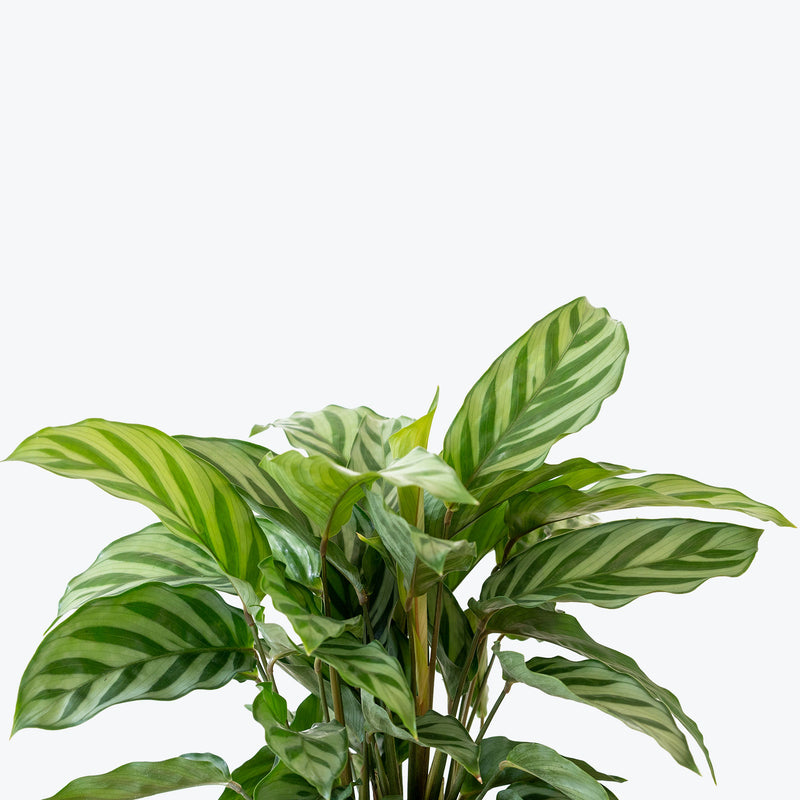
How to care for Calathea Freddie
They should not be in a position to see the sun directly, although early morning or late evening sun is fine. Filtered sunlight through a sheer curtain is best and most homes are comprised primarily of indirect sunlight. The best spot for them is where they do not see the sun during the majority of the day but still get bright, indirect light.
They will thrive in bright light, but also can tolerate medium light. A good medium-light place in your home would be in the middle of a room that has a regular size window. They can be placed anywhere between the middle of the room and the window. Remember that plants will grow based on how much light they receive.
They need to be watered when the top half of the soil is dry to the touch. That usually takes about 1 week in an average home environment. It will vary depending on the time of year, your environment and lighting conditions, but it's always safer to underwater or give the soil a check before you water again.
They like a high humidity environment, give them a mist daily or as often as possible. Alternatively, you can put them around a humidifier. Although they won't die if they don't receive enough humidity, their leaves may have some dry, crunchy, or yellow edges.
Although Calathea's are known as the divas of the plant world, once they are in the right environment, the payoff is phenomenal. No two leaves are alike and the colours that occur through all the varieties in the family are bold and beautiful. Keep in a highly humid environment with lots of bright, indirect light (no direct sun), watering only with distilled or rain water. Once this is achieved, you will sit and stare at your new plant for hours!
You can feel comfortable having this plant around your home in the potential case where your pet feels like nibbling on it. However, we typically recommend keeping your pets from eating any of your houseplants..
Learn MoreView PlantCalathea Green Goddess
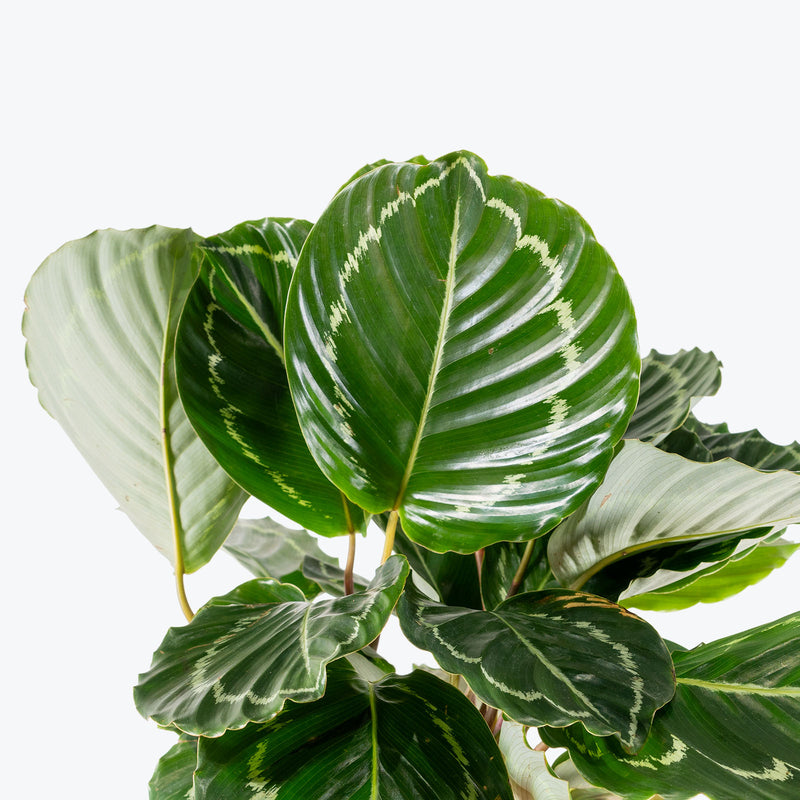
How to care for Calathea Green Goddess
Calathea Green Goddess should not be in a position to see the sun directly, although early morning or late evening sun is fine. Filtered sunlight through a sheer curtain is best and most homes are comprised primarily of indirect sunlight. The best spot for them is where they do not see the sun during the majority of the day but still get bright, indirect light.
Calathea Green Goddess will thrive in bright light, but also can tolerate medium light. A good medium-light place in your home would be in the middle of a room that has a regular size window. They can be placed anywhere between the middle of the room and the window. Remember that plants will grow based on how much light they receive.
Calathea Green Goddess needs to be watered when the top half of the soil is dry to the touch. That usually takes about 1 week in an average home environment. It will vary depending on the time of year, your environment and lighting conditions, but it's always safer to underwater or give the soil a check before you water again.
Calathea Green Goddess likes a high humidity environment, give them a mist daily or as often as possible. Alternatively, you can put them around a humidifier. Although they won't die if they don't receive enough humidity, their leaves may have some dry, crunchy, or yellow edges.
Although Calathea's are known as the divas of the plant world, once they are in the right environment, the payoff is phenomenal. No two leaves are alike and the colours that occur through all the varieties in the family are bold and beautiful. Keep Calathea Green Goddess in a highly humid environment with lots of bright, indirect light (no direct sun), watering only with distilled or rain water. Once this is achieved, you will sit and stare at your new plant for hours!
You can feel comfortable having Calathea Green Goddess around your home in the potential case where your pet feels like nibbling on it. However, we typically recommend keeping your pets from eating any of your houseplants..
Learn MoreView PlantCalathea Lancifolia Rattlesnake
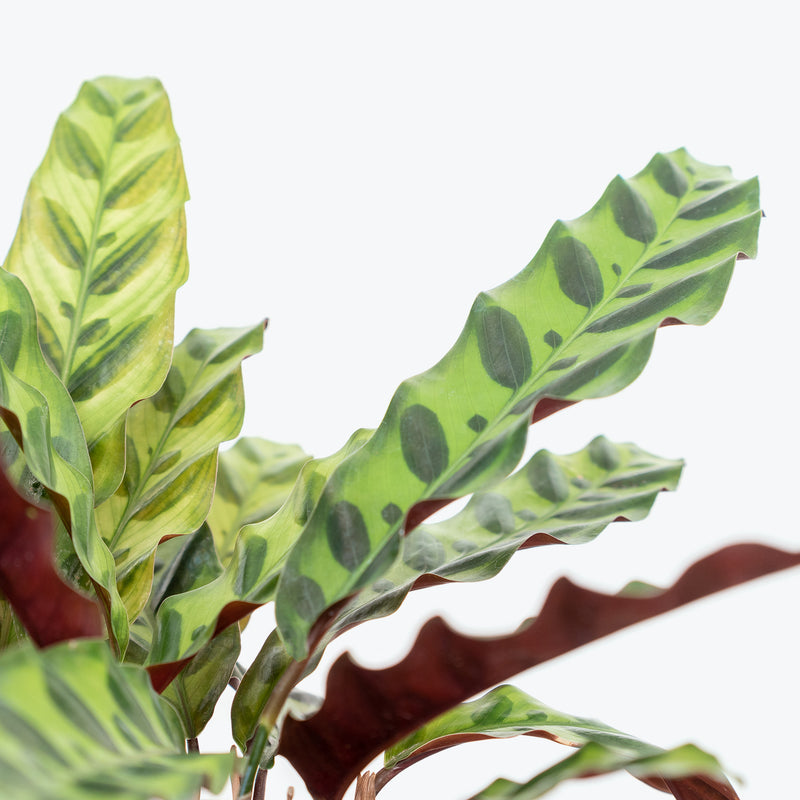
How to care for Calathea Lancifolia Rattlesnake
Calathea Lancifolia Rattlesnake should not be in a position to see the sun directly, although early morning or late evening sun is fine. Filtered sunlight through a sheer curtain is best and most homes are comprised primarily of indirect sunlight. The best spot for them is where they do not see the sun during the majority of the day but still get bright, indirect light.
Calathea Lancifolia Rattlesnake will thrive in bright light, but also can tolerate medium light. A good medium-light place in your home would be in the middle of a room that has a regular size window. They can be placed anywhere between the middle of the room and the window. Remember that plants will grow based on how much light they receive.
Calathea Lancifolia Rattlesnake need to be watered when the top half of the soil is dry to the touch. That usually takes about 1 week in an average home environment. It will vary depending on the time of year, your environment and lighting conditions, but it's always safer to underwater or give the soil a check before you water again.
Calathea Lancifolia Rattlesnake likes a high humidity environment, give them a mist daily or as often as possible. Alternatively, you can put them around a humidifier. Although they won't die if they don't receive enough humidity, their leaves may have some dry, crunchy, or yellow edges.
Although Calathea's are known as the divas of the plant world, once they are in the right environment, the payoff is phenomenal. No two leaves are alike and the colours that occur through all the varieties in the family are bold and beautiful. Keep in a highly humid environment with lots of bright, indirect light (no direct sun), watering only with distilled or rain water. Once this is achieved, you will sit and stare at your Calathea Lancifolia Rattlesnake for hours!
You can feel comfortable having Calathea Lancifolia Rattlesnake around your home in the potential case where your pet feels like nibbling on it. However, we typically recommend keeping your pets from eating any of your houseplants..
Learn MoreView PlantCalathea Leopardina
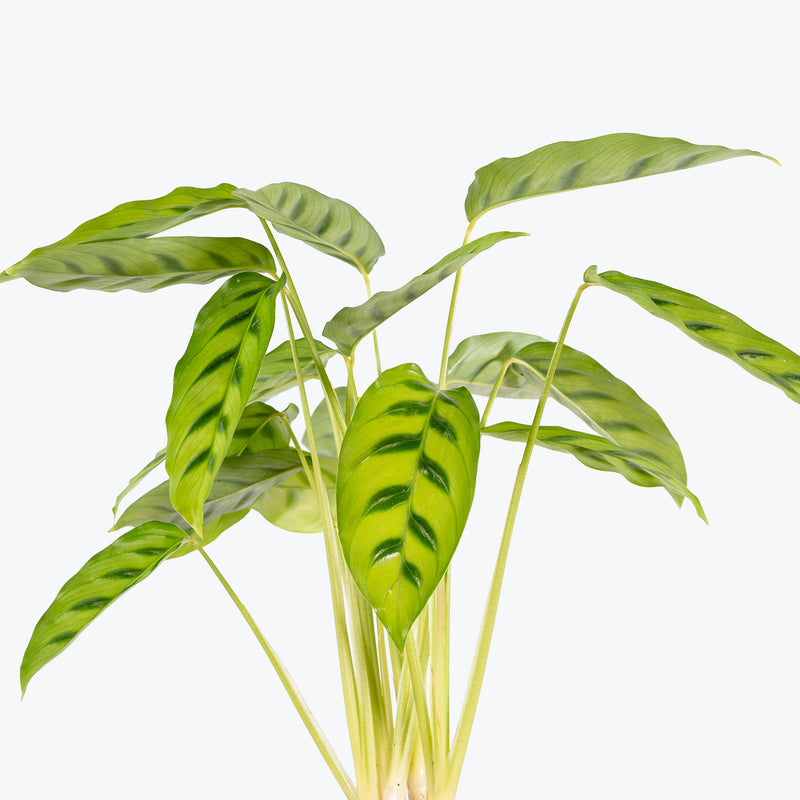
How to care for Calathea Leopardina
Calathea Leopardina should not be in a position to see the sun directly, although early morning or late evening sun is fine. Filtered sunlight through a sheer curtain is best and most homes are comprised primarily of indirect sunlight. The best spot for them is where they do not see the sun during the majority of the day but still get bright, indirect light.
Calathea Leopardina will thrive in bright light, but also can tolerate medium light. A good medium-light place in your home would be in the middle of a room that has a regular size window. They can be placed anywhere between the middle of the room and the window. Remember that plants will grow based on how much light they receive.
Calathea Leopardina needs to be watered when the top half of the soil is dry to the touch. That usually takes about 1 week in an average home environment. It will vary depending on the time of year, your environment and lighting conditions, but it's always safer to underwater or give the soil a check before you water again.
Calathea Leopardina likes a high humidity environment, give them a mist daily or as often as possible. Alternatively, you can put them around a humidifier. Although they won't die if they don't receive enough humidity, their leaves may have some dry, crunchy, or yellow edges.
Although Calathea's are known as the divas of the plant world, once they are in the right environment, the payoff is phenomenal. No two leaves are alike and the colours that occur through all the varieties in the family are bold and beautiful. Keep Calathea Leopardina in a highly humid environment with lots of bright, indirect light (no direct sun), watering only with distilled or rain water. Use a light, well-draining potting mix with good moisture retention (such as peat, perlite, and coco coir). Feed monthly during the growing season with a diluted, balanced fertilizer. Keep away from cold drafts and dry air, which can cause crispy leaf edges. Watch its nightly leaf movement for a healthy sign of a happy Calathea!
You can feel comfortable having Calathea Leopardina around your home in the potential case where your pet feels like nibbling on it. However, we typically recommend keeping your pets from eating any of your houseplants..
Learn MoreView PlantCalathea Little Princess

How to care for Calathea Little Princess
They should not be in a position to see the sun directly, although early morning or late evening sun is fine. Filtered sunlight through a sheer curtain is best and most homes are comprised primarily of indirect sunlight. The best spot for them is where they do not see the sun during the majority of the day but still get bright, indirect light.
They will thrive in bright light, but also can tolerate medium light. A good medium-light place in your home would be in the middle of a room that has a regular size window. They can be placed anywhere between the middle of the room and the window. Remember that plants will grow based on how much light they receive.
They need to be watered when the top half of the soil is dry to the touch. That usually takes about 1 week in an average home environment. It will vary depending on the time of year, your environment and lighting conditions, but it's always safer to underwater or give the soil a check before you water again. Expect to water more often in brighter light and less often in lower light.
They like a high humidity environment, give them a mist daily or as often as possible. Alternatively, you can put them around a humidifier. Although they won't die if they don't receive enough humidity, their leaves may have some dry, crunchy, or yellow edges.
Although Calathea's are known as the divas of the plant world, once they are in the right environment, the payoff is phenomenal. No two leaves are alike and the colours that occur through all the varieties in the family are bold and beautiful. Keep in a highly humid environment with lots of bright, indirect light (no prolonged afternoon sun), watering only with distilled or rain water. Once this is achieved, you will sit and stare at your new plant for hours!
You can feel comfortable having this plant around your home in the potential case where your pet feels like nibbling on it. However, we typically recommend keeping your pets from eating any of your houseplants..
Learn MoreView PlantCalathea Majestica White Star
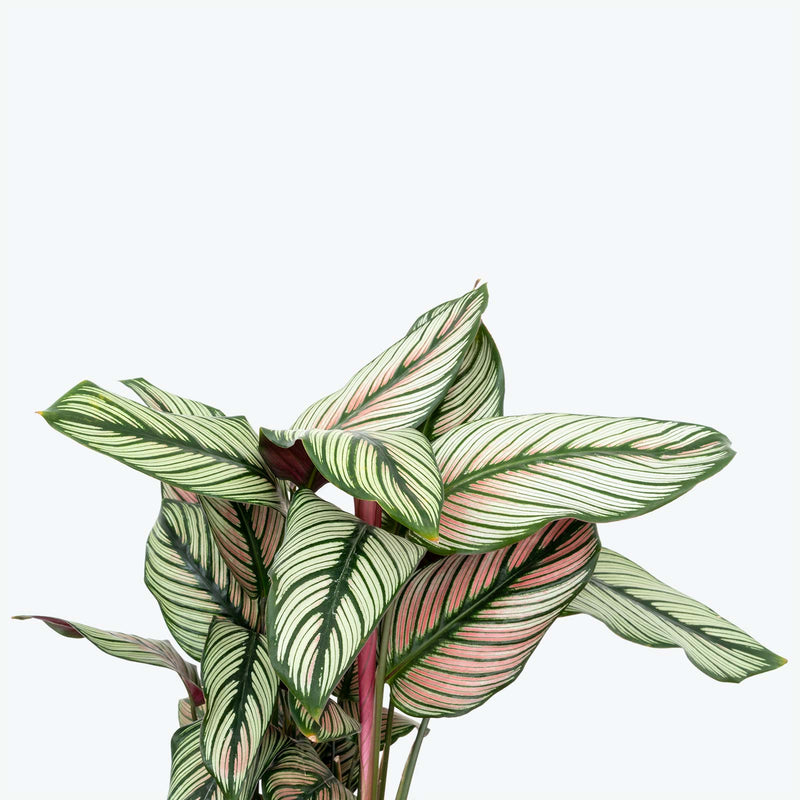
How to care for Calathea Majestica White Star
They should not be in a position to see the sun directly, although early morning or late evening sun is fine. Filtered sunlight through a sheer curtain is best and most homes are comprised primarily of indirect sunlight. The best spot for them is where they do not see the sun during the majority of the day but still get bright, indirect light.
They will thrive in bright light, but also can tolerate medium light. A good medium-light place in your home would be in the middle of a room that has a regular size window. They can be placed anywhere between the middle of the room and the window. Remember that plants will grow based on how much light they receive.
They need to be watered when the top half of the soil is dry to the touch. That usually takes about 1 week in an average home environment. It will vary depending on the time of year, your environment and lighting conditions, but it's always safer to underwater or give the soil a check before you water again.
They like a high humidity environment, give them a mist daily or as often as possible. Alternatively, you can put them around a humidifier. Although they won't die if they don't receive enough humidity, their leaves may have some dry, crunchy, or yellow edges.
Although Calathea's are known as the divas of the plant world, once they are in the right environment, the payoff is phenomenal. No two leaves are alike and the colours that occur through all the varieties in the family are bold and beautiful. Keep in a highly humid environment with lots of bright, indirect light (no direct sun), watering only with distilled or rain water. Once this is achieved, you will sit and stare at your new plant for hours!
You can feel comfortable having this plant around your home in the potential case where your pet feels like nibbling on it. However, we typically recommend keeping your pets from eating any of your houseplants..
Learn MoreView PlantCalathea Makoyana Peacock
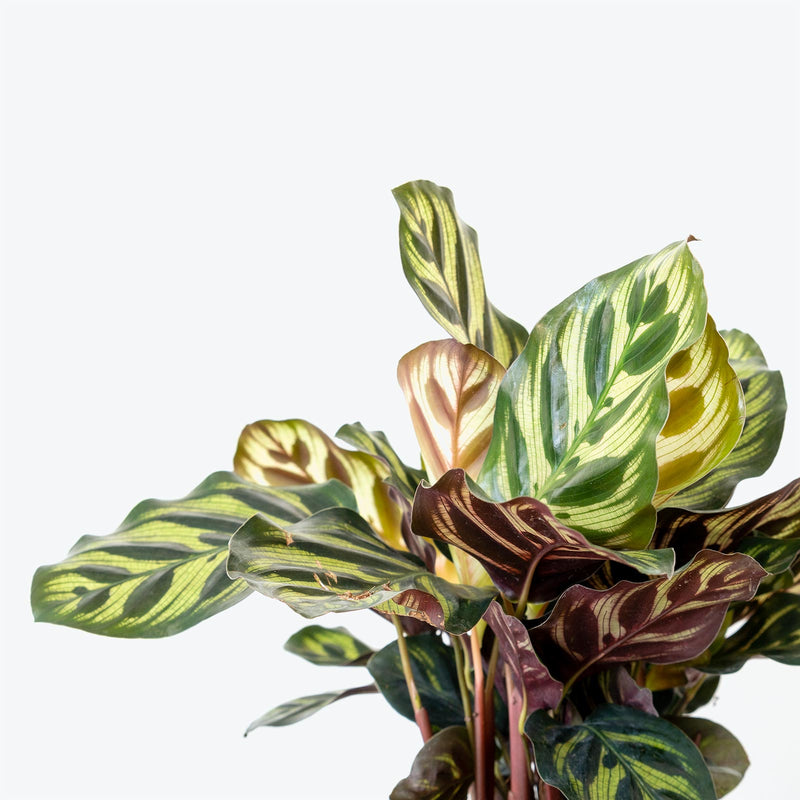
How to care for Calathea Makoyana Peacock
Calathea Makoyana Peacock should not be in a position to see the sun directly, although early morning or late evening sun is fine. Filtered sunlight through a sheer curtain is best and most homes are comprised primarily of indirect sunlight. The best spot for them is where they do not see the sun during the majority of the day but still get bright, indirect light.
Calathea Makoyana Peacock will thrive in bright light, but also can tolerate medium light. A good medium-light place in your home would be in the middle of a room that has a regular size window. They can be placed anywhere between the middle of the room and the window. Remember that plants will grow based on how much light they receive.
Calathea Makoyana Peacock needs to be watered when the top half of the soil is dry to the touch. That usually takes about 1 week in an average home environment. It will vary depending on the time of year, your environment and lighting conditions, but it's always safer to underwater or give the soil a check before you water again.
Calathea Makoyana Peacock likes a high humidity environment, give them a mist daily or as often as possible. Alternatively, you can put them around a humidifier. Although they won't die if they don't receive enough humidity, their leaves may have some dry, crunchy, or yellow edges.
Although Calathea's are known as the divas of the plant world, once they are in the right environment, the payoff is phenomenal. No two leaves are alike and the colours that occur through all the varieties in the family are bold and beautiful. Keep in a highly humid environment with lots of bright, indirect light (no direct sun), watering only with distilled or rainwater. Once this is achieved, you will sit and stare at your Calathea Makoyana Peacock for hours!
You can feel comfortable having Calathea Makoyana Peacock around your home in the potential case where your pet feels like nibbling on it. However, we typically recommend keeping your pets from eating any of your houseplants..
Learn MoreView PlantCalathea Marion
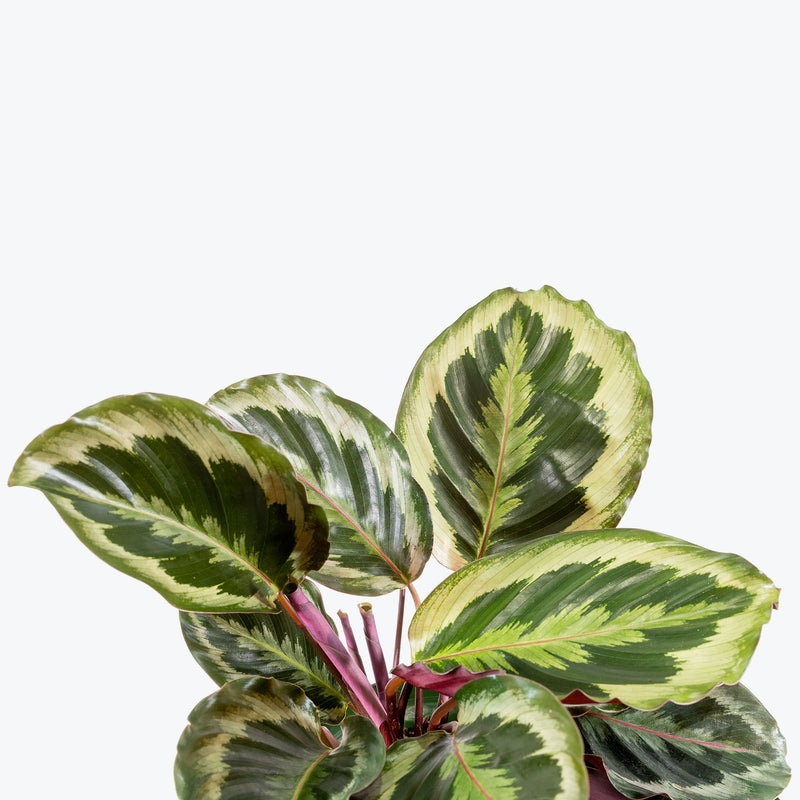
How to care for Calathea Marion
They should not be in a position to see the sun directly, although early morning or late evening sun is fine. Filtered sunlight through a sheer curtain is best and most homes are comprised primarily of indirect sunlight. The best spot for them is where they do not see the sun during the majority of the day but still get bright, indirect light.
They will thrive in bright light, but also can tolerate medium light. A good medium-light place in your home would be in the middle of a room that has a regular size window. They can be placed anywhere between the middle of the room and the window. Remember that plants will grow based on how much light they receive.
They need to be watered when the top half of the soil is dry to the touch. That usually takes about 1 week in an average home environment. It will vary depending on the time of year, your environment and lighting conditions, but it's always safer to underwater or give the soil a check before you water again.
They like a high humidity environment, give them a mist daily or as often as possible. Alternatively, you can put them around a humidifier. Although they won't die if they don't receive enough humidity, their leaves may have some dry, crunchy, or yellow edges.
Although Calathea's are known as the divas of the plant world, once they are in the right environment, the payoff is phenomenal. No two leaves are alike and the colours that occur through all the varieties in the family are bold and beautiful. Keep in a highly humid environment with lots of bright, indirect light (no direct sun), watering only with distilled or rain water. Once this is achieved, you will sit and stare at your new plant for hours!
You can feel comfortable having this plant around your home in the potential case where your pet feels like nibbling on it. However, we typically recommend keeping your pets from eating any of your houseplants..
Learn MoreView PlantCalathea Maui Queen
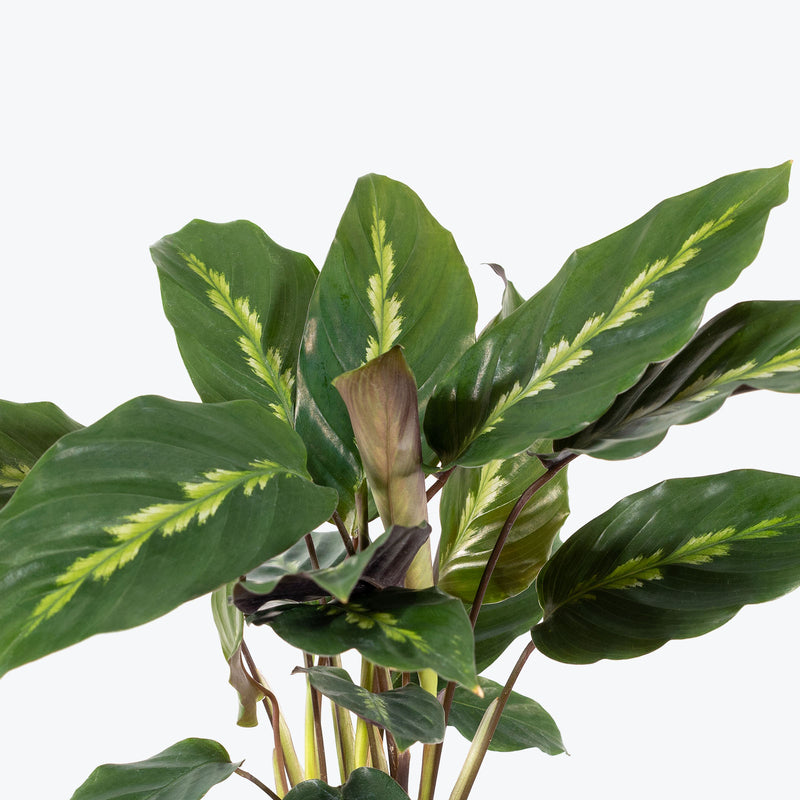
How to care for Calathea Maui Queen
They should not be in a position to see the sun directly, although early morning or late evening sun is fine. Filtered sunlight through a sheer curtain is best and most homes are comprised primarily of indirect sunlight. The best spot for them is where they do not see the sun during the majority of the day but still get bright, indirect light.
They will thrive in bright light, but also can tolerate medium light. A good medium-light place in your home would be in the middle of a room that has a regular size window. They can be placed anywhere between the middle of the room and the window. Remember that plants will grow based on how much light they receive.
They need to be watered when the top half of the soil is dry to the touch. That usually takes about 1 week in an average home environment. It will vary depending on the time of year, your environment and lighting conditions, but it's always safer to underwater or give the soil a check before you water again.
They like a high humidity environment, give them a mist daily or as often as possible. Alternatively, you can put them around a humidifier. Although they won't die if they don't receive enough humidity, their leaves may have some dry, crunchy, or yellow edges.
Although Calathea's are known as the divas of the plant world, once they are in the right environment, the payoff is phenomenal. No two leaves are alike and the colours that occur through all the varieties in the family are bold and beautiful. Keep in a highly humid environment with lots of bright, indirect light (no direct sun), watering only with distilled or rain water. Once this is achieved, you will sit and stare at your new plant for hours!
You can feel comfortable having this plant around your home in the potential case where your pet feels like nibbling on it. However, we typically recommend keeping your pets from eating any of your houseplants..
Learn MoreView PlantCalathea Medallion
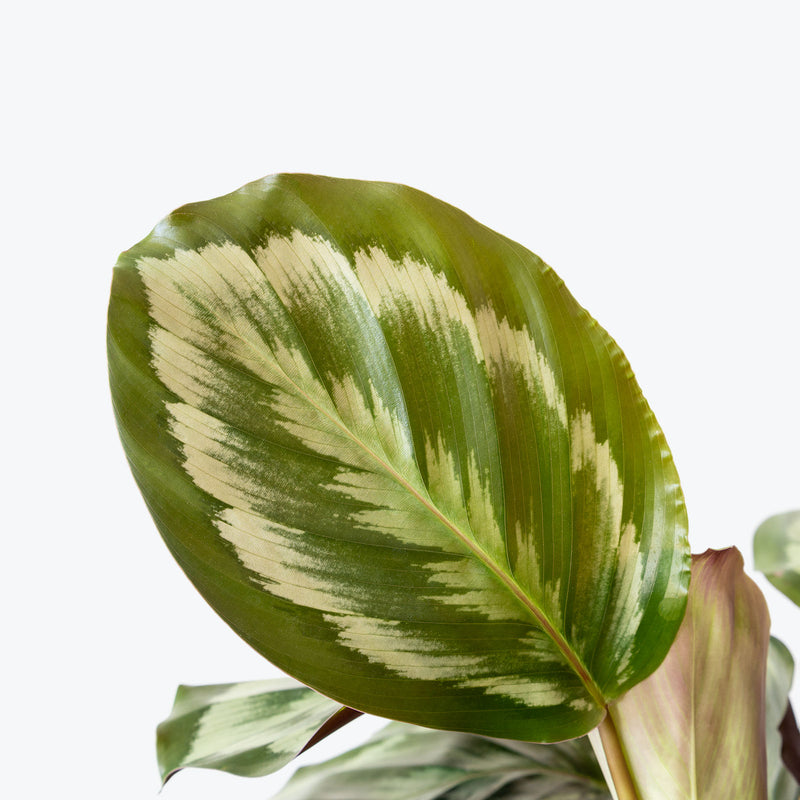
How to care for Calathea Medallion
They should not be in a position to the see the sun directly, as it is too intense for them. Filtered sunlight through a sheer curtain is fine and most homes are comprised primarily of indirect sunlight. The best spot for them is where they do not see the sun during the majority of the day but still get bright, indirect light.
They will thrive in bright light, but also can tolerate medium light. A good medium-light place in your home would be in the middle of a room that has a regular size window. They can be placed anywhere between the middle of the room and the window. Remember that plants will grow based on how much light they receive.
They need to be watered when the top half of soil is dry to the touch. That usually takes about 1 week in an average home environment. It may vary depending on the time of year, your environment and lighting conditions, but it's always safer to give the soil a check before you water again.
They like a high humidity environment, give them a mist daily or as often as possible. Alternatively, you can put them around a humidifier. Although they won't die if they don't receive enough humidity, their leaves may have some dry, crunchy, or yellow edges.
Although Calathea's are known as the divas of the plant world, once they are in the right environment, the payoff is phenomenal. No two leaves are alike and the colours that occur through all the varieties in the family are bold and beautiful. Keep in a highly humid environment with lots of bright, indirect light, watering only with distilled or rain water. Once this is achieved, you will sit and stare at your new plant for hours!
You can feel comfortable having this plant around your home in the potential case where your pet feels like nibbling on it. However, we typically recommend keeping your pets from eating any of your houseplants..
Learn MoreView PlantCalathea Misto

How to care for Calathea Misto
They should not be in a position to see the sun directly, although early morning or late evening sun is fine. Filtered sunlight through a sheer curtain is best and most homes are comprised primarily of indirect sunlight. The best spot for them is where they do not see the sun during the majority of the day but still get bright, indirect light.
They will do well in medium light but will grow faster with brighter light. A good medium-light place in your home would be in the middle of a room that has a regular size window. Remember that plants will grow based on how much light they receive.
They need to be watered when the top half of the soil is dry to the touch. That usually takes about 1 week in an average home environment. It will vary depending on the time of year, your environment and lighting conditions, but it's always safer to underwater or give the soil a check before you water again. Expect to water more often in brighter light and less often in lower light.
They like a high humidity environment, give them a mist daily or as often as possible. Alternatively, you can put them around a humidifier. Although they won't die if they don't receive enough humidity, their leaves may have some dry, crunchy, or yellow edges.
Although Calathea's are known as the divas of the plant world, once they are in the right environment, the payoff is phenomenal. No two leaves are alike and the colours that occur through all the varieties in the family are bold and beautiful. Keep in a highly humid environment with lots of bright, indirect light (no direct sun), watering only with distilled or rainwater.
You can feel comfortable having this plant around your home in the potential case where your pet feels like nibbling on it. However, we typically recommend keeping your pets from eating any of your houseplants..
Learn MoreView PlantCalathea Network
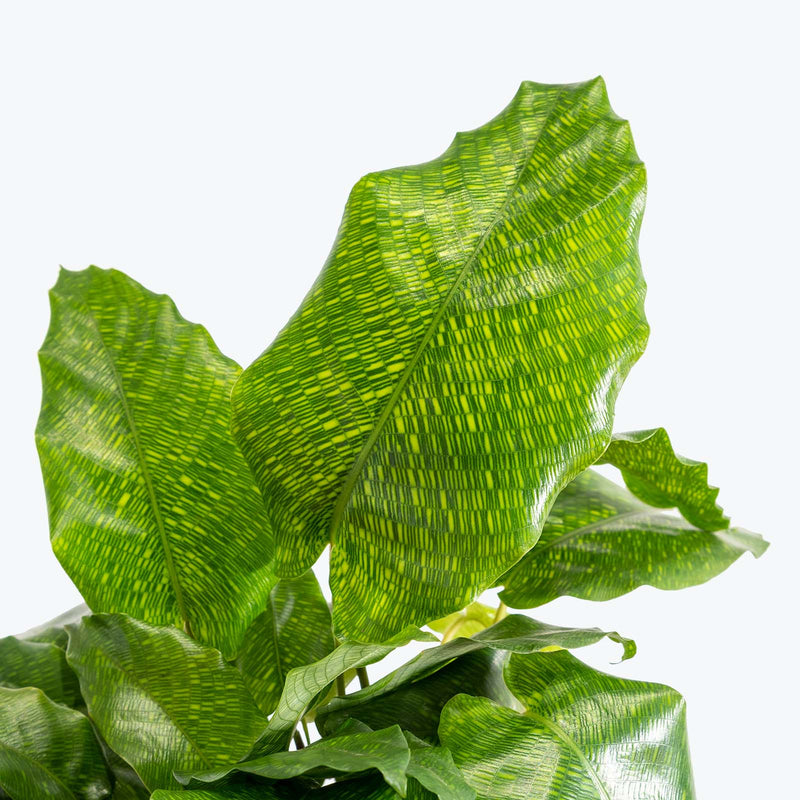
How to care for Calathea Network
They should not be in a position to see the sun directly, although early morning or late evening sun is fine. Filtered sunlight through a sheer curtain is best and most homes are comprised primarily of indirect sunlight. The best spot for them is where they do not see the sun during the majority of the day but still get bright, indirect light.
They will thrive in bright light, but also can tolerate medium light. A good medium-light place in your home would be in the middle of a room that has a regular size window. They can be placed anywhere between the middle of the room and the window. Remember that plants will grow based on how much light they receive.
They need to be watered when the top half of the soil is dry to the touch. That usually takes about 1 week in an average home environment. It will vary depending on the time of year, your environment and lighting conditions, but it's always safer to underwater or give the soil a check before you water again.
They like a high humidity environment, give them a mist daily or as often as possible. Alternatively, you can put them around a humidifier. Although they won't die if they don't receive enough humidity, their leaves may have some dry, crunchy, or yellow edges.
Although Calathea's are known as the divas of the plant world, once they are in the right environment, the payoff is phenomenal. No two leaves are alike and the colours that occur through all the varieties in the family are bold and beautiful. Keep in a highly humid environment with lots of bright, indirect light (no direct sun), watering only with distilled or rain water. Once this is achieved, you will sit and stare at your new plant for hours!
You can feel comfortable having this plant around your home in the potential case where your pet feels like nibbling on it. However, we typically recommend keeping your pets from eating any of your houseplants..
Learn MoreView PlantCalathea Orbifolia
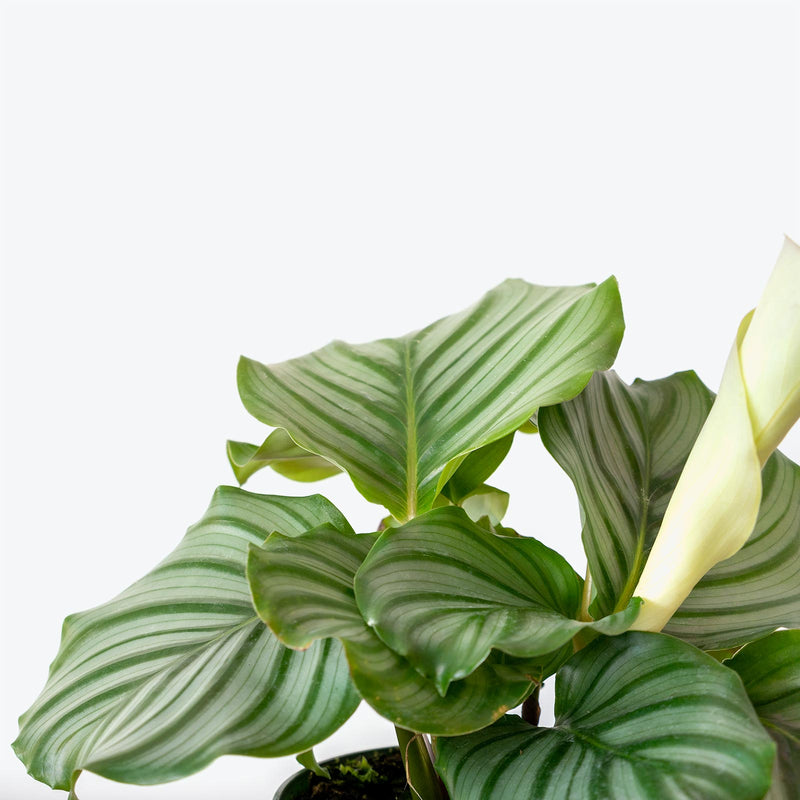
How to care for Calathea Orbifolia
Calathea Orbifolia should not be in a position to see the sun directly, although early morning or late evening sun is fine. Filtered sunlight through a sheer curtain is best and most homes are comprised primarily of indirect sunlight. The best spot for them is where they do not see the sun during the majority of the day but still get bright, indirect light.
Calathea Orbifolia will thrive in bright light, but also can tolerate medium light. A good medium-light place in your home would be in the middle of a room that has a regular size window. They can be placed anywhere between the middle of the room and the window. Remember that plants will grow based on how much light they receive.
Calathea Orbifolia needs to be watered when the top half of the soil is dry to the touch. That usually takes about 1 week in an average home environment. It will vary depending on the time of year, your environment and lighting conditions, but it's always safer to underwater or give the soil a check before you water again.
Calathea Orbifolia likes a high humidity environment, give them a mist daily or as often as possible. Alternatively, you can put them around a humidifier. Although they won't die if they don't receive enough humidity, their leaves may have some dry, crunchy, or yellow edges.
Although Calathea's are known as the divas of the plant world, once they are in the right environment, the payoff is phenomenal. No two leaves are alike and the colours that occur through all the varieties in the family are bold and beautiful. Keep in a highly humid environment with lots of bright, indirect light (no direct sun), watering only with distilled or rain water. Once this is achieved, you will sit and stare at your Calathea Orbifolia for hours!
You can feel comfortable having Calathea Orbifolia around your home in the potential case where your pet feels like nibbling on it. However, we typically recommend keeping your pets from eating any of your houseplants..
Learn MoreView PlantCalathea Ornata Pinstripe
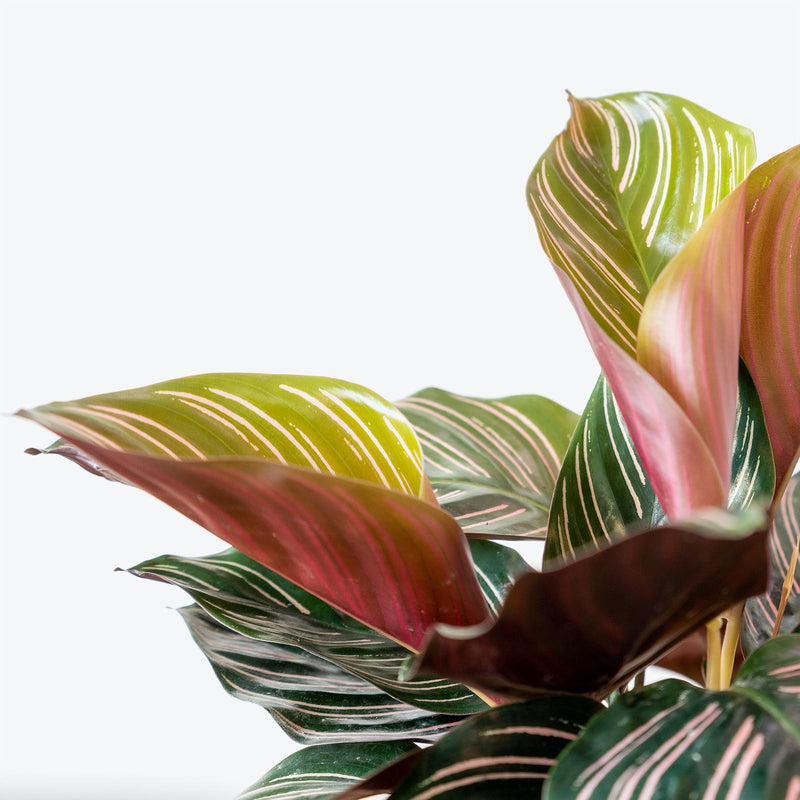
How to care for Calathea Ornata Pinstripe
Calathea Ornata Pinstripe should not be in a position to see the sun directly, although early morning or late evening sun is fine. Filtered sunlight through a sheer curtain is best and most homes are comprised primarily of indirect sunlight. The best spot for them is where they do not see the sun during the majority of the day but still get bright, indirect light.
Calathea Ornata Pinstripe will thrive in bright light, but also can tolerate medium light. A good medium-light place in your home would be in the middle of a room that has a regular size window. They can be placed anywhere between the middle of the room and the window. Remember that plants will grow based on how much light they receive.
Calathea Ornata Pinstripe needs to be watered when the top half of the soil is dry to the touch. That usually takes about 1 week in an average home environment. It will vary depending on the time of year, your environment and lighting conditions, but it's always safer to underwater or give the soil a check before you water again.
Calathea Ornata Pinstripe likes a high humidity environment, give them a mist daily or as often as possible. Alternatively, you can put them around a humidifier. Although they won't die if they don't receive enough humidity, their leaves may have some dry, crunchy, or yellow edges.
Although Calathea's are known as the divas of the plant world, once they are in the right environment, the payoff is phenomenal. No two leaves are alike and the colours that occur through all the varieties in the family are bold and beautiful. Keep in a highly humid environment with lots of bright, indirect light (no direct sun), watering only with distilled or rainwater. Once this is achieved, you will sit and stare at your Calathea Ornata Pinstripe for hours!
You can feel comfortable having Calathea Ornata Pinstripe around your home in the potential case where your pet feels like nibbling on it. However, we typically recommend keeping your pets from eating any of your houseplants..
Learn MoreView PlantCalathea Rosea Picta
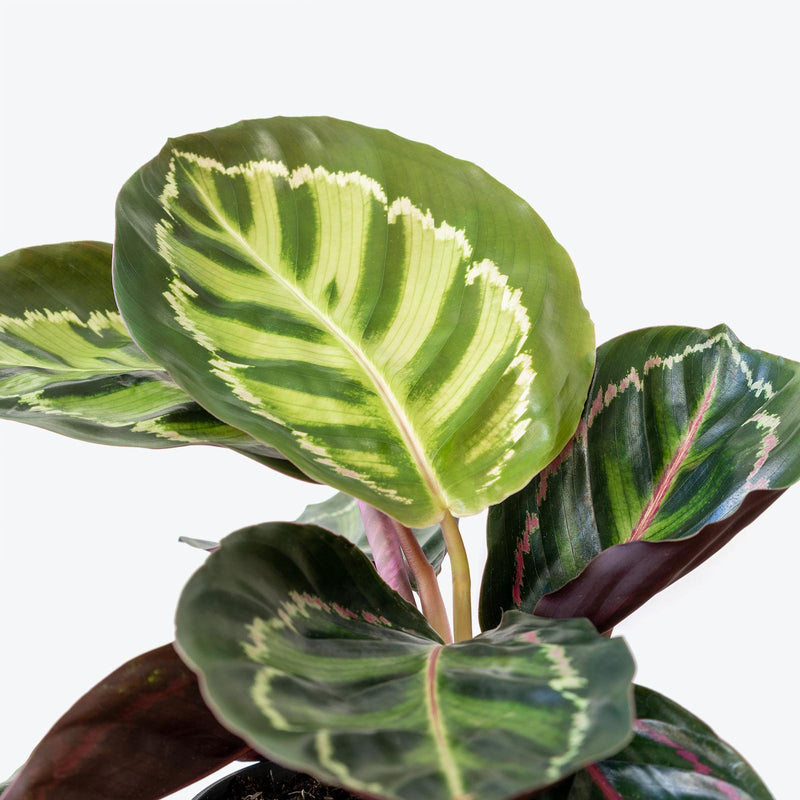
How to care for Calathea Rosea Picta
They should not be in a position to see the sun directly, although early morning or late evening sun is fine. Filtered sunlight through a sheer curtain is best and most homes are comprised primarily of indirect sunlight. The best spot for them is where they do not see the sun during the majority of the day but still get bright, indirect light.
They will thrive in bright light, but also can tolerate medium light. A good medium-light place in your home would be in the middle of a room that has a regular size window. They can be placed anywhere between the middle of the room and the window. Remember that plants will grow based on how much light they receive.
They need to be watered when the top half of the soil is dry to the touch. That usually takes about 1 week in an average home environment. It will vary depending on the time of year, your environment and lighting conditions, but it's always safer to underwater or give the soil a check before you water again.
They like a high humidity environment, give them a mist daily or as often as possible. Alternatively, you can put them around a humidifier. Although they won't die if they don't receive enough humidity, their leaves may have some dry, crunchy, or yellow edges.
Although Calathea's are known as the divas of the plant world, once they are in the right environment, the payoff is phenomenal. No two leaves are alike and the colours that occur through all the varieties in the family are bold and beautiful. Keep in a highly humid environment with lots of bright, indirect light (no direct sun), watering only with distilled or rain water. Once this is achieved, you will sit and stare at your new plant for hours!
You can feel comfortable having this plant around your home in the potential case where your pet feels like nibbling on it. However, we typically recommend keeping your pets from eating any of your houseplants..
Learn MoreView PlantCalathea Roseopicta Cora
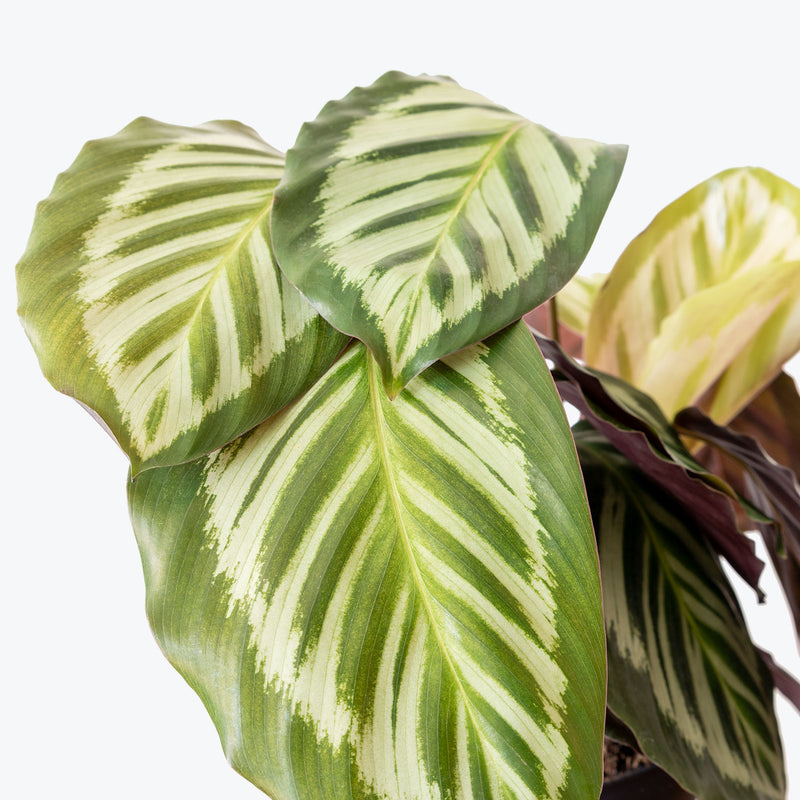
How to care for Calathea Roseopicta Cora
They should not be in a position to see the sun directly, although early morning or late evening sun is fine. Filtered sunlight through a sheer curtain is best and most homes are comprised primarily of indirect sunlight. The best spot for them is where they do not see the sun during the majority of the day but still get bright, indirect light.
They will thrive in bright light, but also can tolerate medium light. A good medium-light place in your home would be in the middle of a room that has a regular size window. They can be placed anywhere between the middle of the room and the window. Remember that plants will grow based on how much light they receive.
They need to be watered when the top half of the soil is dry to the touch. That usually takes about 1 week in an average home environment. It will vary depending on the time of year, your environment and lighting conditions, but it's always safer to underwater or give the soil a check before you water again.
They like a high humidity environment, give them a mist daily or as often as possible. Alternatively, you can put them around a humidifier. Although they won't die if they don't receive enough humidity, their leaves may have some dry, crunchy, or yellow edges.
Although Calathea's are known as the divas of the plant world, once they are in the right environment, the payoff is phenomenal. No two leaves are alike and the colours that occur through all the varieties in the family are bold and beautiful. Keep in a highly humid environment with lots of bright, indirect light (no direct sun), watering only with distilled or rain water. Once this is achieved, you will sit and stare at your new plant for hours!
You can feel comfortable having this plant around your home in the potential case where your pet feels like nibbling on it. However, we typically recommend keeping your pets from eating any of your houseplants..
Learn MoreView PlantCalathea Roseopicta Corona
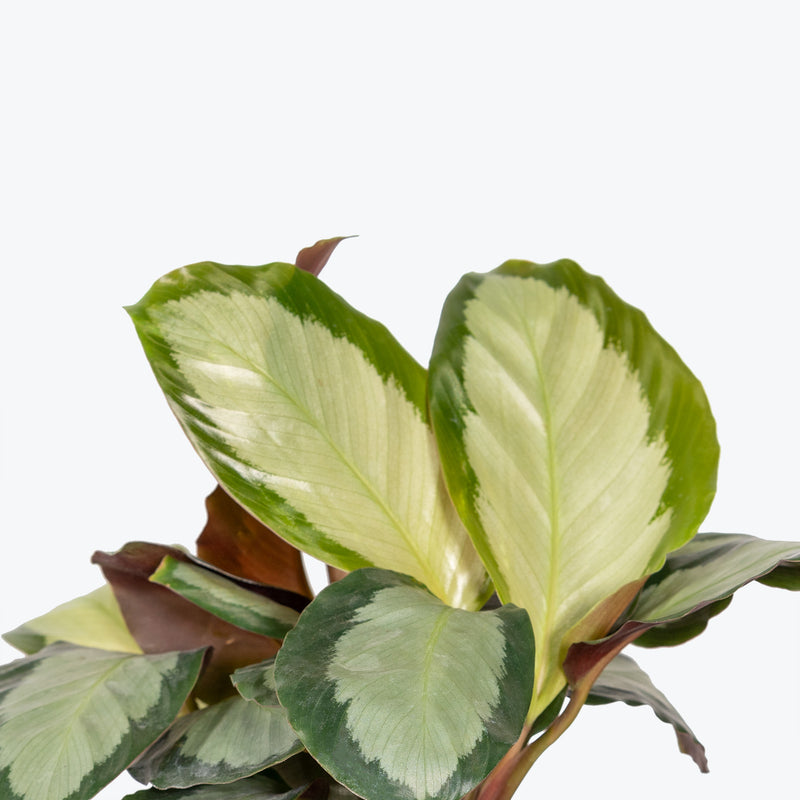
How to care for Calathea Roseopicta Corona
They should not be in a position to see the sun directly, although early morning or late evening sun is fine. Filtered sunlight through a sheer curtain is best and most homes are comprised primarily of indirect sunlight. The best spot for them is where they do not see the sun during the majority of the day but still get bright, indirect light.
They will thrive in bright light, but also can tolerate medium light. A good medium-light place in your home would be in the middle of a room that has a regular size window. They can be placed anywhere between the middle of the room and the window. Remember that plants will grow based on how much light they receive.
They need to be watered when the top half of the soil is dry to the touch. That usually takes about 1 week in an average home environment. It will vary depending on the time of year, your environment and lighting conditions, but it's always safer to underwater or give the soil a check before you water again.
They like a high humidity environment, give them a mist daily or as often as possible. Alternatively, you can put them around a humidifier. Although they won't die if they don't receive enough humidity, their leaves may have some dry, crunchy, or yellow edges.
Although Calathea's are known as the divas of the plant world, once they are in the right environment, the payoff is phenomenal. No two leaves are alike and the colours that occur through all the varieties in the family are bold and beautiful. Keep in a highly humid environment with lots of bright, indirect light (no direct sun), watering only with distilled or rain water. Once this is achieved, you will sit and stare at your new plant for hours!
You can feel comfortable having this plant around your home in the potential case where your pet feels like nibbling on it. However, we typically recommend keeping your pets from eating any of your houseplants..
Learn MoreView PlantCalathea Rosy

How to care for Calathea Rosy
They should not be in a position to see the sun directly, although early morning or late evening sun is fine. Filtered sunlight through a sheer curtain is best and most homes are comprised primarily of indirect sunlight. The best spot for them is where they do not see the sun during the majority of the day but still get bright, indirect light.
They will thrive in bright light, but also can tolerate medium light. A good medium-light place in your home would be in the middle of a room that has a regular size window. They can be placed anywhere between the middle of the room and the window. Remember that plants will grow based on how much light they receive.
They need to be watered when the top half of the soil is dry to the touch. That usually takes about 1 week in an average home environment. It will vary depending on the time of year, your environment and lighting conditions, but it's always safer to underwater or give the soil a check before you water again.
They like a high humidity environment, give them a mist daily or as often as possible. Alternatively, you can put them around a humidifier. Although they won't die if they don't receive enough humidity, their leaves may have some dry, crunchy, or yellow edges.
Although Calathea's are known as the divas of the plant world, once they are in the right environment, the payoff is phenomenal. No two leaves are alike and the colours that occur through all the varieties in the family are bold and beautiful. Keep in a highly humid environment with lots of bright, indirect light (no direct sun), watering only with distilled or rain water. Once this is achieved, you will sit and stare at your new plant for hours!
You can feel comfortable having this plant around your home in the potential case where your pet feels like nibbling on it. However, we typically recommend keeping your pets from eating any of your houseplants..
Learn MoreView PlantCalathea Rufibarba Velvet

How to care for Calathea Rufibarba Velvet
They should not be in a position to see the sun directly, although early morning or late evening sun is fine. Filtered sunlight through a sheer curtain is best and most homes are comprised primarily of indirect sunlight. The best spot for them is where they do not see the sun during the majority of the day but still get bright, indirect light.
They will thrive in bright light, but also can tolerate medium light. A good medium-light place in your home would be in the middle of a room that has a regular size window. They can be placed anywhere between the middle of the room and the window. Remember that plants will grow based on how much light they receive.
They need to be watered when the top half of the soil is dry to the touch. That usually takes about 1 week in an average home environment. It will vary depending on the time of year, your environment and lighting conditions, but it's always safer to underwater or give the soil a check before you water again.
They like a high humidity environment, give them a mist daily or as often as possible. Alternatively, you can put them around a humidifier. Although they won't die if they don't receive enough humidity, their leaves may have some dry, crunchy, or yellow edges.
Although Calathea's are known as the divas of the plant world, once they are in the right environment, the payoff is phenomenal. No two leaves are alike and the colours that occur through all the varieties in the family are bold and beautiful. Keep in a highly humid environment with lots of bright, indirect light (no direct sun), watering only with distilled or rain water. Once this is achieved, you will sit and stare at your new plant for hours!
You can feel comfortable having this plant around your home in the potential case where your pet feels like nibbling on it. However, we typically recommend keeping your pets from eating any of your houseplants..
Learn MoreView PlantCalathea Vittata
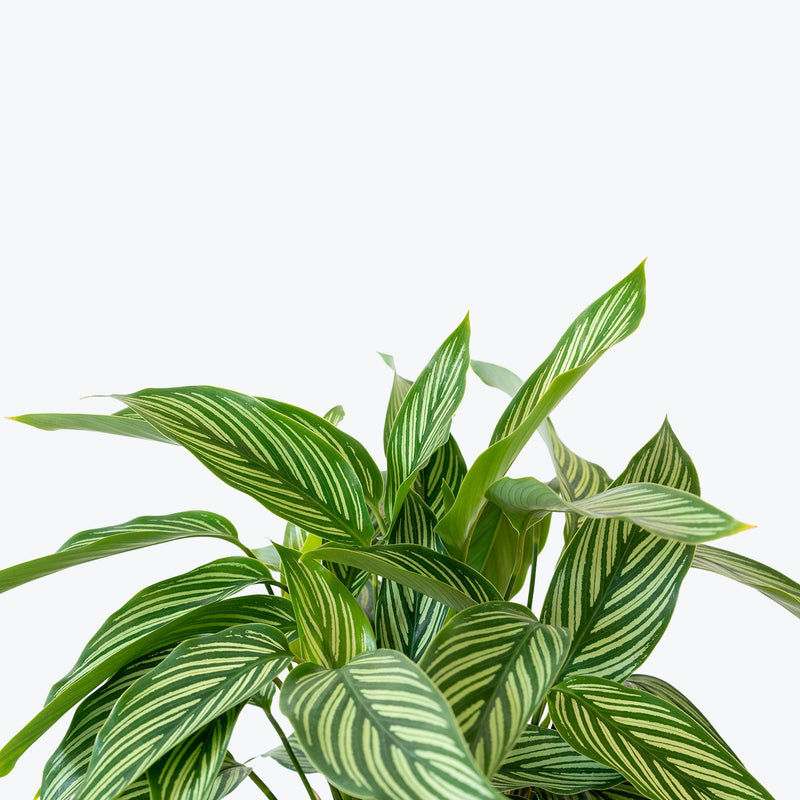
How to care for Calathea Vittata
They should not be in a position to see the sun directly, although early morning or late evening sun is fine. Filtered sunlight through a sheer curtain is best and most homes are comprised primarily of indirect sunlight. The best spot for them is where they do not see the sun during the majority of the day but still get bright, indirect light.
They will thrive in bright light, but also can tolerate medium light. A good medium-light place in your home would be in the middle of a room that has a regular size window. They can be placed anywhere between the middle of the room and the window. Remember that plants will grow based on how much light they receive.
They need to be watered when the top half of the soil is dry to the touch. That usually takes about 1 week in an average home environment. It will vary depending on the time of year, your environment and lighting conditions, but it's always safer to underwater or give the soil a check before you water again.
They like a high humidity environment, give them a mist daily or as often as possible. Alternatively, you can put them around a humidifier. Although they won't die if they don't receive enough humidity, their leaves may have some dry, crunchy, or yellow edges.
Although Calathea's are known as the divas of the plant world, once they are in the right environment, the payoff is phenomenal. No two leaves are alike and the colours that occur through all the varieties in the family are bold and beautiful. Keep in a highly humid environment with lots of bright, indirect light (no direct sun), watering only with distilled or rain water. Once this is achieved, you will sit and stare at your new plant for hours!
You can feel comfortable having this plant around your home in the potential case where your pet feels like nibbling on it. However, we typically recommend keeping your pets from eating any of your houseplants..
Learn MoreView PlantCalathea Warscewiczii
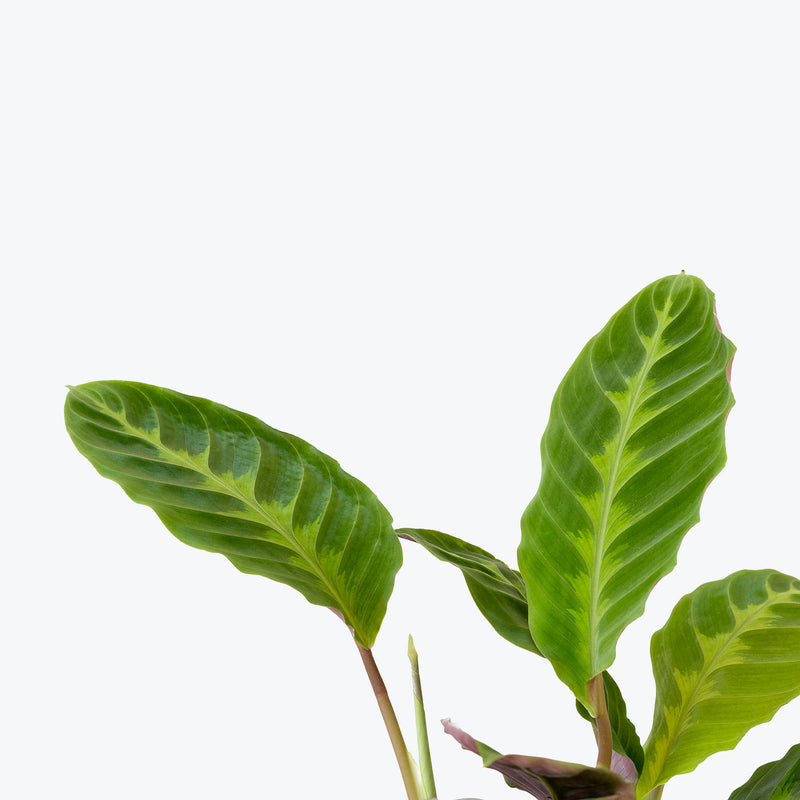
How to care for Calathea Warscewiczii
They should not be in a position to see the sun directly, although early morning or late evening sun is fine. Filtered sunlight through a sheer curtain is best and most homes are comprised primarily of indirect sunlight. The best spot for them is where they do not see the sun during the majority of the day but still get bright, indirect light.
They will thrive in bright light, but also can tolerate medium light. A good medium-light place in your home would be in the middle of a room that has a regular size window. They can be placed anywhere between the middle of the room and the window. Remember that plants will grow based on how much light they receive.
They need to be watered when the top half of the soil is dry to the touch. That usually takes about 1 week in an average home environment. It will vary depending on the time of year, your environment and lighting conditions, but it's always safer to underwater or give the soil a check before you water again.
They like a high humidity environment, give them a mist daily or as often as possible. Alternatively, you can put them around a humidifier. Although they won't die if they don't receive enough humidity, their leaves may have some dry, crunchy, or yellow edges.
Although Calathea's are known as the divas of the plant world, once they are in the right environment, the payoff is phenomenal. No two leaves are alike and the colours that occur through all the varieties in the family are bold and beautiful. Keep in a highly humid environment with lots of bright, indirect light (no direct sun), watering only with distilled or rain water. Once this is achieved, you will sit and stare at your new plant for hours!
You can feel comfortable having this plant around your home in the potential case where your pet feels like nibbling on it. However, we typically recommend keeping your pets from eating any of your houseplants..
Learn MoreView PlantCalathea White Fusion

How to care for Calathea White Fusion
Calathea White Fusion should not be in a position to see the sun directly, although early morning or late evening sun is fine. Filtered sunlight through a sheer curtain is best and most homes are comprised primarily of indirect sunlight. The best spot for them is where they do not see the sun during the majority of the day but still get bright, indirect light.
Calathea White Fusion will thrive in bright light, but also can tolerate medium light. A good medium-light place in your home would be in the middle of a room that has a regular size window. They can be placed anywhere between the middle of the room and the window. Remember that plants will grow based on how much light they receive.
Calathea White Fusion needs to be watered when the top half of the soil is dry to the touch. That usually takes about 1 week in an average home environment. It will vary depending on the time of year, your environment and lighting conditions, but it's always safer to underwater or give the soil a check before you water again.
Calathea White Fusion likes a high humidity environment, give them a mist daily or as often as possible. Alternatively, you can put them around a humidifier. Although they won't die if they don't receive enough humidity, their leaves may have some dry, crunchy, or yellow edges.
Watering Calathea White Fusion only with distilled or rain water. Feed with a diluted liquid fertilizer every 4-6 weeks during the growing season but reduce feeding in the winter. Prune any yellow or brown leaves to keep the plant looking tidy. Regularly rotate the plant to ensure even growth on all sides. Be vigilant for signs of pests like spider mites, which can be deterred with increased humidity.
You can feel comfortable having Calathea White Fusion around your home in the potential case where your pet feels like nibbling on it. However, we typically recommend keeping your pets from eating any of your houseplants..
Learn MoreView PlantCalathea Yellow Fusion
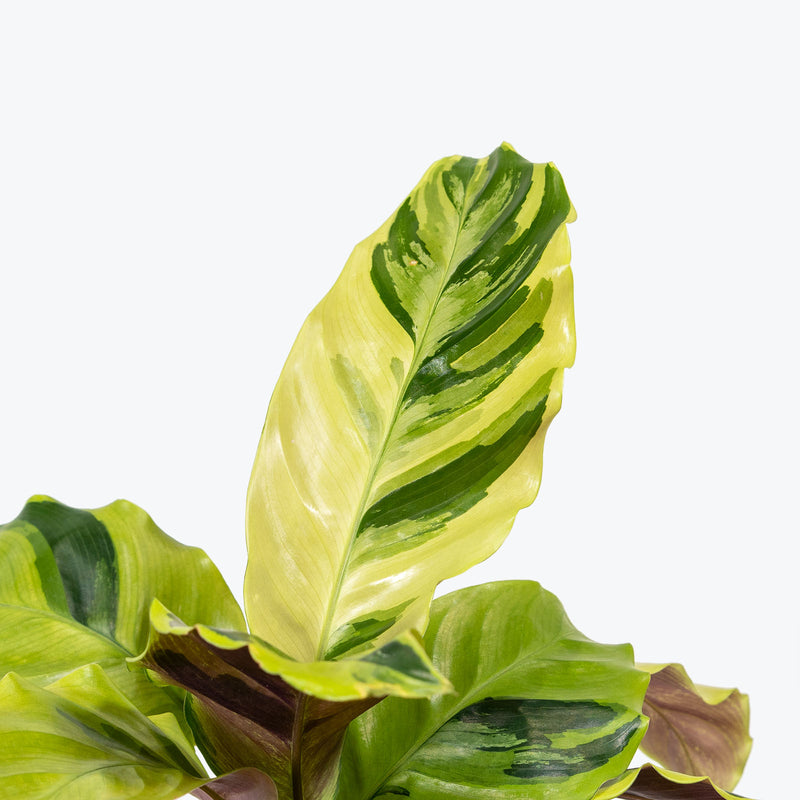
How to care for Calathea Yellow Fusion
They should not be in a position to see the sun directly, although early morning or late evening sun is fine. Filtered sunlight through a sheer curtain is best and most homes are comprised primarily of indirect sunlight. The best spot for them is where they do not see the sun during the majority of the day but still get bright, indirect light.
They will thrive in bright light, but also can tolerate medium light. A good medium-light place in your home would be in the middle of a room that has a regular size window. They can be placed anywhere between the middle of the room and the window. Remember that plants will grow based on how much light they receive.
They need to be watered when the top half of the soil is dry to the touch. That usually takes about 1 week in an average home environment. It will vary depending on the time of year, your environment and lighting conditions, but it's always safer to underwater or give the soil a check before you water again. Expect to water more often in brighter light and less often in lower light.
They like a high humidity environment, give them a mist daily or as often as possible. Alternatively, you can put them around a humidifier. Although they won't die if they don't receive enough humidity, their leaves may have some dry, crunchy, or yellow edges.
Although Calathea's are known as the divas of the plant world, once they are in the right environment, the payoff is phenomenal. No two leaves are alike and the colours that occur through all the varieties in the family are bold and beautiful. Keep in a highly humid environment with lots of bright, indirect light (no direct sun), watering only with distilled or rainwater. Once this is achieved, you will sit and stare at your new plant for hours!
You can feel comfortable having this plant around your home in the potential case where your pet feels like nibbling on it. However, we typically recommend keeping your pets from eating any of your houseplants..
Learn MoreView PlantCalathea Zebrina
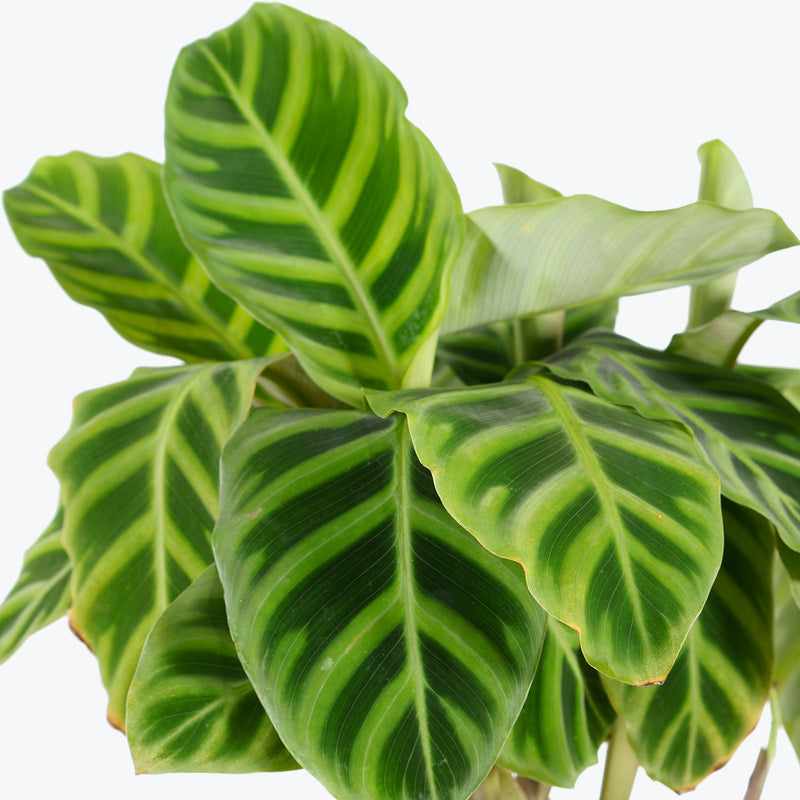
How to care for Calathea Zebrina
They should not be in a position to see the sun directly, although early morning or late evening sun is fine. Filtered sunlight through a sheer curtain is best and most homes are comprised primarily of indirect sunlight. The best spot for them is where they do not see the sun during the majority of the day but still get bright, indirect light.
They will thrive in bright light, but also can tolerate medium light. A good medium-light place in your home would be in the middle of a room that has a regular size window. They can be placed anywhere between the middle of the room and the window. Remember that plants will grow based on how much light they receive.
They need to be watered when the top half of the soil is dry to the touch. That usually takes about 1 week in an average home environment. It will vary depending on the time of year, your environment and lighting conditions, but it's always safer to underwater or give the soil a check before you water again.
They like a high humidity environment, give them a mist daily or as often as possible. Alternatively, you can put them around a humidifier. Although they won't die if they don't receive enough humidity, their leaves may have some dry, crunchy, or yellow edges.
Although Calathea's are known as the divas of the plant world, once they are in the right environment, the payoff is phenomenal. No two leaves are alike and the colours that occur through all the varieties in the family are bold and beautiful. Keep in a highly humid environment with lots of bright, indirect light (no direct sun), watering only with distilled or rain water. Once this is achieved, you will sit and stare at your new plant for hours!
You can feel comfortable having this plant around your home in the potential case where your pet feels like nibbling on it. However, we typically recommend keeping your pets from eating any of your houseplants..
Learn MoreView PlantCalla Lily

How to care for Calla Lily
Calla Lily should not be in a position to see the sun directly, although early morning or late evening sun is fine. Filtered sunlight through a sheer curtain is best and most homes are comprised primarily of indirect sunlight. The best spot for them is where they do not see the sun during the majority of the day but still get bright, indirect light.
Calla Lily will thrive in bright light, but also can tolerate medium light. A good medium-light place in your home would be in the middle of a room that has a regular size window. They can be placed anywhere between the middle of the room and the window. Remember that plants will grow based on how much light they receive.
Allow the top quarter of the soil to dry before watering again. This usually takes about 3 - 4 days in an average home environment. It will vary depending on the time of year, your environment and lighting conditions.
Calla Lily can live in any average home humidity condition and are fairly hardy.
Like other flowering plants, the Calla Lily will go through blooming cycles – a few months with flowers, a few months without. When the current blooming cycle ends, cut the dead leaves and let the plant go dormant for about two months. After that time, place it in bright light and water normally to revive it. This will restart the bloom cycle. If you don’t mind your Calla Lily not reblooming, continue with regular care and enjoy its leafy green foliage year-round!
Calla Lily is moderately toxic and can cause some adverse reactions when ingested so it is best to not let your pets eat it, which we advise for all plants in general. The severity of the reaction will depend on how much of the plant is ingested but, if you know your pet typically does not eat your plants, this plant will be suitable for your home..
View PlantCalocephalus Brownii Silver Bush
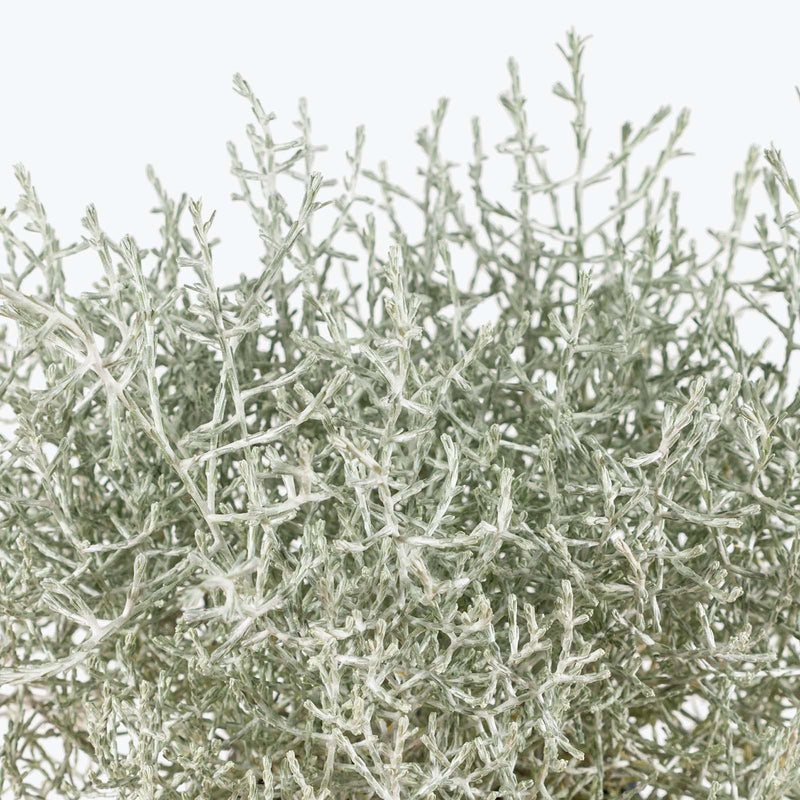
How to care for Calocephalus Brownii Silver Bush
Calocephalus Brownii Silver Bush loves as much sun as possible. The best spot for them is where they can see the sun during the majority of the day.
Calocephalus Brownii Silver Bush will do best in bright light. A nice bright place inside your home would be on the window sill or a stool that is right next to a window, either with or without blinds, depending on if the plant can handle sun. Remember that plants will grow based on how much light they receive.
Calocephalus Brownii Silver Bush likes the soil to be relatively dry before the next watering. That usually takes about 2 weeks in an average home environment. It will vary depending on the time of year, your environment and lighting conditions, but for them, it's always safer to underwater or water when you see signs of lack of water (i.e. droopy, floppy, or soft leaves). Expect to water more often in brighter light and less often in lower light.
Calocephalus Brownii Silver Bush can live in any average home humidity condition and are fairly hardy.
Calocephalus Brownii may look the same dead or alive, you can tell it by checking if the leaves are firm versus dry and soft. Silver Bush generally requires minimal care. It can benefit from light pruning to maintain its shape and encourage denser foliage. In colder climates, it may need protection from frost, as it is not very frost-tolerant. Fertilize annually with a general-purpose fertilizer.
Calocephalus Brownii Silver Bush is moderately toxic and can cause some adverse reactions when ingested so it is best to not let your pets eat it, which we advise for all plants in general. The severity of the reaction will depend on how much of the plant is ingested but, if you know your pet typically does not eat your plants, this plant will be suitable for your home..
View PlantCardboard Palm

How to care for Cardboard Palm
They should not be in a position to see the sun directly, although early morning or late evening sun is fine. Filtered sunlight through a sheer curtain is best and most homes are comprised primarily of indirect sunlight. The best spot for them is where they do not see the sun during the majority of the day but still get bright, indirect light.
They will do well in medium light but will grow faster with brighter light. A good medium-light place in your home would be in the middle of a room that has a regular size window. Remember that plants will grow based on how much light they receive.
They need to be watered when the top half of the soil is dry to the touch. That usually takes about 1 week in an average home environment. It will vary depending on the time of year, your environment and lighting conditions, but it's always safer to underwater or give the soil a check before you water again.
They can live in any average home humidity condition and are fairly hardy.
Prune off dead leaves as they occur and fertilize with a slow release palm food or a diluted household plant food once monthly during the growing season. These are very slow growers and also quite toxic to humans and animals.
This plant is moderately toxic and can cause some adverse reactions when ingested so it is best to not let your pets eat it, which we advise for all plants in general. The severity of the reaction will depend on how much of the plant is ingested but, if you know your pet typically does not eat your plants, this plant will be suitable for your home..
Learn MoreView PlantCaribbean Tree Cactus
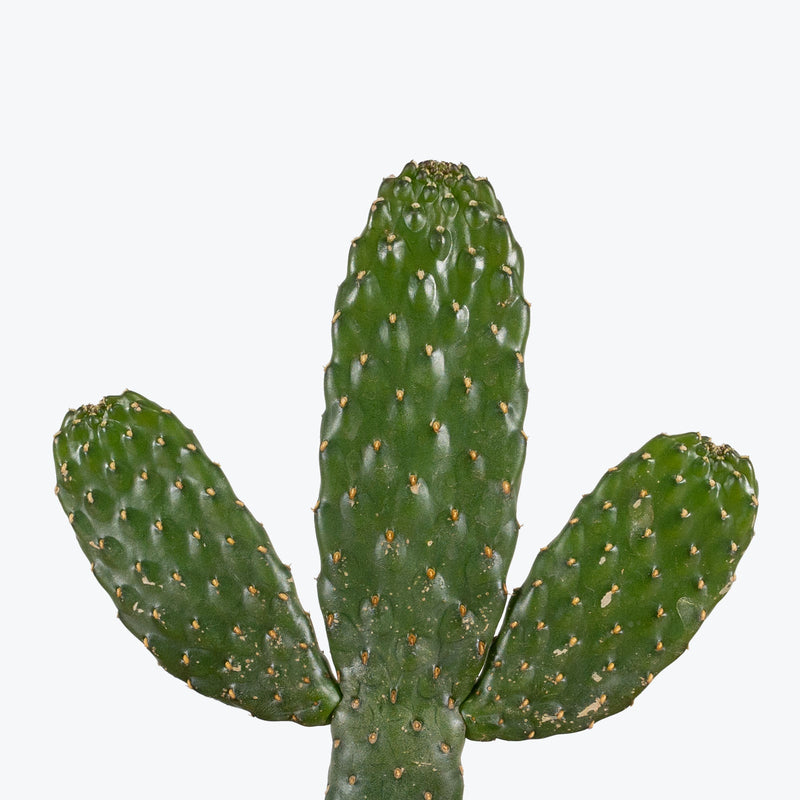
How to care for Caribbean Tree Cactus
Caribbean Tree Cactus enjoys some direct sun, but they'll also do well in bright, indirect light. It is best to place this plant somewhere where it will receive some nice morning sun, or a couple hours of afternoon sun, and then indirect light the rest of the day.
Caribbean Tree Cactus will do best in bright light. A nice bright place inside your home would be on the window sill or a stool that is right next to a window, either with or without blinds, depending on if the plant can handle sun. Remember that plants will grow based on how much light they receive.
Caribbean Tree Cactus likes the soil to be completely dry before the next watering. This can take up to 4 weeks in an average home environment but it will vary depending on the time of year, your environment and lighting conditions. For them, it's always safer to underwater or water when you see signs of lack of water (i.e. wrinkly or soft leaves). Water a little more often in the warmer months.
Their humidity requirement is low, so do not mist Caribbean Tree Cactus or put them in a terrarium.
As with all succulents, overwatering is sure to be fatal, so err on the side of too dry rather than too wet, never letting Caribbean Tree Cactus sit in water. If the side of the plant facing the sun starts to turn yellow or brown, move the plant to a spot where it will receive less direct sunlight than it was receiving. Ensure good drainage in the pot to avoid water retention in the soil. Pruning is not generally necessary, but you may remove any damaged or diseased pads to maintain the plant's health and appearance.
While not toxic, the Caribbean Tree Cactus can be a hazard due to its spines. Pets and small children might be injured if they come into contact with the sharp spines. It's advisable to place this cactus where it won't pose a risk to curious pets or children..
Learn MoreView PlantCast Iron Milky Way
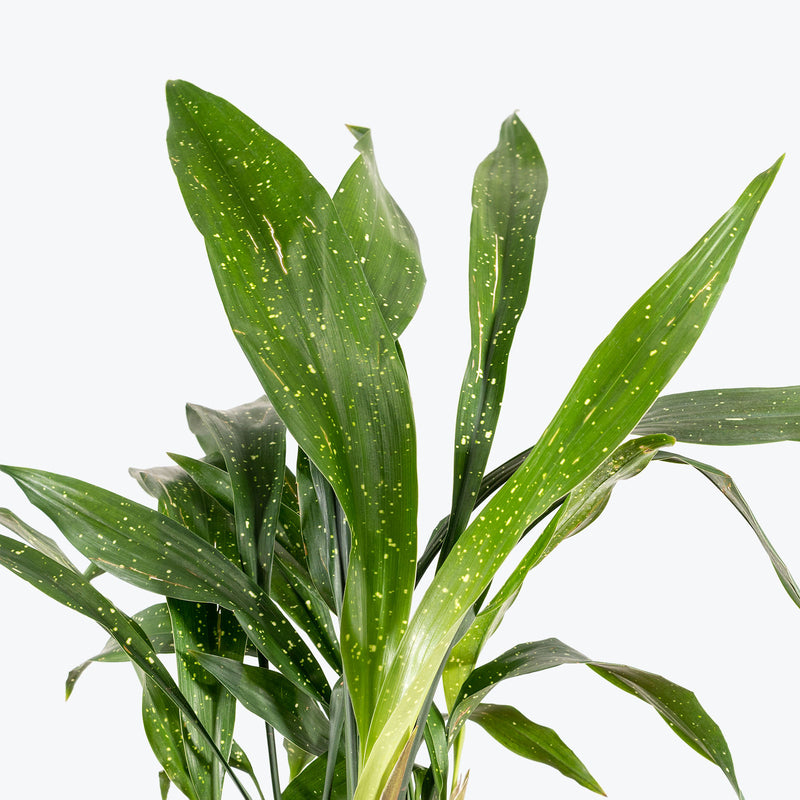
How to care for Cast Iron Milky Way
They should not be in a position to see the sun directly, although early morning or late evening sun is fine. Filtered sunlight through a sheer curtain is best and most homes are comprised primarily of indirect sunlight. The best spot for them is where they do not see the sun during the majority of the day but still get bright, indirect light.
They will do well in low light, but will grow faster with brighter light. A low light plant can pretty much survive anyplace inside your home as long as you have a window in the room. Remember, low light does not mean no light and plants will grow based on how much light they receive.
They like the soil to be relatively dry before the next watering. That usually takes about 2 weeks in an average home environment. It will vary depending on the time of year, your environment and lighting conditions, but for them, it's always safer to underwater or water when you see signs of lack of water (i.e. droopy, floppy, or soft leaves). Water more often in the warmer months.
They can live in any average home humidity condition and are fairly hardy.
They are a slow grower, especially in lower light conditions, but they are one of the hardiest plants out there. Their foliage is simple, but elegant, and they are a great addition to any home. Avoid putting them in harsh, direct sun.
You can feel comfortable having this plant around your home in the potential case where your pet feels like nibbling on it. However, we typically recommend keeping your pets from eating any of your houseplants..
View PlantCast Iron Plant
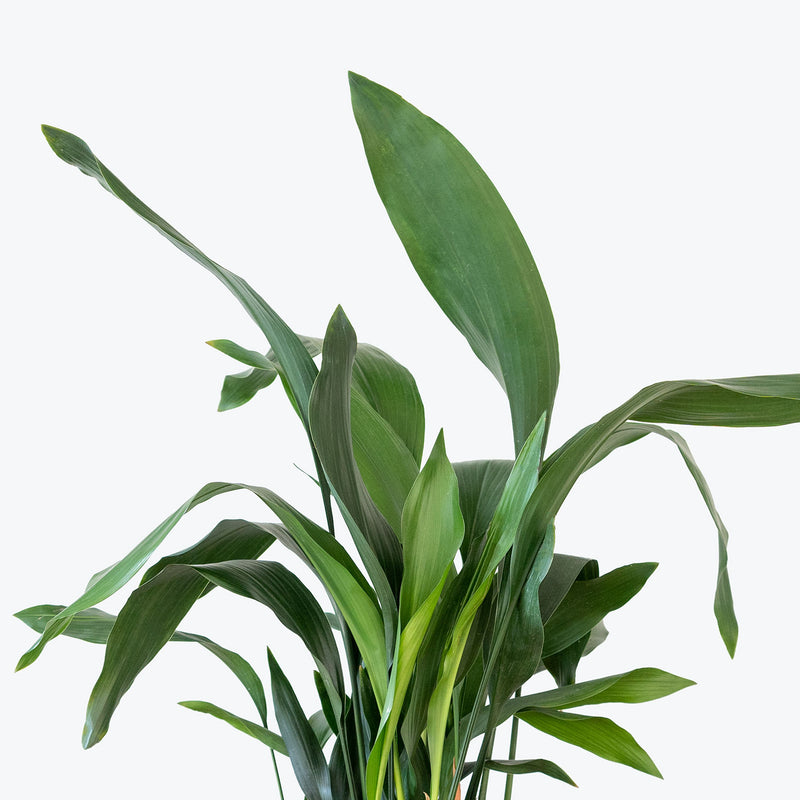
How to care for Cast Iron Plant
Cast Iron Plant should not be in a position to see the sun directly, although early morning or late evening sun is fine. Filtered sunlight through a sheer curtain is best and most homes are comprised primarily of indirect sunlight. The best spot for them is where they do not see the sun during the majority of the day but still get bright, indirect light.
Cast Iron Plant will do well in low light, but will grow faster with brighter light. A low light plant can pretty much survive anyplace inside your home as long as you have a window in the room. Remember, low light does not mean no light and plants will grow based on how much light they receive.
Cast Iron Plant likes the soil to be relatively dry before the next watering. That usually takes about 2 weeks in an average home environment. It will vary depending on the time of year, your environment and lighting conditions, but for them, it's always safer to underwater or water when you see signs of lack of water (i.e. droopy, floppy, or soft leaves). Water more often in the warmer months.
Cast Iron Plant can live in any average home humidity condition and are fairly hardy.
Cast Iron Plant is a slow grower, especially in lower light conditions, but they are one of the hardiest plants out there. Their foliage is simple, but elegant, and they are a great addition to any home. Avoid putting them in harsh, direct sun.
You can feel comfortable having Cast Iron Plant around your home in the potential case where your pet feels like nibbling on it. However, we typically recommend keeping your pets from eating any of your houseplants..
View PlantCast Iron Plant Variegata
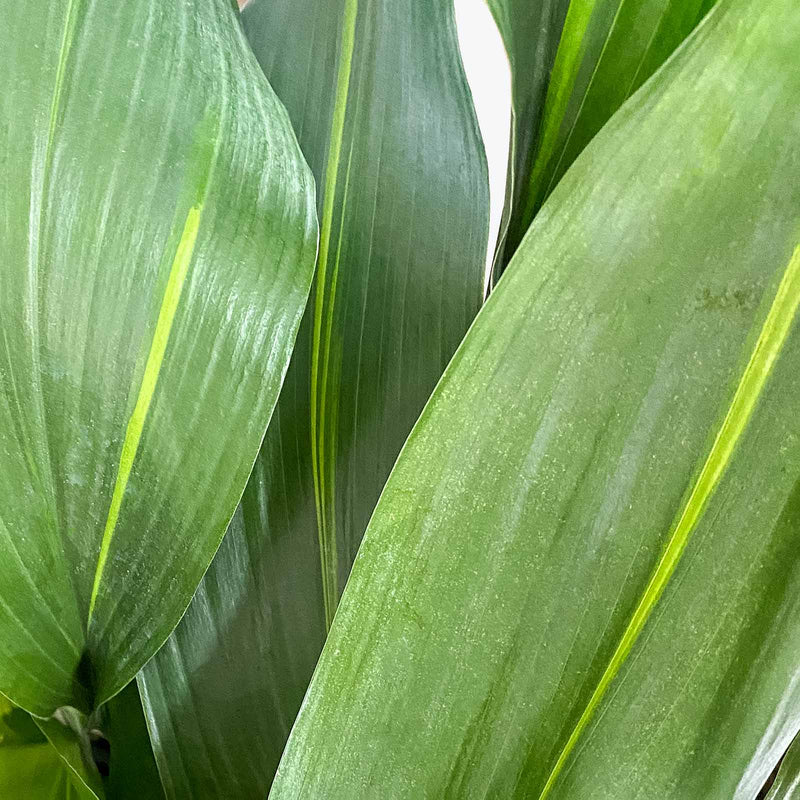
How to care for Cast Iron Plant Variegata
They should not be in a position to see the sun directly, although early morning or late evening sun is fine. Filtered sunlight through a sheer curtain is best and most homes are comprised primarily of indirect sunlight. The best spot for them is where they do not see the sun during the majority of the day but still get bright, indirect light.
They will do well in low light, but will grow faster with brighter light. A low light plant can pretty much survive anyplace inside your home as long as you have a window in the room. Remember, low light does not mean no light and plants will grow based on how much light they receive.
They like the soil to be relatively dry before the next watering. That usually takes about 2 weeks in an average home environment. It will vary depending on the time of year, your environment and lighting conditions, but for them, it's always safer to underwater or water when you see signs of lack of water (i.e. droopy, floppy, or soft leaves). Water more often in the warmer months.
They can live in any average home humidity condition and are fairly hardy.
They are a slow grower, especially in lower light conditions, but they are one of the hardiest plants out there. Their foliage is simple, but elegant, and they are a great addition to any home. Avoid putting them in harsh, direct sun.
You can feel comfortable having this plant around your home in the potential case where your pet feels like nibbling on it. However, we typically recommend keeping your pets from eating any of your houseplants..
View PlantCat Grass
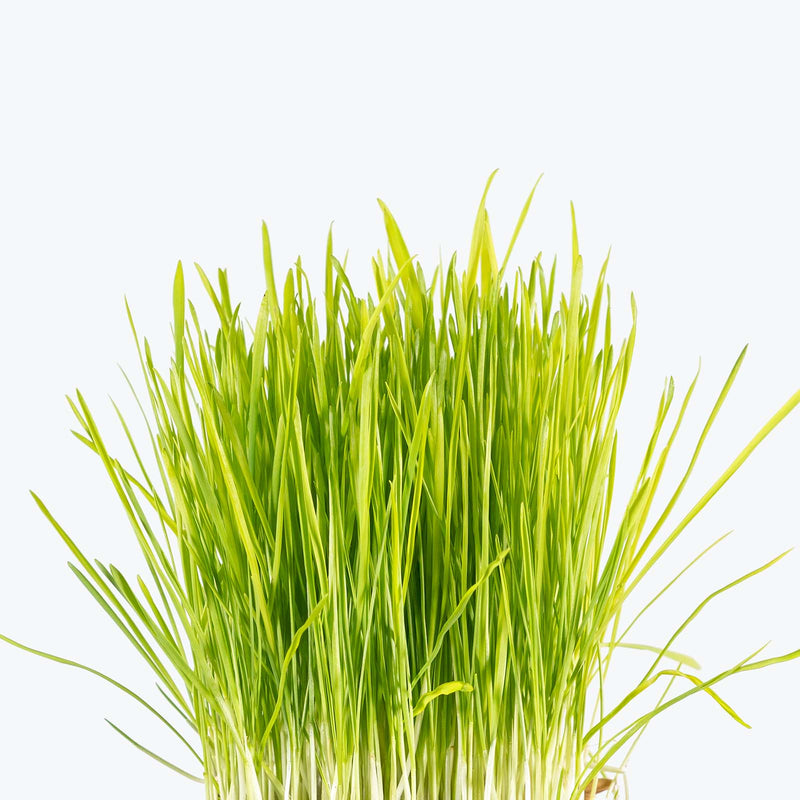
How to care for Cat Grass
Cat Grass enjoys some direct sun, but they'll also do well in bright, indirect light. It is best to place this plant somewhere where it will receive some nice morning sun, or a couple hours of afternoon sun, and then indirect light for the rest of the day.
Cat Grass will do best in bright light. A nice bright place inside your home would be on the window sill or a stool that is right next to a window, either with or without blinds, depending on if the plant can handle sun. Remember that plants will grow based on how much light they receive.
Cat Grass like the soil to stay consistently moist, but not soaking wet. Give them water whenever just the surface of the soil is starting to get dry. Expect to water more often in brighter light and less often in lower light.
Cat Grass can live in any average home humidity condition and are fairly hardy.
Trim regularly to encourage fresh, tender new growth and to keep it from becoming too tall or tough. Cat Grass is typically grown as a short-term crop — reseed every few weeks for a continuous, fresh supply. Use shallow containers with good drainage and a light potting mix. Can also be grown outdoors in cool climates as a perennial pasture grass.
You can feel comfortable having Cat Grass around your home in the potential case where your pet feels like nibbling on it. However, we typically recommend keeping your pets from eating any of your houseplants..
View PlantCat Palm
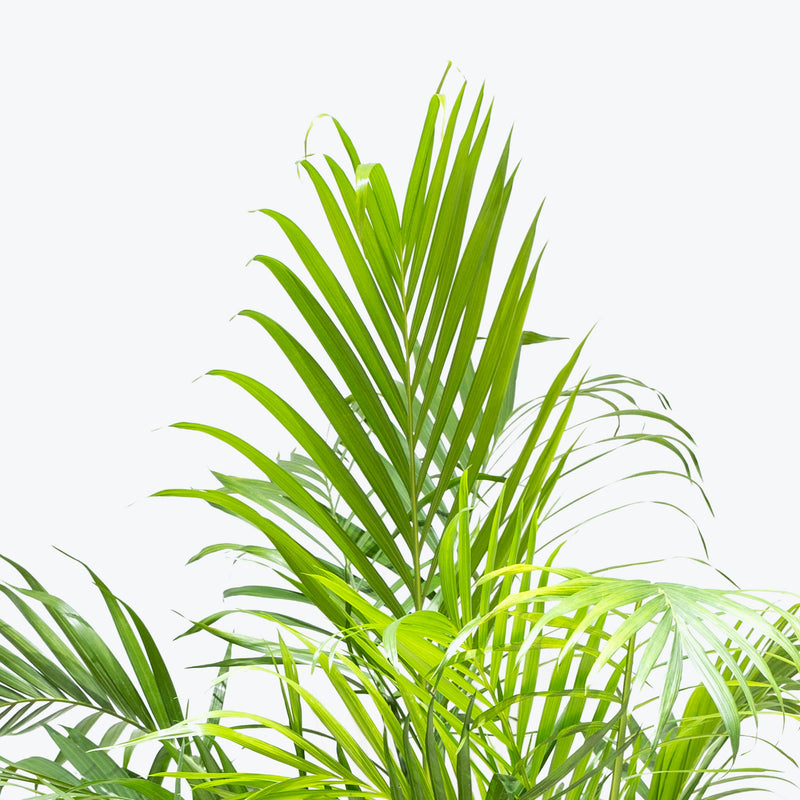
How to care for Cat Palm
They enjoy some direct sun, but they'll also do well in bright, indirect light. It is best to place this plant somewhere where it will receive some nice morning sun, or a couple hours of afternoon sun, and then indirect light the rest of the day.
They will do best in bright light. A nice bright place inside your home would be on the window sill or a stool that is right next to a window, either with or without blinds, depending on if the plant can handle sun. Remember that plants will grow based on how much light they receive.
Allow the top quarter of the soil to dry before watering again. This usually takes about 3 - 4 days in an average home environment. It will vary depending on the time of year, your environment and lighting conditions.
They will do well in average humidity environments but will appreciate a little bit of humidity if provided, give them a mist daily or get a humidifier!
Cat Palms don’t need repotting very often, on average it is only required once every three years. Spider mite loves all palms, give your palm a shower every once a while or when you see them will keep them away.
You can feel comfortable having this plant around your home in the potential case where your pet feels like nibbling on it. However, we typically recommend keeping your pets from eating any of your houseplants..
Learn MoreView PlantCebu Blue Pothos
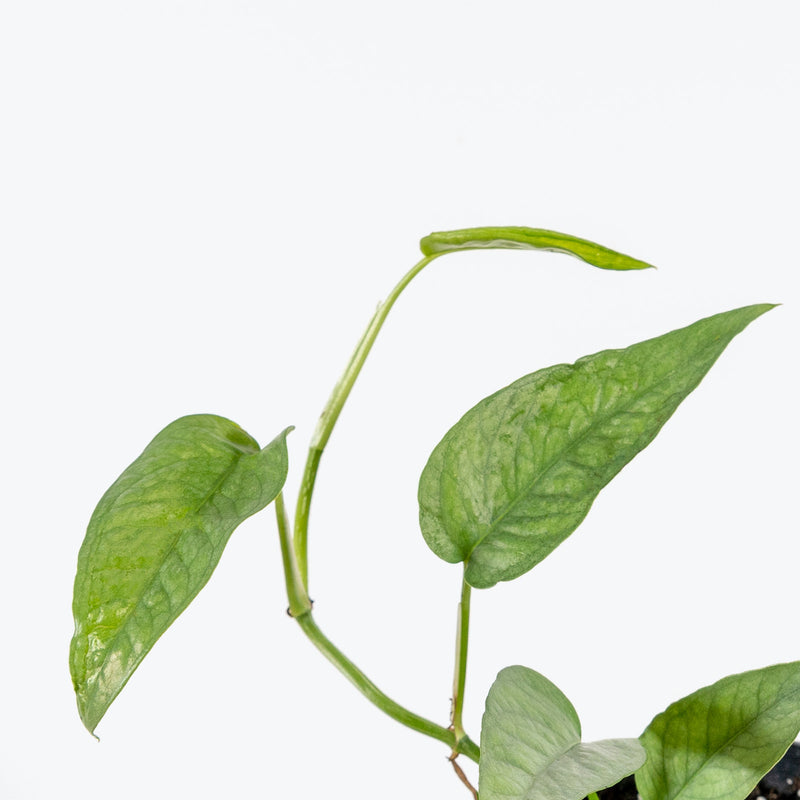
How to care for Cebu Blue Pothos
Cebu Blue Pothos should not be in a position to see the sun directly, although early morning or late evening sun is fine. Filtered sunlight through a sheer curtain is best and most homes are comprised primarily of indirect sunlight. The best spot for them is where they do not see the sun during the majority of the day but still get bright, indirect light.
Cebu Blue Pothos will thrive in medium to bright light, but also can tolerate low light. A good medium-light place in your home would be in the middle of a room that has a regular size window. They can be placed almost anywhere in the room but remember, plants will grow based on how much light they receive.
Cebu Blue Pothos likes the soil to be relatively dry before the next watering. That usually takes about 2 weeks in an average home environment. It will vary depending on the time of year, your environment and lighting conditions, but for them, it's always safer to underwater or water when you see signs of lack of water (i.e. droopy, floppy, or soft leaves). Expect to water more often in brighter light and less often in lower light.
Cebu Blue Pothos can live in any average home humidity condition and are fairly hardy.
Even though Cebu Blue Pothos can tolerate lower light, if you want full, lush foliage, it would be better to keep your plant in a location with medium to bright, indirect light - your plant would greatly benefit from some morning sunlight. Feel free to trim your Pothos regularly as this encourages the plant to develop more side-shoots and reduces the demand for the plant to develop a larger root system while confined. Their cuttings propagate very easily in water.
Cebu Blue Pothos is moderately toxic and can cause some adverse reactions when ingested so it is best to not let your pets eat it, which we advise for all plants in general. The severity of the reaction will depend on how much of the plant is ingested but, if you know your pet typically does not eat your plants, this plant will be suitable for your home..
Learn MoreView PlantCherry Tomato
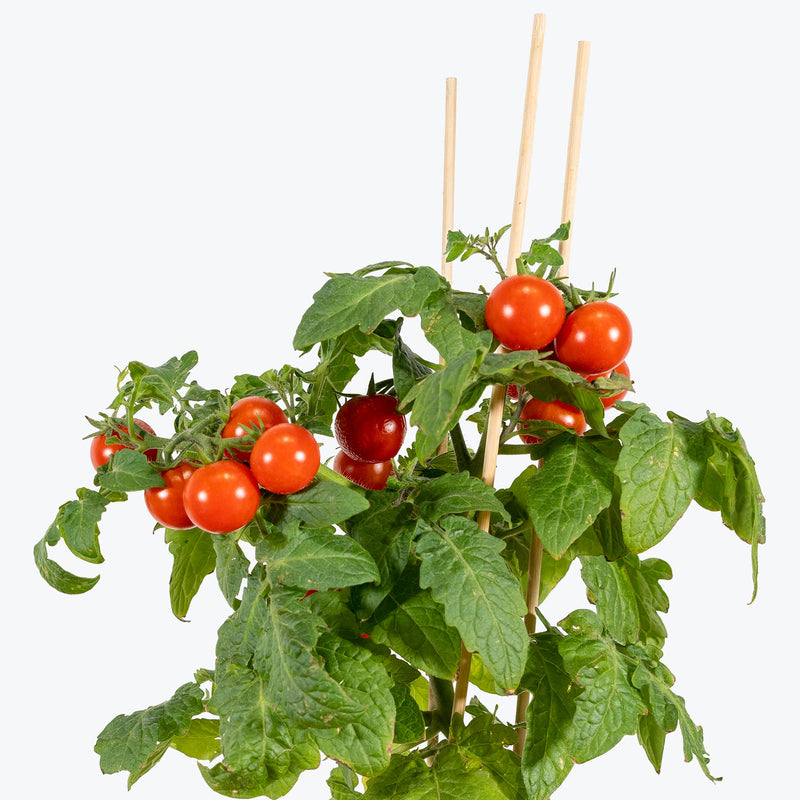
How to care for Cherry Tomato
They love as much heat and sun as possible. The best spot for them is outdoors where they can see the sun for the majority of the day (at least 6 hours).
They will do their best and fruit profusely in bright light. A nice bright place outside would be on a sunny balcony, deck, or backyard. Remember that plants will grow and flower based on how much light they receive.
Plants grown in containers have a greater need for water, on hot days you may need to water both in the morning and evening. Do expect to water all container cherry tomatoes daily unless it has been raining.
They like a high humidity environment. Outdoors, this should happen naturally in the summer.
As it grows taller, consider supporting it with a cage, trellis, or stakes in order to support its growth. It is good to use a water-soluble fertilizer, a 20-20-20 general-purpose will work though if you are investing in a fertilizer there are tomato-specific brands available. Follow the strength recommendation on the packaging. Keep your plant protected from any wind and in temperatures above 12°C.
This plant is moderately toxic and can cause some adverse reactions when ingested so it is best to not let your pets eat it, which we advise for all plants in general. The severity of the reaction will depend on how much of the plant is ingested but, if you know your pet typically does not eat your plants, this plant will be suitable for your home..
View PlantChina Doll Plant
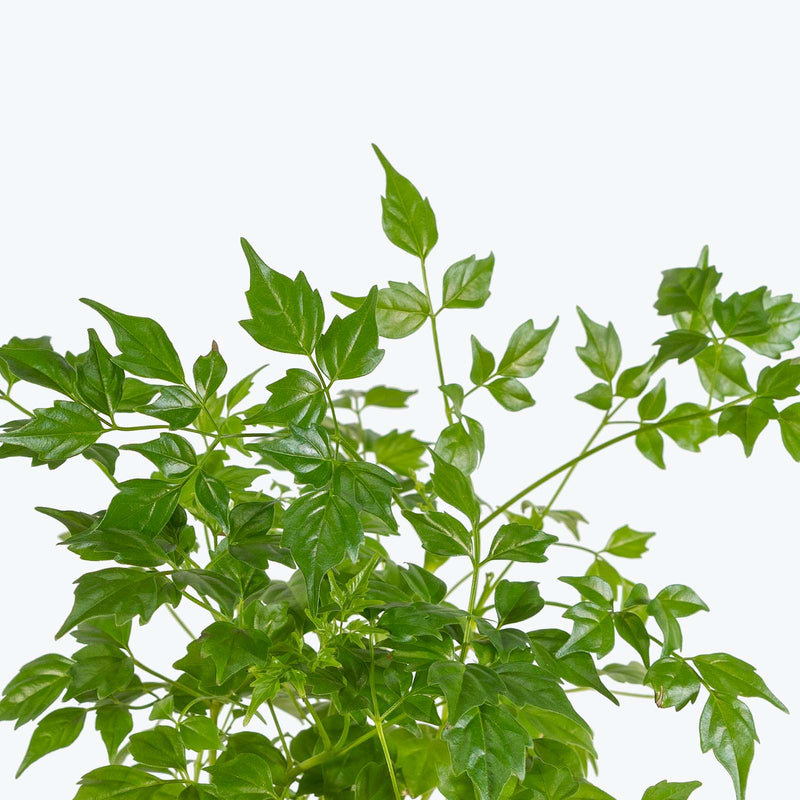
How to care for China Doll Plant
China Doll Plant should not be in a position to see the sun directly, although early morning or late evening sun is fine. Filtered sunlight through a sheer curtain is best and most homes are comprised primarily of indirect sunlight. The best spot for them is where they do not see the sun during the majority of the day but still get bright, indirect light.
China Doll Plant will thrive in bright light, but also can tolerate medium light. A good medium-light place in your home would be in the middle of a room that has a regular size window. They can be placed anywhere between the middle of the room and the window. Remember that plants will grow based on how much light they receive.
Allow the top quarter of the soil to dry before watering China Doll Plant again. This usually takes about 3 - 4 days in an average home environment. It will vary depending on the time of year, your environment and lighting conditions. Expect to water more often in brighter light and less often in lower light.
China Doll Plant will do well in average humidity environments but will appreciate a little bit of humidity if provided, give them a mist daily or get a humidifier.
China Doll Plant is sensitive to changes in temperature and drafts, so be sure to keep them in a stable environment. They are susceptible to spider mites, so keep an eye out for webs on the leaves and treat with insecticidal soap if necessary.
You can feel comfortable having China Doll Plant around your home in the potential case where your pet feels like nibbling on it. However, we typically recommend keeping your pets from eating any of your houseplants..
View PlantChinese Evergreen BJ Freeman
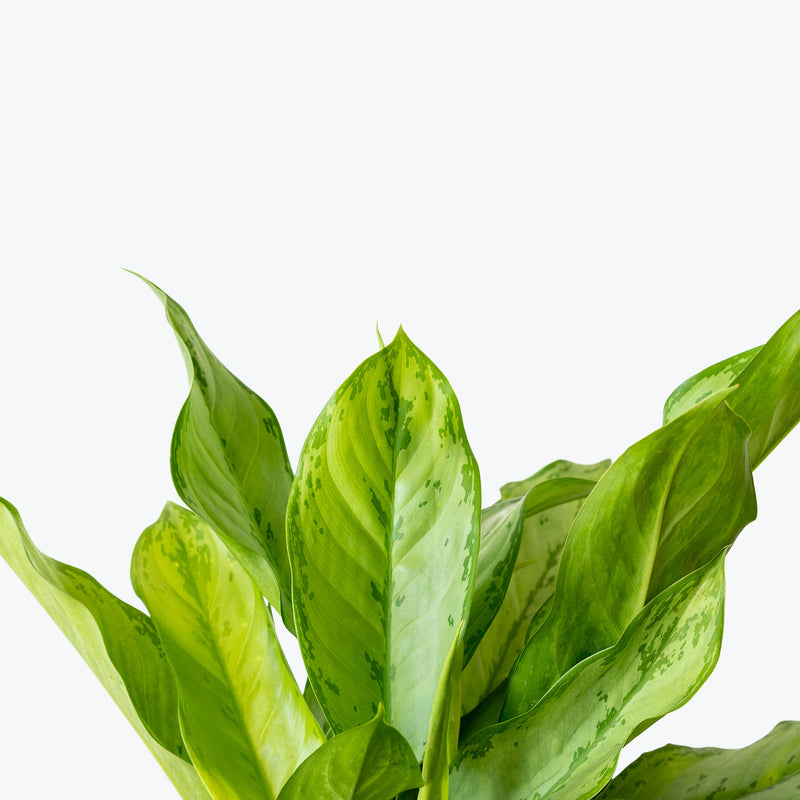
How to care for Chinese Evergreen BJ Freeman
They should not be in a position to see the sun directly, although early morning or late evening sun is fine. Filtered sunlight through a sheer curtain is best and most homes are comprised primarily of indirect sunlight. The best spot for them is where they do not see the sun during the majority of the day but still get bright, indirect light.
They will thrive in medium to bright light, but also can tolerate low light. A good medium-light place in your home would be in the middle of a room that has a regular size window. They can be placed almost anywhere in the room but remember, plants will grow based on how much light they receive.
They need to be watered when the top half of the soil is dry to the touch. That usually takes about 1 week in an average home environment. It will vary depending on the time of year, your environment and lighting conditions, but it's always safer to underwater or give the soil a check before you water again.
They can live in any average home humidity condition and are fairly hardy.
If you mist it daily, or keep a humidifier around your plant, it will really help the health of the leaves. Or let it steam in the bathroom once in a while as you relax!
This plant is moderately toxic and can cause some adverse reactions when ingested so it is best to not let your pets eat it, which we advise for all plants in general. The severity of the reaction will depend on how much of the plant is ingested but, if you know your pet typically does not eat your plants, this plant will be suitable for your home..
Learn MoreView PlantChinese Evergreen Chocolate
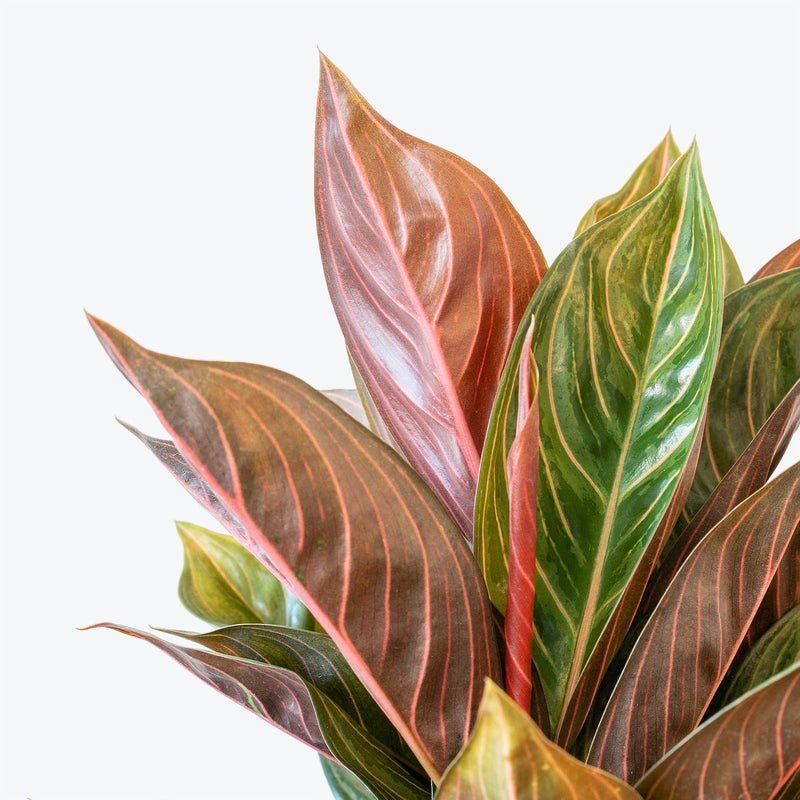
How to care for Chinese Evergreen Chocolate
Chinese Evergreen Chocolate should not be in a position to see the sun directly, although early morning or late evening sun is fine. Filtered sunlight through a sheer curtain is best and most homes are comprised primarily of indirect sunlight. The best spot for them is where they do not see the sun during the majority of the day but still get bright, indirect light.
Chinese Evergreen Chocolate will thrive in medium to bright light, but also can tolerate low light. A good medium-light place in your home would be in the middle of a room that has a regular size window. They can be placed almost anywhere in the room but remember, plants will grow based on how much light they receive.
Chinese Evergreen Chocolate needs to be watered when the top half of the soil is dry to the touch. That usually takes about 1 week in an average home environment. It will vary depending on the time of year, your environment and lighting conditions, but it's always safer to underwater or give the soil a check before you water again.
Chinese Evergreen Chocolate can live in any average home humidity conditions and is fairly hardy.
If you mist Chinese Evergreen Chocolate daily, or keep a humidifier around them, they will really help the health of the leaves. Wipe the leaves regularly with a soft, damp cloth to remove dust and enhance the appearance and health of the plant.
Chinese Evergreen Chocolate is moderately toxic and can cause some adverse reactions when ingested so it is best to not let your pets eat it, which we advise for all plants in general. The severity of the reaction will depend on how much of the plant is ingested but, if you know your pet typically does not eat your plants, this plant will be suitable for your home..
Learn MoreView PlantChinese Evergreen Cleopatra
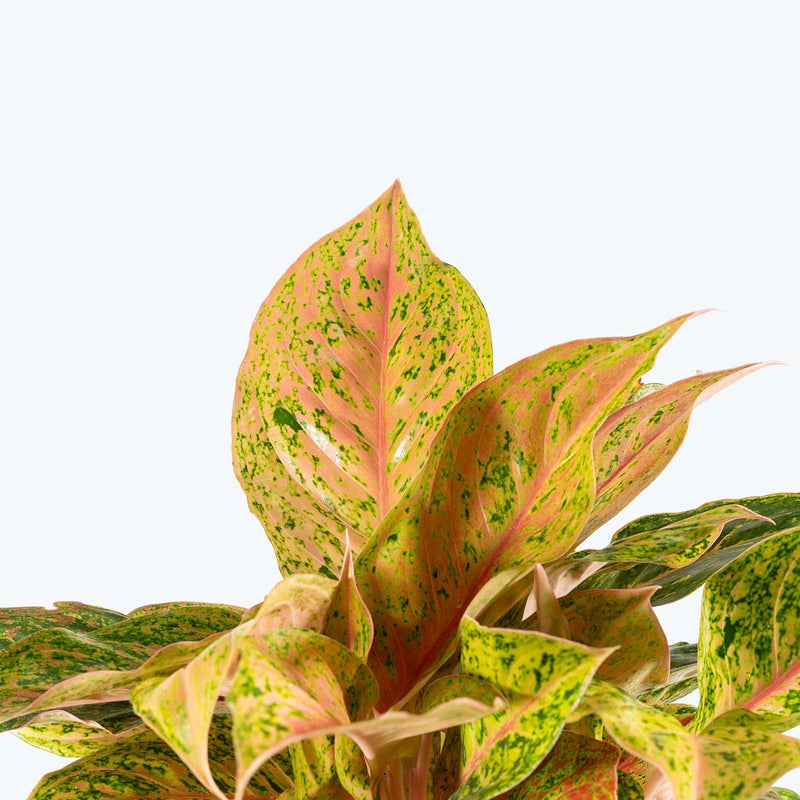
How to care for Chinese Evergreen Cleopatra
Chinese Evergreen Cleopatra should not be in a position to see the sun directly, although early morning or late evening sun is fine. Filtered sunlight through a sheer curtain is best and most homes are comprised primarily of indirect sunlight. The best spot for them is where they do not see the sun during the majority of the day but still get bright, indirect light.
Chinese Evergreen Cleopatra will thrive in medium to bright light, but also can tolerate low light. A good medium-light place in your home would be in the middle of a room that has a regular size window. They can be placed almost anywhere in the room but remember, plants will grow based on how much light they receive.
Chinese Evergreen Cleopatra needs to be watered when the top half of the soil is dry to the touch. That usually takes about 1 week in an average home environment. It will vary depending on the time of year, your environment and lighting conditions, but it's always safer to underwater or give the soil a check before you water again.
Chinese Evergreen Cleopatra can live in any average home with humidity conditions and is fairly hardy.
Fertilize Chinese Evergreen Cleopatra every 4-6 weeks during the growing season with a balanced liquid fertilizer diluted to half strength. Reduce fertilization in the winter months when the plant's growth naturally slows. Clean the leaves periodically with a soft, damp cloth to remove dust and support photosynthesis.
Chinese Evergreen Cleopatra is moderately toxic and can cause some adverse reactions when ingested so it is best to not let your pets eat it, which we advise for all plants in general. The severity of the reaction will depend on how much of the plant is ingested but, if you know your pet typically does not eat your plants, this plant will be suitable for your home..
Learn MoreView PlantChinese Evergreen Cutlass

How to care for Chinese Evergreen Cutlass
They should not be in a position to see the sun directly, although early morning or late evening sun is fine. Filtered sunlight through a sheer curtain is best and most homes are comprised primarily of indirect sunlight. The best spot for them is where they do not see the sun during the majority of the day but still get bright, indirect light.
They will thrive in medium to bright light, but also can tolerate low light. A good medium-light place in your home would be in the middle of a room that has a regular size window. They can be placed almost anywhere in the room but remember, plants will grow based on how much light they receive.
They need to be watered when the top half of the soil is dry to the touch. That usually takes about 1 week in an average home environment. It will vary depending on the time of year, your environment and lighting conditions, but it's always safer to underwater or give the soil a check before you water again. Expect to water more often in brighter light and less often in lower light.
They can live in any average home humidity condition and are fairly hardy.
If you mist it daily, or keep a humidifier around your plant, it will really help the health of the leaves. Or let it steam in the bathroom once in a while as you relax!
This plant is moderately toxic and can cause some adverse reactions when ingested so it is best to not let your pets eat it, which we advise for all plants in general. The severity of the reaction will depend on how much of the plant is ingested but, if you know your pet typically does not eat your plants, this plant will be suitable for your home..
Learn MoreView PlantChinese Evergreen Eileen
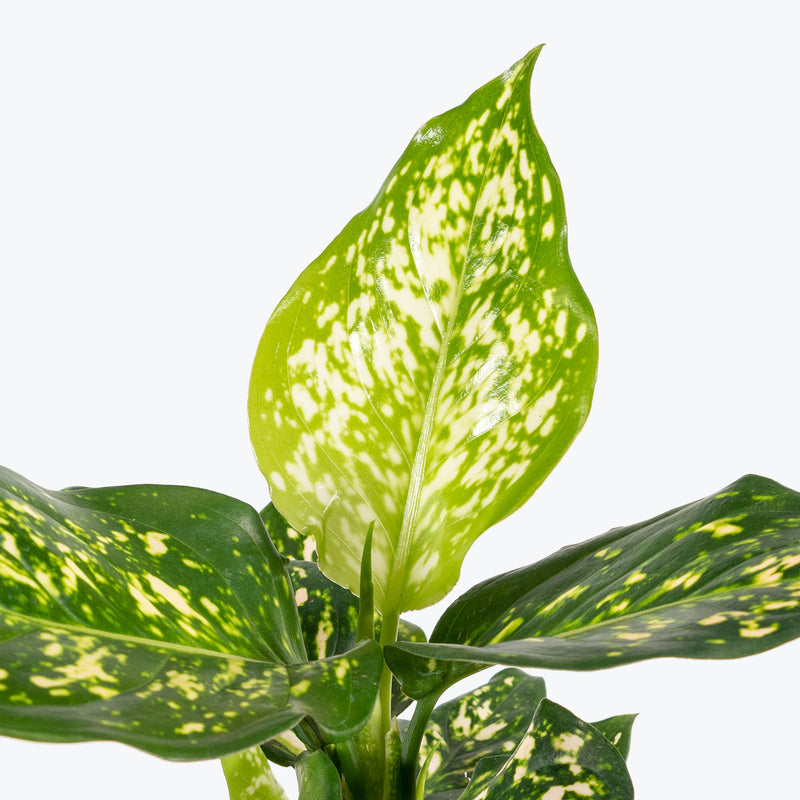
How to care for Chinese Evergreen Eileen
They should not be in a position to see the sun directly, although early morning or late evening sun is fine. Filtered sunlight through a sheer curtain is best and most homes are comprised primarily of indirect sunlight. The best spot for them is where they do not see the sun during the majority of the day but still get bright, indirect light.
They will thrive in medium to bright light, but also can tolerate low light. A good medium-light place in your home would be in the middle of a room that has a regular size window. They can be placed almost anywhere in the room but remember, plants will grow based on how much light they receive.
They need to be watered when the top half of the soil is dry to the touch. That usually takes about 1 week in an average home environment. It will vary depending on the time of year, your environment and lighting conditions, but it's always safer to underwater or give the soil a check before you water again. Expect to water more often in brighter light and less often in lower light.
They can live in any average home humidity condition and are fairly hardy.
If you mist it daily, or keep a humidifier around your plant, it will really help the health of the leaves. Or let it steam in the bathroom once in a while as you relax! Remember that plants in brighter light will need to be watered more often than those in lower light, and vice versa. If you are ever unsure if it is time to water, wait until the foliage is a little droopy before doing so.
This plant is moderately toxic and can cause some adverse reactions when ingested so it is best to not let your pets eat it, which we advise for all plants in general. The severity of the reaction will depend on how much of the plant is ingested but, if you know your pet typically does not eat your plants, this plant will be suitable for your home..
Learn MoreView PlantChinese Evergreen Etta Rose

How to care for Chinese Evergreen Etta Rose
They should not be in a position to see the sun directly, although early morning or late evening sun is fine. Filtered sunlight through a sheer curtain is best and most homes are comprised primarily of indirect sunlight. The best spot for them is where they do not see the sun during the majority of the day but still get bright, indirect light.
They will thrive in medium to bright light, but also can tolerate low light. A good medium-light place in your home would be in the middle of a room that has a regular size window. They can be placed almost anywhere in the room but remember, plants will grow based on how much light they receive.
They need to be watered when the top half of the soil is dry to the touch. That usually takes about 1 week in an average home environment. It will vary depending on the time of year, your environment and lighting conditions, but it's always safer to underwater or give the soil a check before you water again.
They can live in any average home humidity condition and are fairly hardy.
If you mist it daily, or keep a humidifier around your plant, it will really help the health of the leaves. Or let it steam in the bathroom once in a while as you relax!
This plant is moderately toxic and can cause some adverse reactions when ingested so it is best to not let your pets eat it, which we advise for all plants in general. The severity of the reaction will depend on how much of the plant is ingested but, if you know your pet typically does not eat your plants, this plant will be suitable for your home..
Learn MoreView PlantChinese Evergreen Golden Fluorite
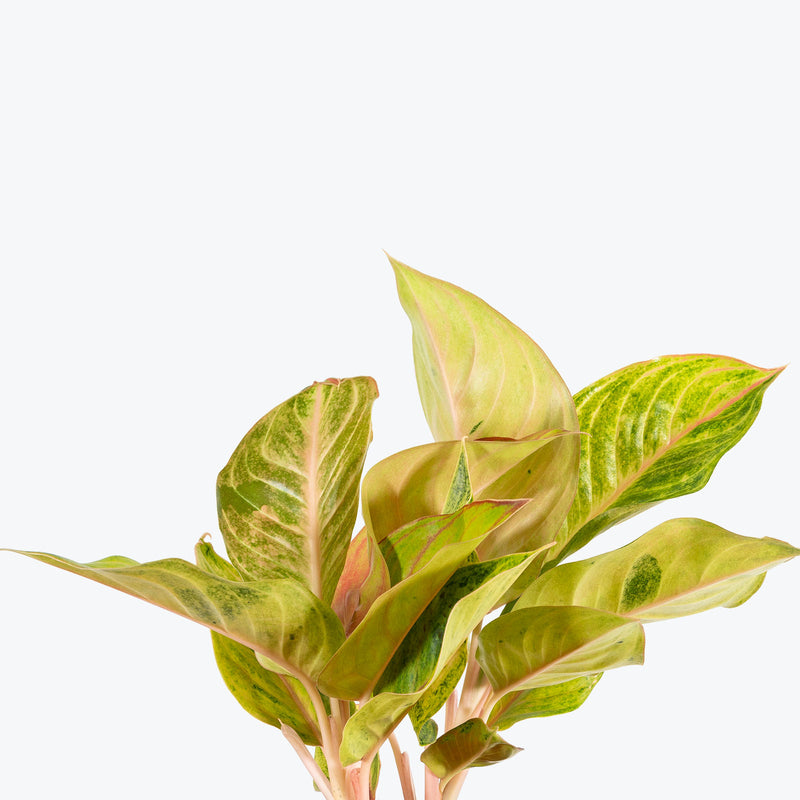
How to care for Chinese Evergreen Golden Fluorite
They should not be in a position to see the sun directly, although early morning or late evening sun is fine. Filtered sunlight through a sheer curtain is best and most homes are comprised primarily of indirect sunlight. The best spot for them is where they do not see the sun during the majority of the day but still get bright, indirect light.
They will thrive in bright light, but also can tolerate medium light. A good medium-light place in your home would be in the middle of a room that has a regular size window. They can be placed anywhere between the middle of the room and the window. Remember that plants will grow based on how much light they receive.
They like the soil to be relatively dry before the next watering. That usually takes about 2 weeks in an average home environment. It will vary depending on the time of year, your environment and lighting conditions, but for them, it's always safer to underwater or water when you see signs of lack of water (i.e. droopy, floppy, or soft leaves). Expect to water more often in brighter light and less often in lower light.
They can live in any average home humidity condition and are fairly hardy.
If you mist it daily, or keep a humidifier around your plant, it will really help the health of the leaves. Or let it steam in the bathroom once in a while as you relax! Remember that plants in brighter light will need to be watered more often than those in lower light, and vice versa. If you are ever unsure if it is time to water, wait until the foliage is a little droopy before doing so.
This plant is moderately toxic and can cause some adverse reactions when ingested so it is best to not let your pets eat it, which we advise for all plants in general. The severity of the reaction will depend on how much of the plant is ingested but, if you know your pet typically does not eat your plants, this plant will be suitable for your home..
Learn MoreView PlantChinese Evergreen Golden Madonna
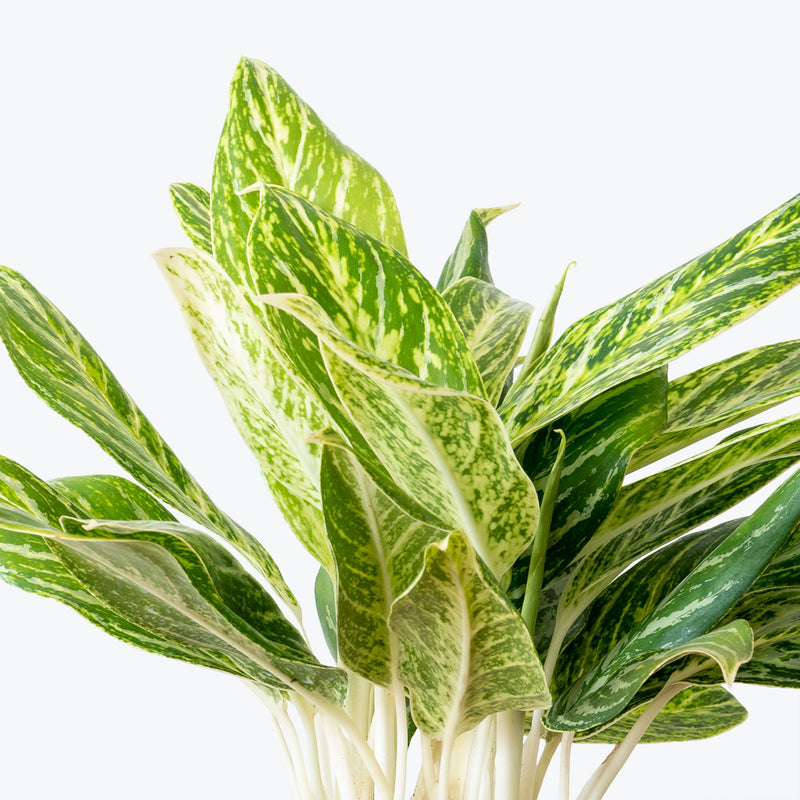
How to care for Chinese Evergreen Golden Madonna
Chinese Evergreen Golden Madonna should not be in a position to see the sun directly, although early morning or late evening sun is fine. Filtered sunlight through a sheer curtain is best and most homes are comprised primarily of indirect sunlight. The best spot for them is where they do not see the sun during the majority of the day but still get bright, indirect light.
Chinese Evergreen Golden Madonna will thrive in medium to bright light, but also can tolerate low light. A good medium-light place in your home would be in the middle of a room that has a regular size window. They can be placed almost anywhere in the room but remember, plants will grow based on how much light they receive.
Chinese Evergreen Golden Madonna needs to be watered when the top half of the soil is dry to the touch. That usually takes about 1 week in an average home environment. It will vary depending on the time of year, your environment and lighting conditions, but it's always safer to underwater or give the soil a check before you water again.
Chinese Evergreen Golden Madonna can live in any average home humidity condition and are fairly hardy.
Rotate Chinese Evergreen Golden Madonna every few weeks to encourage even growth and prevent leaning toward the light. Fertilize monthly during spring and summer with a diluted, balanced fertilizer. Wipe leaves occasionally to keep them dust-free and glossy.
Chinese Evergreen Golden Madonna is moderately toxic and can cause some adverse reactions when ingested so it is best to not let your pets eat it, which we advise for all plants in general. The severity of the reaction will depend on how much of the plant is ingested but, if you know your pet typically does not eat your plants, this plant will be suitable for your home..
Learn MoreView PlantChinese Evergreen Green Papaya

How to care for Chinese Evergreen Green Papaya
They should not be in a position to see the sun directly, although early morning or late evening sun is fine. Filtered sunlight through a sheer curtain is best and most homes are comprised primarily of indirect sunlight. The best spot for them is where they do not see the sun during the majority of the day but still get bright, indirect light.
They will thrive in bright light, but also can tolerate medium light. A good medium-light place in your home would be in the middle of a room that has a regular size window. They can be placed anywhere between the middle of the room and the window. Remember that plants will grow based on how much light they receive.
They need to be watered when the top half of the soil is dry to the touch. That usually takes about 1 week in an average home environment. It will vary depending on the time of year, your environment and lighting conditions, but it's always safer to underwater or give the soil a check before you water again.
They can live in any average home humidity condition and are fairly hardy.
If you mist it daily, or keep a humidifier around your plant, it will really help the health of the leaves. Or let it steam in the bathroom once in a while as you relax! Remember that plants in brighter light will need to be watered more often than those in lower light, and vice versa. If you are ever unsure if it is time to water, wait until the foliage is a little droopy before doing so.
This plant is moderately toxic and can cause some adverse reactions when ingested so it is best to not let your pets eat it, which we advise for all plants in general. The severity of the reaction will depend on how much of the plant is ingested but, if you know your pet typically does not eat your plants, this plant will be suitable for your home..
Learn MoreView PlantChinese Evergreen Indo Princess
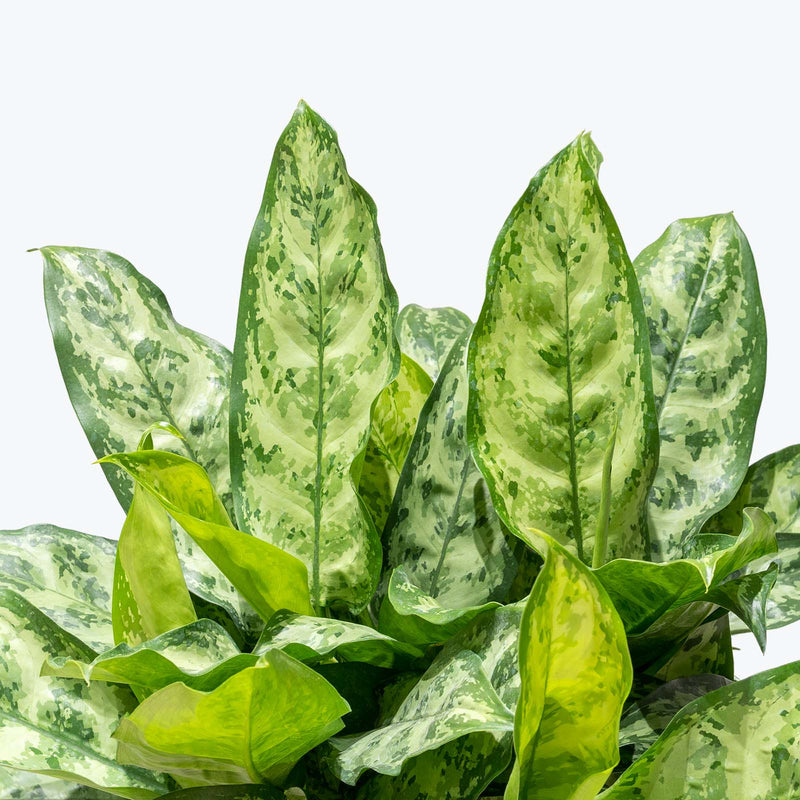
How to care for Chinese Evergreen Indo Princess
They should not be in a position to see the sun directly, although early morning or late evening sun is fine. Filtered sunlight through a sheer curtain is best and most homes are comprised primarily of indirect sunlight. The best spot for them is where they do not see the sun during the majority of the day but still get bright, indirect light.
They will thrive in medium to bright light, but also can tolerate low light. A good medium-light place in your home would be in the middle of a room that has a regular size window. They can be placed almost anywhere in the room but remember, plants will grow based on how much light they receive.
They need to be watered when the top half of the soil is dry to the touch. That usually takes about 1 week in an average home environment. It will vary depending on the time of year, your environment and lighting conditions, but it's always safer to underwater or give the soil a check before you water again.
They can live in any average home humidity condition and are fairly hardy.
If you mist it daily, or keep a humidifier around your plant, it will really help the health of the leaves. Or let it steam in the bathroom once in a while as you relax!
This plant is moderately toxic and can cause some adverse reactions when ingested so it is best to not let your pets eat it, which we advise for all plants in general. The severity of the reaction will depend on how much of the plant is ingested but, if you know your pet typically does not eat your plants, this plant will be suitable for your home..
Learn MoreView PlantChinese Evergreen Jubilee
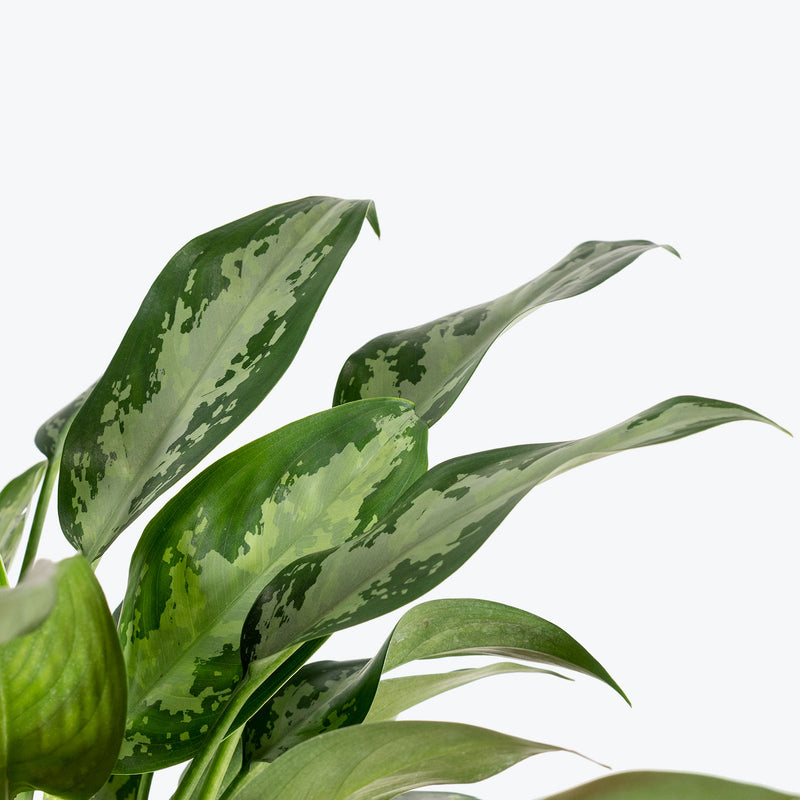
How to care for Chinese Evergreen Jubilee
They should not be in a position to see the sun directly, although early morning or late evening sun is fine. Filtered sunlight through a sheer curtain is best and most homes are comprised primarily of indirect sunlight. The best spot for them is where they do not see the sun during the majority of the day but still get bright, indirect light.
They will thrive in medium to bright light, but also can tolerate low light. A good medium-light place in your home would be in the middle of a room that has a regular size window. They can be placed almost anywhere in the room but remember, plants will grow based on how much light they receive.
They need to be watered when the top half of the soil is dry to the touch. That usually takes about 1 week in an average home environment. It will vary depending on the time of year, your environment and lighting conditions, but it's always safer to underwater or give the soil a check before you water again.
They can live in any average home humidity condition and are fairly hardy.
If you mist it daily, or keep a humidifier around your plant, it will really help the health of the leaves. Or let it steam in the bathroom once in a while as you relax!
This plant is moderately toxic and can cause some adverse reactions when ingested so it is best to not let your pets eat it, which we advise for all plants in general. The severity of the reaction will depend on how much of the plant is ingested but, if you know your pet typically does not eat your plants, this plant will be suitable for your home..
Learn MoreView PlantChinese Evergreen Juliette

How to care for Chinese Evergreen Juliette
They should not be in a position to see the sun directly, although early morning or late evening sun is fine. Filtered sunlight through a sheer curtain is best and most homes are comprised primarily of indirect sunlight. The best spot for them is where they do not see the sun during the majority of the day but still get bright, indirect light.
They will thrive in medium to bright light, but also can tolerate low light. A good medium-light place in your home would be in the middle of a room that has a regular size window. They can be placed almost anywhere in the room but remember, plants will grow based on how much light they receive.
They need to be watered when the top half of the soil is dry to the touch. That usually takes about 1 week in an average home environment. It will vary depending on the time of year, your environment and lighting conditions, but it's always safer to underwater or give the soil a check before you water again.
They can live in any average home humidity condition and are fairly hardy.
If you mist it daily, or keep a humidifier around your plant, it will really help the health of the leaves. Or let it steam in the bathroom once in a while as you relax!
This plant is moderately toxic and can cause some adverse reactions when ingested so it is best to not let your pets eat it, which we advise for all plants in general. The severity of the reaction will depend on how much of the plant is ingested but, if you know your pet typically does not eat your plants, this plant will be suitable for your home..
Learn MoreView PlantChinese Evergreen Lochai
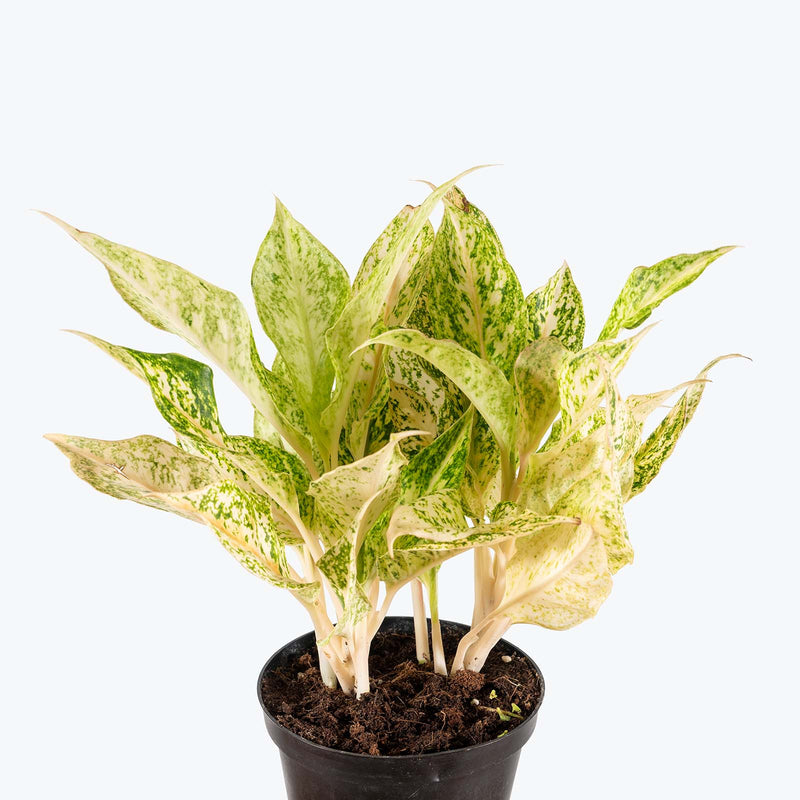
How to care for Chinese Evergreen Lochai
Chinese Evergreen Lochai should not be in a position to see the sun directly, although early morning or late evening sun is fine. Filtered sunlight through a sheer curtain is best and most homes are comprised primarily of indirect sunlight. The best spot for them is where they do not see the sun during the majority of the day but still get bright, indirect light.
Chinese Evergreen Lochai will do well in medium light but will grow faster with brighter light. A good medium-light place in your home would be in the middle of a room that has a regular size window. Remember that plants will grow based on how much light they receive.
Chinese Evergreen Lochai needs to be watered when the top half of the soil is dry to the touch. That usually takes about 1 week in an average home environment. It will vary depending on the time of year, your environment and lighting conditions, but it's always safer to underwater or give the soil a check before you water again.
Chinese Evergreen Lochai can live in any average home humidity condition and is fairly hardy.
Fertilize with a balanced, water-soluble fertilizer every 4-6 weeks during the growing season. Reduce feeding in the winter months when growth naturally slows. Clean the leaves occasionally with a damp cloth to remove dust and help the plant breathe and photosynthesize efficiently. If you mist Chinese Evergreen Lochai daily or keep a humidifier around your plant, it will really help the health of the leaves. Or let it steam in the bathroom once in a while as you relax!
Chinese Evergreen Lochai is moderately toxic and can cause some adverse reactions when ingested so it is best to not let your pets eat it, which we advise for all plants in general. The severity of the reaction will depend on how much of the plant is ingested but, if you know your pet typically does not eat your plants, this plant will be suitable for your home..
Learn MoreView PlantChinese Evergreen Maria
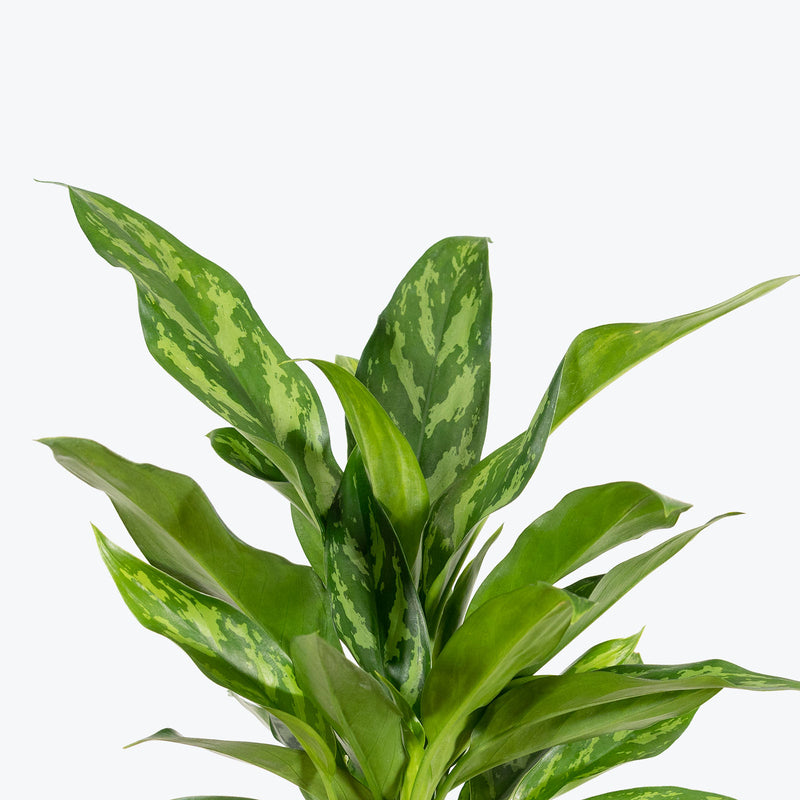
How to care for Chinese Evergreen Maria
Chinese Evergreen Maria should not be in a position to see the sun directly, although early morning or late evening sun is fine. Filtered sunlight through a sheer curtain is best and most homes are comprised primarily of indirect sunlight. The best spot for them is where they do not see the sun during the majority of the day but still get bright, indirect light.
Chinese Evergreen Maria will thrive in medium to bright light, but also can tolerate low light. A good medium-light place in your home would be in the middle of a room that has a regular size window. They can be placed almost anywhere in the room but remember, plants will grow based on how much light they receive.
Chinese Evergreen Maria needs to be watered when the top half of the soil is dry to the touch. That usually takes about 1 week in an average home environment. It will vary depending on the time of year, your environment and lighting conditions, but it's always safer to underwater or give the soil a check before you water again.
Chinese Evergreen Maria can live in any average home humidity condition and are fairly hardy.
Fertilize Chinese Evergreen Maria with a balanced, water-soluble fertilizer every two to three months during the growing season (spring to summer). During the winter, reduce fertilization as the plant's growth naturally slows down. Wipe the leaves occasionally with a damp cloth to remove dust and help the plant breathe and photosynthesize more efficiently.
Chinese Evergreen Maria is moderately toxic and can cause some adverse reactions when ingested so it is best to not let your pets eat it, which we advise for all plants in general. The severity of the reaction will depend on how much of the plant is ingested but, if you know your pet typically does not eat your plants, this plant will be suitable for your home..
Learn MoreView PlantChinese Evergreen Osaka White

How to care for Chinese Evergreen Osaka White
They should not be in a position to see the sun directly, although early morning or late evening sun is fine. Filtered sunlight through a sheer curtain is best and most homes are comprised primarily of indirect sunlight. The best spot for them is where they do not see the sun during the majority of the day but still get bright, indirect light.
They will thrive in medium to bright light, but also can tolerate low light. A good medium-light place in your home would be in the middle of a room that has a regular size window. They can be placed almost anywhere in the room but remember, plants will grow based on how much light they receive.
They need to be watered when the top half of the soil is dry to the touch. That usually takes about 1 week in an average home environment. It will vary depending on the time of year, your environment and lighting conditions, but it's always safer to underwater or give the soil a check before you water again.
They can live in any average home humidity condition and are fairly hardy.
If you mist it daily, or keep a humidifier around your plant, it will really help the health of the leaves. Or let it steam in the bathroom once in a while as you relax!
This plant is moderately toxic and can cause some adverse reactions when ingested so it is best to not let your pets eat it, which we advise for all plants in general. The severity of the reaction will depend on how much of the plant is ingested but, if you know your pet typically does not eat your plants, this plant will be suitable for your home..
Learn MoreView PlantChinese Evergreen Pink Dalmatian
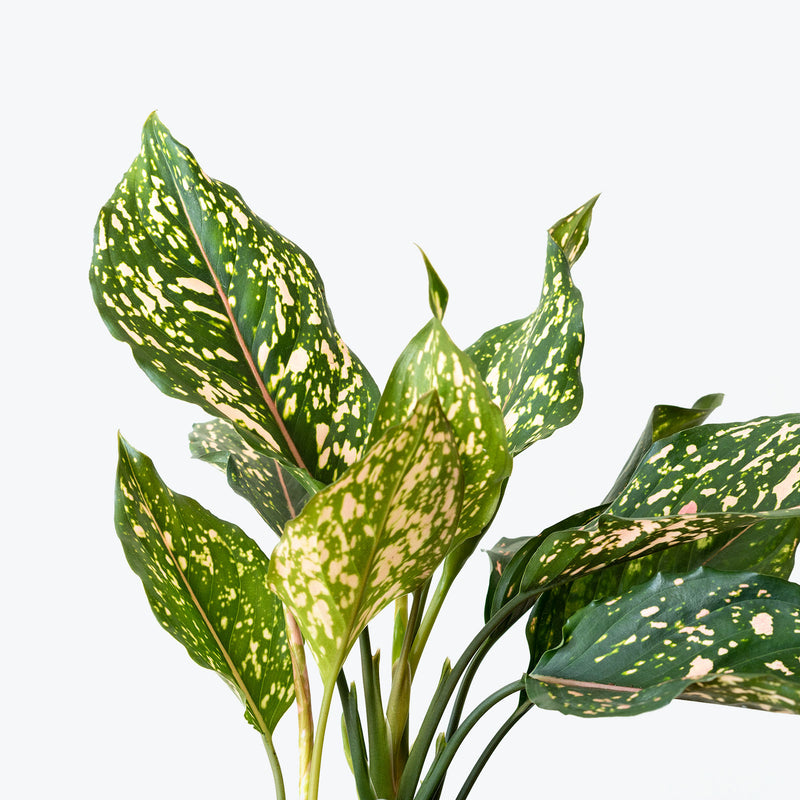
How to care for Chinese Evergreen Pink Dalmatian
They should not be in a position to see the sun directly, although early morning or late evening sun is fine. Filtered sunlight through a sheer curtain is best and most homes are comprised primarily of indirect sunlight. The best spot for them is where they do not see the sun during the majority of the day but still get bright, indirect light.
They will thrive in medium to bright light, but also can tolerate low light. A good medium-light place in your home would be in the middle of a room that has a regular size window. They can be placed almost anywhere in the room but remember, plants will grow based on how much light they receive.
They need to be watered when the top half of the soil is dry to the touch. That usually takes about 1 week in an average home environment. It will vary depending on the time of year, your environment and lighting conditions, but it's always safer to underwater or give the soil a check before you water again.
They can live in any average home humidity condition and are fairly hardy.
If you mist it daily, or keep a humidifier around your plant, it will really help the health of the leaves. Or let it steam in the bathroom once in a while as you relax!
This plant is moderately toxic and can cause some adverse reactions when ingested so it is best to not let your pets eat it, which we advise for all plants in general. The severity of the reaction will depend on how much of the plant is ingested but, if you know your pet typically does not eat your plants, this plant will be suitable for your home..
Learn MoreView PlantChinese Evergreen Pink Moon
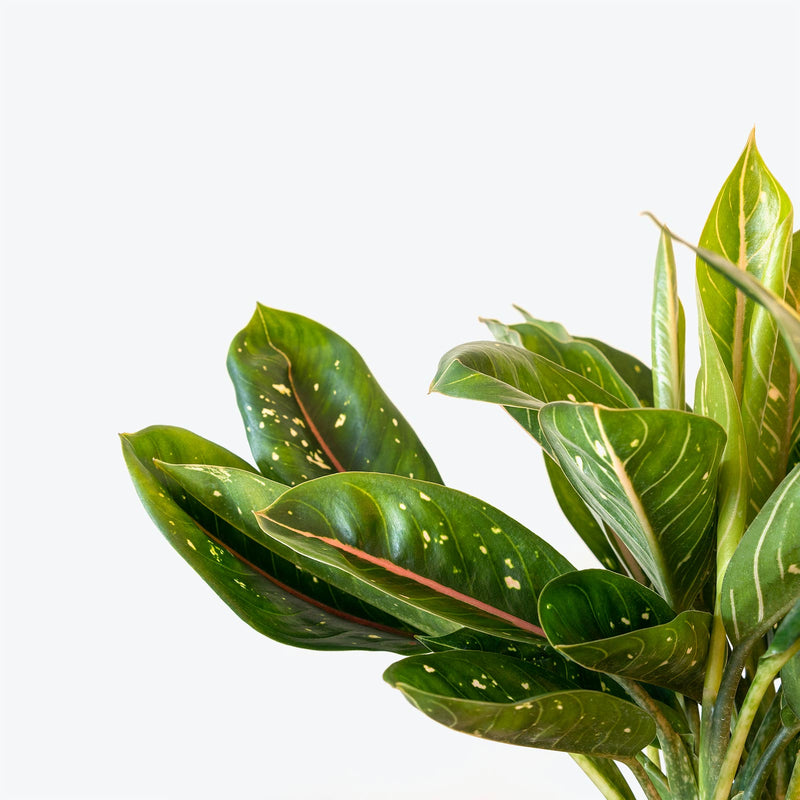
How to care for Chinese Evergreen Pink Moon
They should not be in a position to see the sun directly, although early morning or late evening sun is fine. Filtered sunlight through a sheer curtain is best and most homes are comprised primarily of indirect sunlight. The best spot for them is where they do not see the sun during the majority of the day but still get bright, indirect light.
They will thrive in medium to bright light, but also can tolerate low light. A good medium-light place in your home would be in the middle of a room that has a regular size window. They can be placed almost anywhere in the room but remember, plants will grow based on how much light they receive.
They need to be watered when the top half of the soil is dry to the touch. That usually takes about 1 week in an average home environment. It will vary depending on the time of year, your environment and lighting conditions, but it's always safer to underwater or give the soil a check before you water again.
They can live in any average home humidity condition and are fairly hardy.
If you mist it daily, or keep a humidifier around your plant, it will really help the health of the leaves. Or let it steam in the bathroom once in a while as you relax!
This plant is moderately toxic and can cause some adverse reactions when ingested so it is best to not let your pets eat it, which we advise for all plants in general. The severity of the reaction will depend on how much of the plant is ingested but, if you know your pet typically does not eat your plants, this plant will be suitable for your home..
Learn MoreView PlantChinese Evergreen Red Beauty

How to care for Chinese Evergreen Red Beauty
They should not be in a position to see the sun directly, although early morning or late evening sun is fine. Filtered sunlight through a sheer curtain is best and most homes are comprised primarily of indirect sunlight. The best spot for them is where they do not see the sun during the majority of the day but still get bright, indirect light.
They will do well in medium light but will grow faster with brighter light. A good medium-light place in your home would be in the middle of a room that has a regular size window. Remember that plants will grow based on how much light they receive.
They need to be watered when the top half of the soil is dry to the touch. That usually takes about 1 week in an average home environment. It will vary depending on the time of year, your environment and lighting conditions, but it's always safer to underwater or give the soil a check before you water again. Expect to water more often in brighter light and less often in lower light.
They can live in any average home humidity condition and are fairly hardy.
If you mist it daily, or keep a humidifier around your plant, it will really help the health of the leaves. Or let it steam in the bathroom once in a while as you relax! Remember that plants in brighter light will need to be watered more often than those in lower light, and vice versa. If you are ever unsure if it is time to water, wait until the foliage is a little droopy before doing so.
This plant is moderately toxic and can cause some adverse reactions when ingested so it is best to not let your pets eat it, which we advise for all plants in general. The severity of the reaction will depend on how much of the plant is ingested but, if you know your pet typically does not eat your plants, this plant will be suitable for your home..
Learn MoreView PlantChinese Evergreen Red Emerald
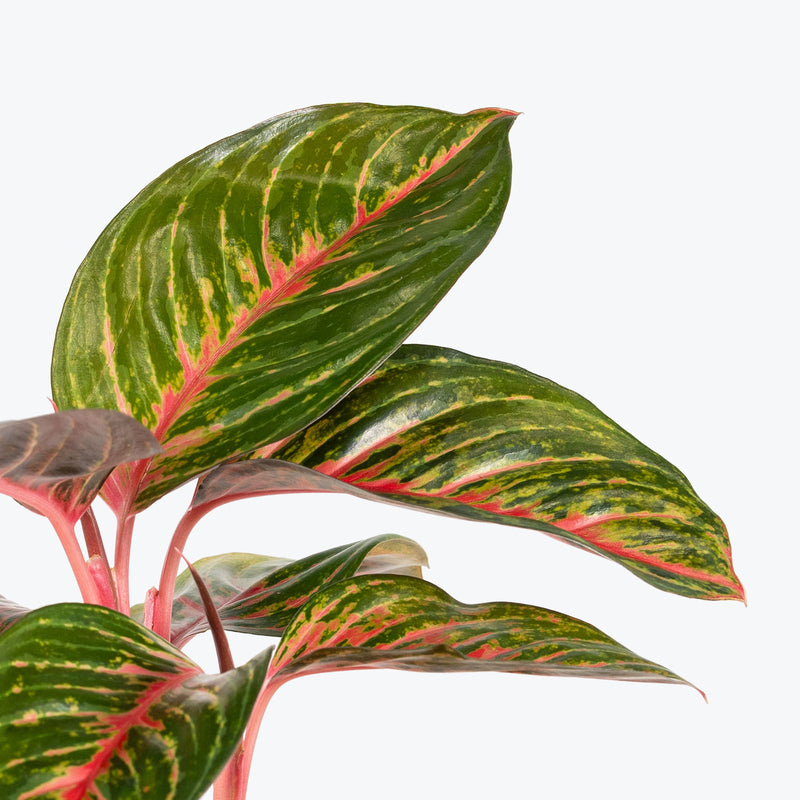
How to care for Chinese Evergreen Red Emerald
They should not be in a position to see the sun directly, although early morning or late evening sun is fine. Filtered sunlight through a sheer curtain is best and most homes are comprised primarily of indirect sunlight. The best spot for them is where they do not see the sun during the majority of the day but still get bright, indirect light.
They will thrive in medium to bright light, but also can tolerate low light. A good medium-light place in your home would be in the middle of a room that has a regular size window. They can be placed almost anywhere in the room but remember, plants will grow based on how much light they receive.
They need to be watered when the top half of the soil is dry to the touch. That usually takes about 1 week in an average home environment. It will vary depending on the time of year, your environment and lighting conditions, but it's always safer to underwater or give the soil a check before you water again. Expect to water more often in brighter light and less often in lower light.
They can live in any average home humidity condition and are fairly hardy.
If you mist it daily, or keep a humidifier around your plant, it will really help the health of the leaves. Or let it steam in the bathroom once in a while as you relax!
This plant is moderately toxic and can cause some adverse reactions when ingested so it is best to not let your pets eat it, which we advise for all plants in general. The severity of the reaction will depend on how much of the plant is ingested but, if you know your pet typically does not eat your plants, this plant will be suitable for your home..
Learn MoreView PlantChinese Evergreen Red Majesty
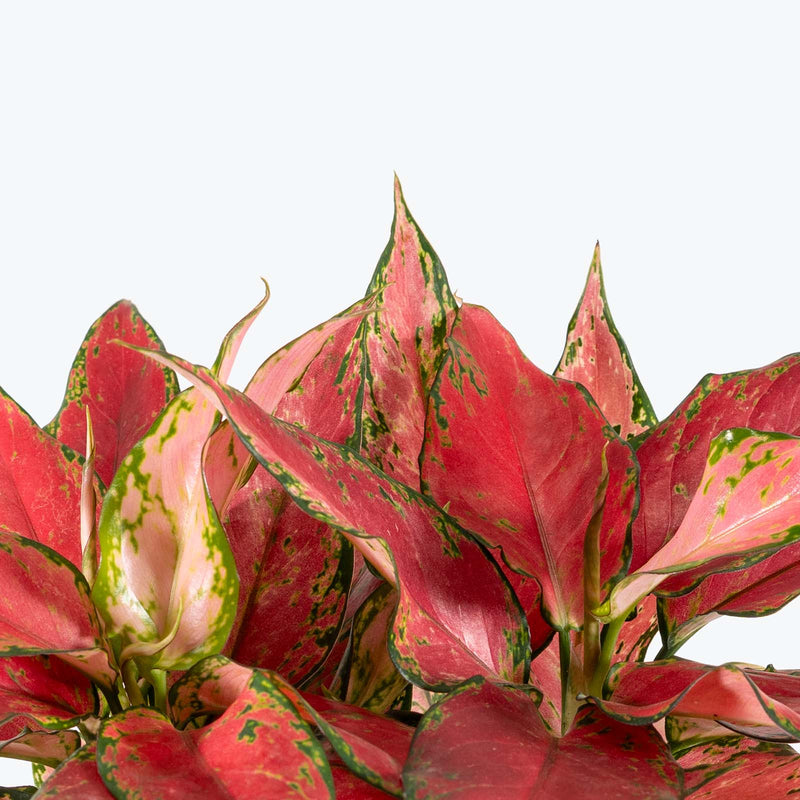
How to care for Chinese Evergreen Red Majesty
Chinese Evergreen Red Majesty should not be in a position to see the sun directly, although early morning or late evening sun is fine. Filtered sunlight through a sheer curtain is best and most homes are comprised primarily of indirect sunlight. The best spot for them is where they do not see the sun during the majority of the day but still get bright, indirect light.
Chinese Evergreen Red Majesty will thrive in medium to bright light, but also can tolerate low light. A good medium-light place in your home would be in the middle of a room that has a regular size window. They can be placed almost anywhere in the room but remember, plants will grow based on how much light they receive.
Chinese Evergreen Red Majesty needs to be watered when the top half of the soil is dry to the touch. That usually takes about 1 week in an average home environment. It will vary depending on the time of year, your environment and lighting conditions, but it's always safer to underwater or give the soil a check before you water again.
Chinese Evergreen Red Majesty will do well in average humidity environments but will appreciate a little bit of humidity if provided, give them a mist daily or get a humidifier.
If you mist Chinese Evergreen Red Majesty daily, or keep a humidifier around your plant, it will really help the health of the leaves. Or let it steam in the bathroom once in a while as you relax. Reduce feeding in the winter when growth slows. Clean the leaves occasionally with a damp cloth to remove dust and boost photosynthesis. Prune any yellowing or dead leaves to keep the plant looking its best.
Chinese Evergreen Red Majesty is moderately toxic and can cause some adverse reactions when ingested so it is best to not let your pets eat it, which we advise for all plants in general. The severity of the reaction will depend on how much of the plant is ingested but, if you know your pet typically does not eat your plants, this plant will be suitable for your home..
Learn MoreView PlantChinese Evergreen Red Siam
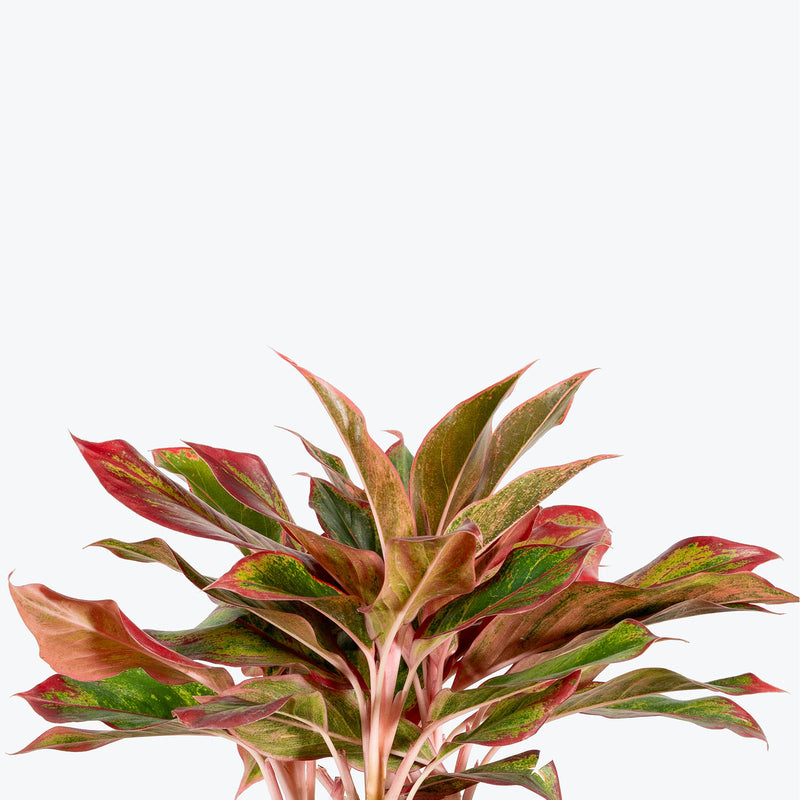
How to care for Chinese Evergreen Red Siam
Chinese Evergreen Red Siam should not be in a position to see the sun directly, although early morning or late evening sun is fine. Filtered sunlight through a sheer curtain is best and most homes are comprised primarily of indirect sunlight. The best spot for them is where they do not see the sun during the majority of the day but still get bright, indirect light.
Chinese Evergreen Red Siam will thrive in medium to bright light, but also can tolerate low light. A good medium-light place in your home would be in the middle of a room that has a regular size window. They can be placed almost anywhere in the room but remember, plants will grow based on how much light they receive.
Chinese Evergreen Red Siam needs to be watered when the top half of the soil is dry to the touch. That usually takes about 1 week in an average home environment. It will vary depending on the time of year, your environment and lighting conditions, but it's always safer to underwater or give the soil a check before you water again.
Chinese Evergreen Red Siam can live in any average home humidity condition and are fairly hardy.
Fertilize the Chinese Evergreen Red Siam every few months with a balanced, water-soluble fertilizer, especially during the growing season. Wipe the leaves occasionally to remove dust and maintain their vibrant colour. This plant is relatively low-maintenance, making it ideal for those who don't have a lot of time for plant care.
Chinese Evergreen Red Siam is moderately toxic and can cause some adverse reactions when ingested so it is best to not let your pets eat it, which we advise for all plants in general. The severity of the reaction will depend on how much of the plant is ingested but, if you know your pet typically does not eat your plants, this plant will be suitable for your home..
Learn MoreView PlantChinese Evergreen Red Wishes
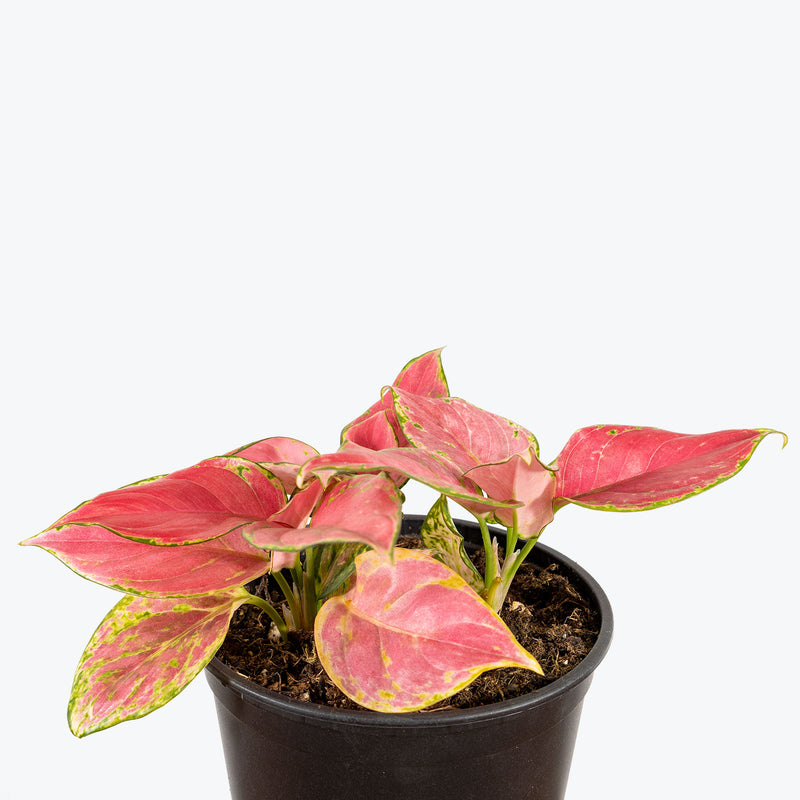
How to care for Chinese Evergreen Red Wishes
They should not be in a position to see the sun directly, although early morning or late evening sun is fine. Filtered sunlight through a sheer curtain is best and most homes are comprised primarily of indirect sunlight. The best spot for them is where they do not see the sun during the majority of the day but still get bright, indirect light.
They will thrive in medium to bright light, but also can tolerate low light. A good medium-light place in your home would be in the middle of a room that has a regular size window. They can be placed almost anywhere in the room but remember, plants will grow based on how much light they receive.
They need to be watered when the top half of the soil is dry to the touch. That usually takes about 1 week in an average home environment. It will vary depending on the time of year, your environment and lighting conditions, but it's always safer to underwater or give the soil a check before you water again.
They can live in any average home humidity condition and are fairly hardy.
If you mist it daily, or keep a humidifier around your plant, it will really help the health of the leaves. Or let it steam in the bathroom once in a while as you relax!
This plant is moderately toxic and can cause some adverse reactions when ingested so it is best to not let your pets eat it, which we advise for all plants in general. The severity of the reaction will depend on how much of the plant is ingested but, if you know your pet typically does not eat your plants, this plant will be suitable for your home..
Learn MoreView PlantChinese Evergreen Shades

How to care for Chinese Evergreen Shades
Chinese Evergreen Shades should not be in a position to see the sun directly, although early morning or late evening sun is fine. Filtered sunlight through a sheer curtain is best and most homes are comprised primarily of indirect sunlight. The best spot for them is where they do not see the sun during the majority of the day but still get bright, indirect light.
Chinese Evergreen Shades will thrive in medium to bright light, but also can tolerate low light. A good medium-light place in your home would be in the middle of a room that has a regular size window. They can be placed almost anywhere in the room but remember, plants will grow based on how much light they receive.
Chinese Evergreen Shades needs to be watered when the top half of the soil is dry to the touch. That usually takes about 1 week in an average home environment. It will vary depending on the time of year, your environment and lighting conditions, but it's always safer to underwater or give the soil a check before you water again.
Chinese Evergreen Shades can live in any average home humidity condition and are fairly hardy.
Fertilize Chinese Evergreen Shades with a balanced, liquid fertilizer every month during the growing season (spring and summer), reducing to every other month during the winter. Clean the leaves occasionally with a damp cloth to remove dust and enhance their shine. Be vigilant about pests such as spider mites and mealybugs, especially when the air is dry. If you mist it daily, or keep a humidifier around your plant, it will really help the health of the leaves. Or let it steam in the bathroom once in a while as you relax!
Chinese Evergreen Shades is moderately toxic and can cause some adverse reactions when ingested so it is best to not let your pets eat it, which we advise for all plants in general. The severity of the reaction will depend on how much of the plant is ingested but, if you know your pet typically does not eat your plants, this plant will be suitable for your home..
Learn MoreView PlantChinese Evergreen Siam Pink
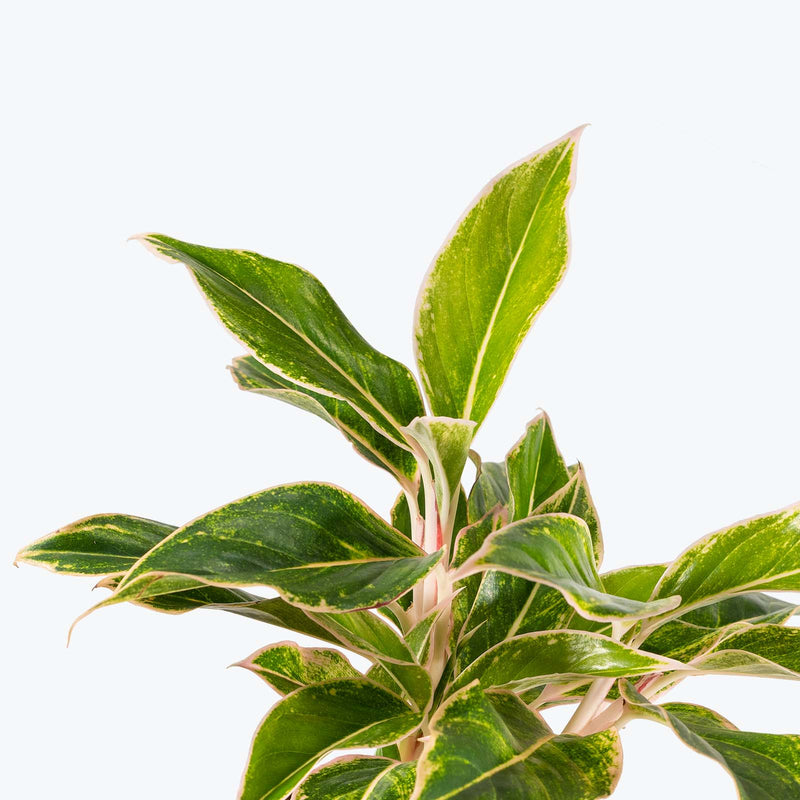
How to care for Chinese Evergreen Siam Pink
They should not be in a position to see the sun directly, although early morning or late evening sun is fine. Filtered sunlight through a sheer curtain is best and most homes are comprised primarily of indirect sunlight. The best spot for them is where they do not see the sun during the majority of the day but still get bright, indirect light.
They will thrive in medium to bright light, but also can tolerate low light. A good medium-light place in your home would be in the middle of a room that has a regular size window. They can be placed almost anywhere in the room but remember, plants will grow based on how much light they receive.
They need to be watered when the top half of the soil is dry to the touch. That usually takes about 1 week in an average home environment. It will vary depending on the time of year, your environment and lighting conditions, but it's always safer to underwater or give the soil a check before you water again. Expect to water more often in brighter light and less often in lower light.
They can live in any average home humidity condition and are fairly hardy.
If you want to bring out the vibrant pink edges of the Chinese Evergreen Siam Pink's leaves, it's best to place the plant in an area that receives bright indirect light. This will help to highlight the beautiful speckled green leaves and bring out the pink edges, making them more vivid and eye-catching.
This plant is moderately toxic and can cause some adverse reactions when ingested so it is best to not let your pets eat it, which we advise for all plants in general. The severity of the reaction will depend on how much of the plant is ingested but, if you know your pet typically does not eat your plants, this plant will be suitable for your home..
Learn MoreView PlantChinese Evergreen Silver Bay
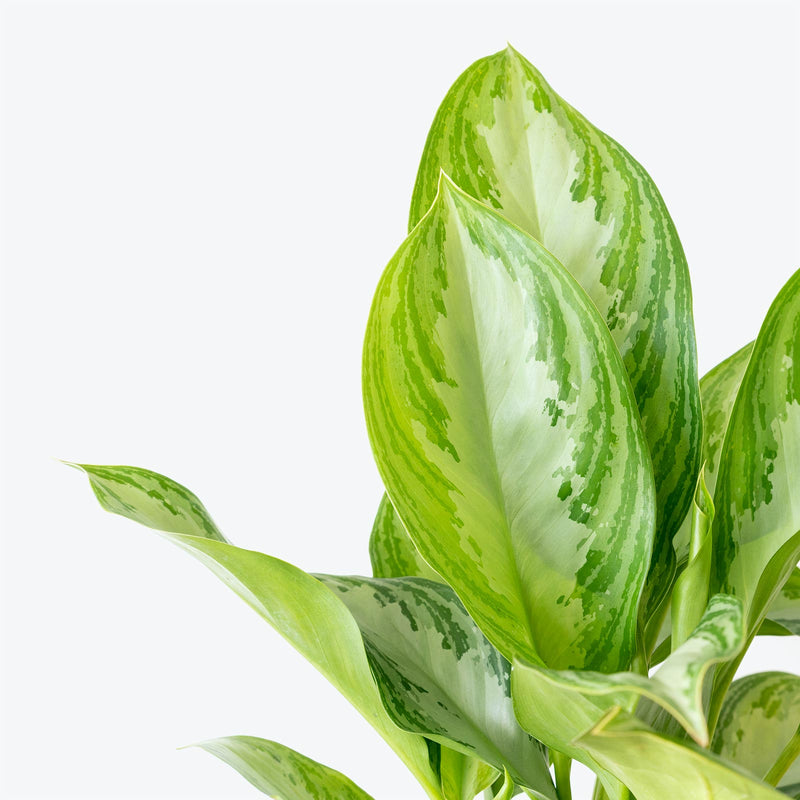
How to care for Chinese Evergreen Silver Bay
They should not be in a position to see the sun directly, although early morning or late evening sun is fine. Filtered sunlight through a sheer curtain is best and most homes are comprised primarily of indirect sunlight. The best spot for them is where they do not see the sun during the majority of the day but still get bright, indirect light.
They will thrive in medium to bright light, but also can tolerate low light. A good medium-light place in your home would be in the middle of a room that has a regular size window. They can be placed almost anywhere in the room but remember, plants will grow based on how much light they receive.
They need to be watered when the top half of the soil is dry to the touch. That usually takes about 1 week in an average home environment. It will vary depending on the time of year, your environment and lighting conditions, but it's always safer to underwater or give the soil a check before you water again.
They can live in any average home humidity condition and are fairly hardy.
If you mist it daily, or keep a humidifier around your plant, it will really help the health of the leaves. Or let it steam in the bathroom once in a while as you relax!
This plant is moderately toxic and can cause some adverse reactions when ingested so it is best to not let your pets eat it, which we advise for all plants in general. The severity of the reaction will depend on how much of the plant is ingested but, if you know your pet typically does not eat your plants, this plant will be suitable for your home..
Learn MoreView PlantChinese Evergreen Sparkling Sarah
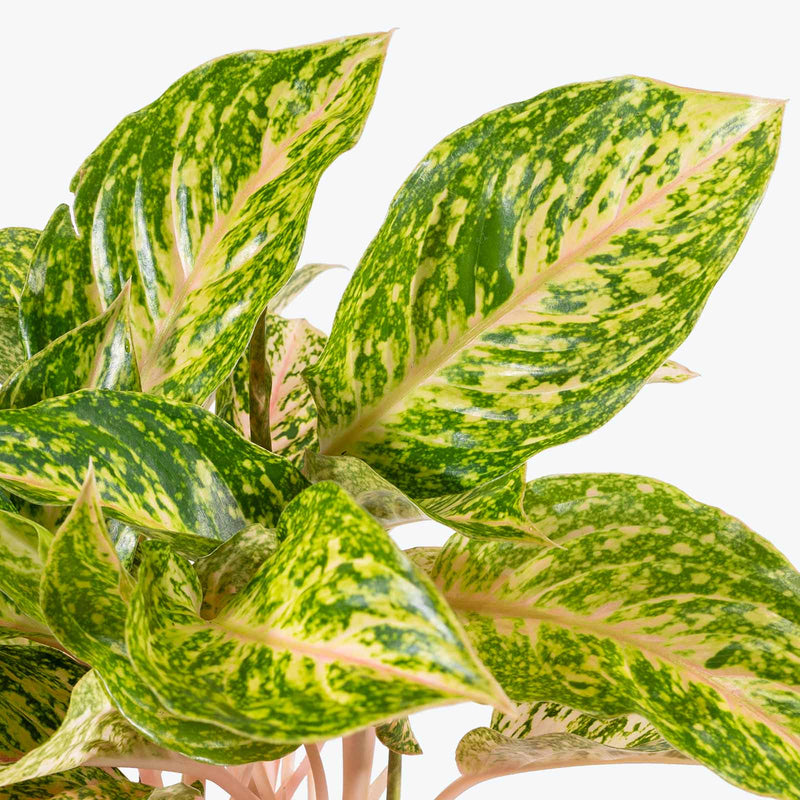
How to care for Chinese Evergreen Sparkling Sarah
They should not be in a position to see the sun directly, although early morning or late evening sun is fine. Filtered sunlight through a sheer curtain is best and most homes are comprised primarily of indirect sunlight. The best spot for them is where they do not see the sun during the majority of the day but still get bright, indirect light.
They will thrive in medium to bright light, but also can tolerate low light. A good medium-light place in your home would be in the middle of a room that has a regular size window. They can be placed almost anywhere in the room but remember, plants will grow based on how much light they receive.
They need to be watered when the top half of the soil is dry to the touch. That usually takes about 1 week in an average home environment. It will vary depending on the time of year, your environment and lighting conditions, but it's always safer to underwater or give the soil a check before you water again.
They can live in any average home humidity condition and are fairly hardy.
If you mist it daily, or keep a humidifier around your plant, it will really help the health of the leaves. Or let it steam in the bathroom once in a while as you relax!
This plant is moderately toxic and can cause some adverse reactions when ingested so it is best to not let your pets eat it, which we advise for all plants in general. The severity of the reaction will depend on how much of the plant is ingested but, if you know your pet typically does not eat your plants, this plant will be suitable for your home..
Learn MoreView PlantChinese Evergreen Stardust
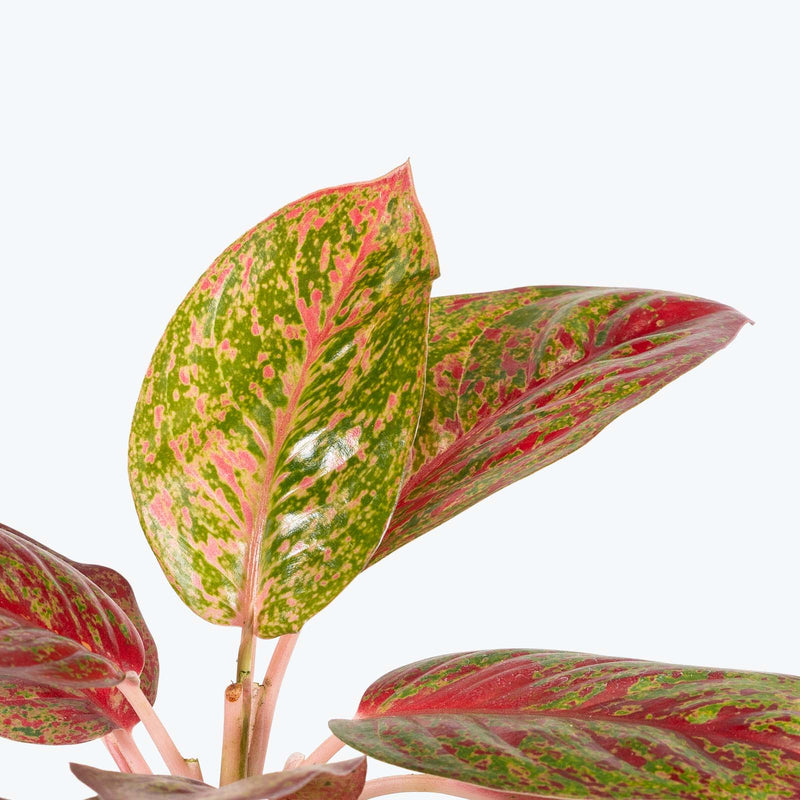
How to care for Chinese Evergreen Stardust
They should not be in a position to see the sun directly, although early morning or late evening sun is fine. Filtered sunlight through a sheer curtain is best and most homes are comprised primarily of indirect sunlight. The best spot for them is where they do not see the sun during the majority of the day but still get bright, indirect light.
They will do well in medium light but will grow faster with brighter light. A good medium-light place in your home would be in the middle of a room that has a regular size window. Remember that plants will grow based on how much light they receive.
They need to be watered when the top half of the soil is dry to the touch. That usually takes about 1 week in an average home environment. It will vary depending on the time of year, your environment and lighting conditions, but it's always safer to underwater or give the soil a check before you water again. Expect to water more often in brighter light and less often in lower light.
They can live in any average home humidity condition and are fairly hardy.
If you mist it daily, or keep a humidifier around your plant, it will really help the health of the leaves. Or let it steam in the bathroom once in a while as you relax! Remember that plants in brighter light will need to be watered more often than those in lower light, and vice versa. If you are ever unsure if it is time to water, wait until the foliage is a little droopy before doing so.
This plant is moderately toxic and can cause some adverse reactions when ingested so it is best to not let your pets eat it, which we advise for all plants in general. The severity of the reaction will depend on how much of the plant is ingested but, if you know your pet typically does not eat your plants, this plant will be suitable for your home..
Learn MoreView PlantChinese Evergreen Stripes
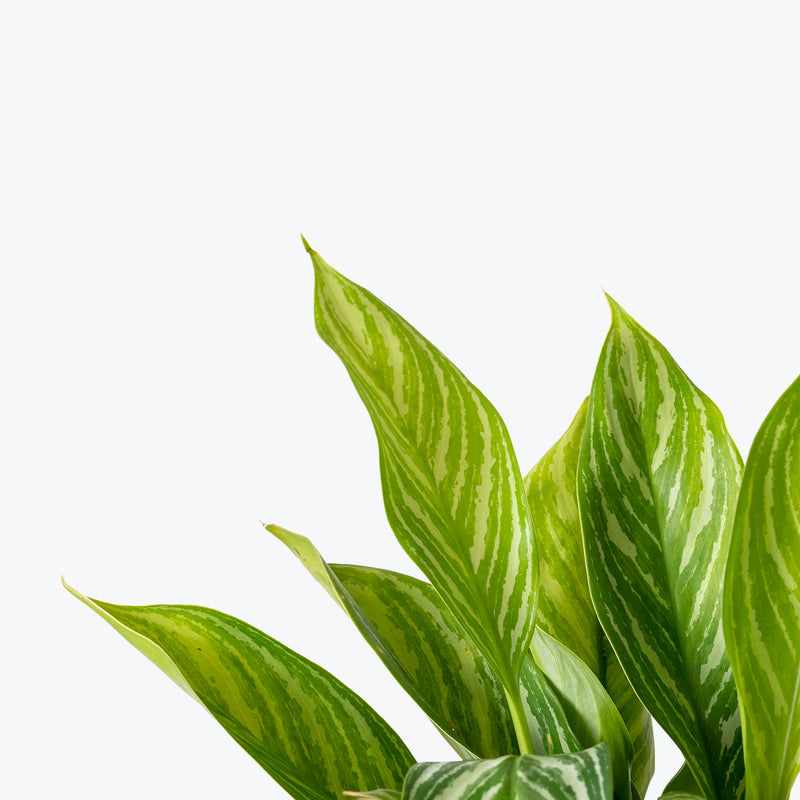
How to care for Chinese Evergreen Stripes
They should not be in a position to see the sun directly, although early morning or late evening sun is fine. Filtered sunlight through a sheer curtain is best and most homes are comprised primarily of indirect sunlight. The best spot for them is where they do not see the sun during the majority of the day but still get bright, indirect light.
They will thrive in medium to bright light, but also can tolerate low light. A good medium-light place in your home would be in the middle of a room that has a regular size window. They can be placed almost anywhere in the room but remember, plants will grow based on how much light they receive.
They need to be watered when the top half of the soil is dry to the touch. That usually takes about 1 week in an average home environment. It will vary depending on the time of year, your environment and lighting conditions, but it's always safer to underwater or give the soil a check before you water again.
They can live in any average home humidity condition and are fairly hardy.
If you mist it daily, or keep a humidifier around your plant, it will really help the health of the leaves. Or let it steam in the bathroom once in a while as you relax!
This plant is moderately toxic and can cause some adverse reactions when ingested so it is best to not let your pets eat it, which we advise for all plants in general. The severity of the reaction will depend on how much of the plant is ingested but, if you know your pet typically does not eat your plants, this plant will be suitable for your home..
Learn MoreView PlantChinese Evergreen Valentine

How to care for Chinese Evergreen Valentine
Chinese Evergreen Valentine should not be in a position to see the sun directly, although early morning or late evening sun is fine. Filtered sunlight through a sheer curtain is best and most homes are comprised primarily of indirect sunlight. The best spot for them is where they do not see the sun during the majority of the day but still get bright, indirect light.
Chinese Evergreen Valentine will thrive in medium to bright light, but also can tolerate low light. A good medium-light place in your home would be in the middle of a room that has a regular size window. They can be placed almost anywhere in the room but remember, plants will grow based on how much light they receive.
Chinese Evergreen Valentine needs to be watered when the top half of the soil is dry to the touch. That usually takes about 1 week in an average home environment. It will vary depending on the time of year, your environment and lighting conditions, but it's always safer to underwater or give the soil a check before you water again.
Chinese Evergreen Valentine can live in any average home with humidity conditions and is fairly hardy.
Fertilize Chinese Evergreen Valentine with a balanced liquid fertilizer every 4-6 weeks during the growing season. Reduce feeding in the winter months when growth naturally slows. Clean the leaves occasionally with a damp cloth to remove dust and help the plant breathe and photosynthesize efficiently. If you mist it daily or keep a humidifier around your plant, it will really help the health of the leaves. Or let it steam in the bathroom once in a while as you relax!
Chinese Evergreen Valentine is moderately toxic and can cause some adverse reactions when ingested so it is best to not let your pets eat it, which we advise for all plants in general. The severity of the reaction will depend on how much of the plant is ingested but, if you know your pet typically does not eat your plants, this plant will be suitable for your home..
Learn MoreView PlantChinese Evergreen Watermelon
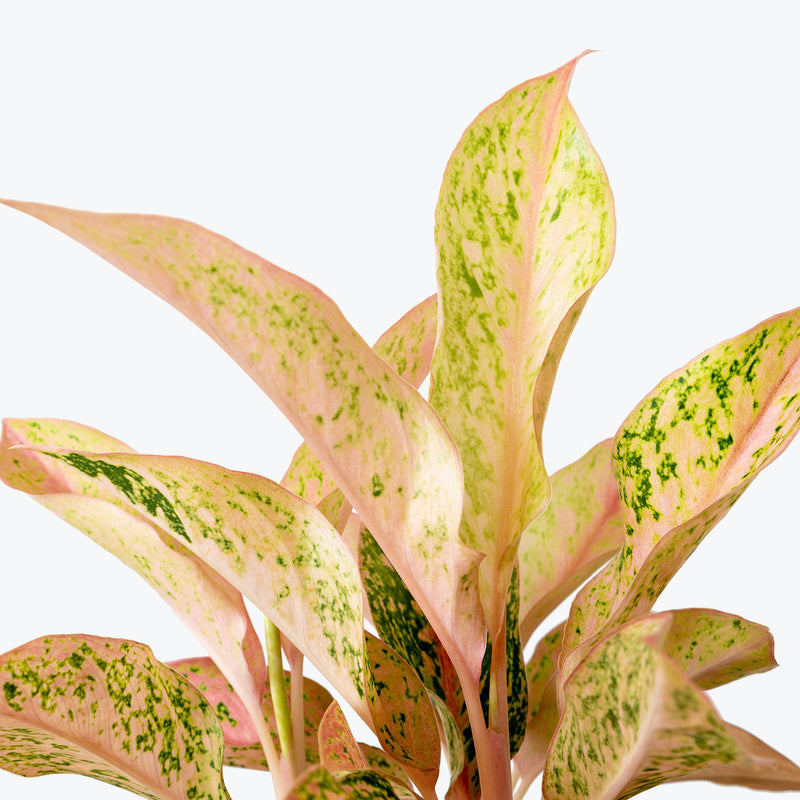
How to care for Chinese Evergreen Watermelon
They should not be in a position to see the sun directly, although early morning or late evening sun is fine. Filtered sunlight through a sheer curtain is best and most homes are comprised primarily of indirect sunlight. The best spot for them is where they do not see the sun during the majority of the day but still get bright, indirect light.
They will thrive in medium to bright light, but also can tolerate low light. A good medium-light place in your home would be in the middle of a room that has a regular size window. They can be placed almost anywhere in the room but remember, plants will grow based on how much light they receive.
They need to be watered when the top half of the soil is dry to the touch. That usually takes about 1 week in an average home environment. It will vary depending on the time of year, your environment and lighting conditions, but it's always safer to underwater or give the soil a check before you water again.
They can live in any average home humidity condition and are fairly hardy.
If you mist it daily, or keep a humidifier around your plant, it will really help the health of the leaves. Or let it steam in the bathroom once in a while as you relax!
This plant is moderately toxic and can cause some adverse reactions when ingested so it is best to not let your pets eat it, which we advise for all plants in general. The severity of the reaction will depend on how much of the plant is ingested but, if you know your pet typically does not eat your plants, this plant will be suitable for your home..
Learn MoreView PlantChinese Fan Palm
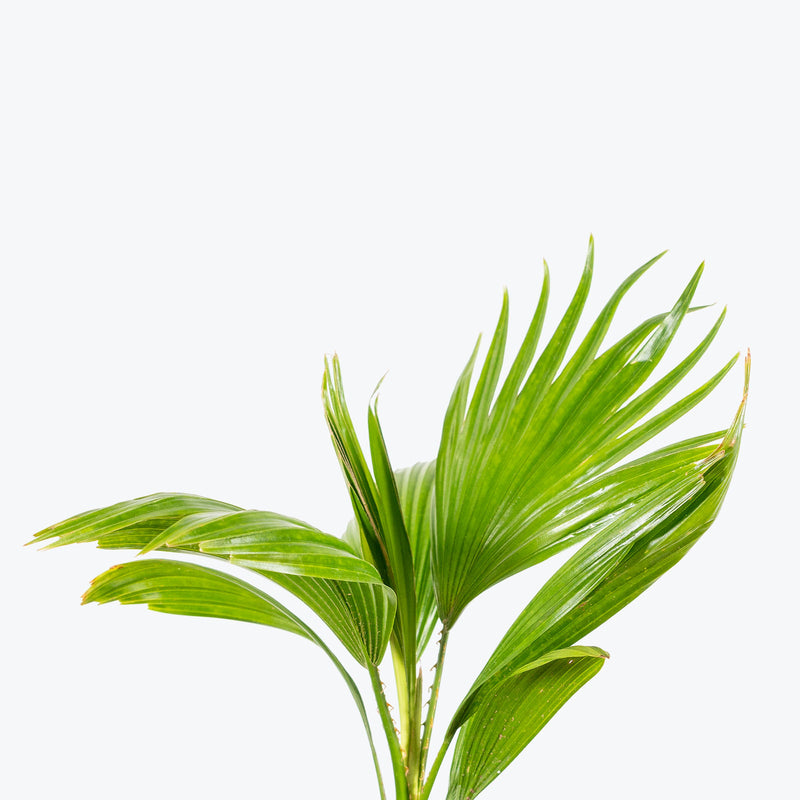
How to care for Chinese Fan Palm
They enjoy some direct sun, but they'll also do well in bright, indirect light. It is best to place this plant somewhere where it will receive some nice morning sun, or a couple hours of afternoon sun, and then indirect light the rest of the day.
They will do best in bright light. A nice bright place inside your home would be on the window sill or a stool that is right next to a window, either with or without blinds, depending on if the plant can handle sun. Remember that plants will grow based on how much light they receive.
They need to be watered when the top half of the soil is dry to the touch. That usually takes about 1 week in an average home environment. It will vary depending on the time of year, your environment and lighting conditions, but it's always safer to underwater or give the soil a check before you water again. Expect to water more often in brighter light and less often in lower light.
They will do well in average humidity environments but will appreciate a little bit of humidity if provided, give them a mist daily or get a humidifier.
Make sure to shower off your plant every once in a while as the large leaves can pick up dust easily which can make them prone to spider mites. In addition to this, try not to repot your plant too often as they are slow-growers and disrupt their fragile roots more often than is necessary.
You can feel comfortable having this plant around your home in the potential case where your pet feels like nibbling on it. However, we typically recommend keeping your pets from eating any of your houseplants..
Learn MoreView PlantChinese Perfume Plant

How to care for Chinese Perfume Plant
Chinese Perfume Plant enjoys some direct sun, but they'll also do well in bright, indirect light. It is best to place this plant somewhere where it will receive some nice morning sun, or a couple hours of afternoon sun, and then indirect light the rest of the day.
Chinese Perfume Plant will thrive in bright light, but also can tolerate medium light. A good medium-light place in your home would be in the middle of a room that has a regular size window. They can be placed anywhere between the middle of the room and the window. Remember that plants will grow based on how much light they receive.
Chinese Perfume Plant needs to be watered when the top half of the soil is dry to the touch. That usually takes about 1 week in an average home environment. It will vary depending on the time of year, your environment and lighting conditions, but it's always safer to underwater or give the soil a check before you water again. Expect to water more often in brighter light and less often in lower light.
Chinese Perfume Plant will do well in average humidity environments but will appreciate a little bit of humidity if provided, give them a mist daily or get a humidifier.
Prune Chinese Perfume Plant lightly after flowering to shape and encourage branching. Fertilize with a balanced or bloom-boosting fertilizer every 4–6 weeks during the growing season to promote frequent flowering. Protect from cold drafts—this plant thrives in warmth and may struggle below 50°F (10°C).
Chinese Perfume Plant is moderately toxic and can cause some adverse reactions when ingested so it is best to not let your pets eat it, which we advise for all plants in general. The severity of the reaction will depend on how much of the plant is ingested but, if you know your pet typically does not eat your plants, this plant will be suitable for your home..
View PlantChlorophytum Mandarin
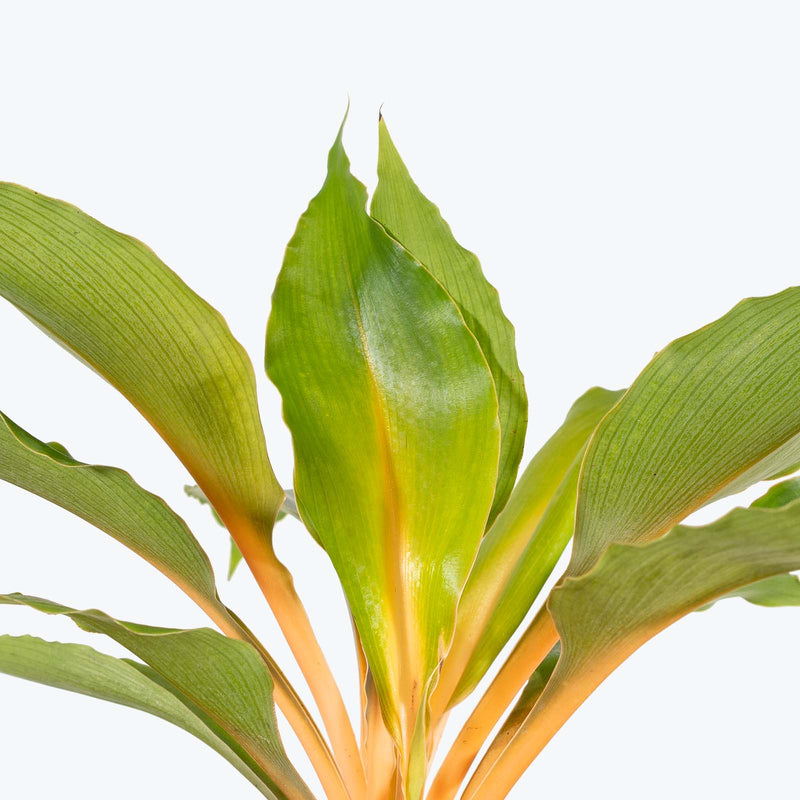
How to care for Chlorophytum Mandarin
They should not be in a position to see the sun directly, as it is too intense for them. Filtered sunlight through a sheer curtain is fine and most homes are comprised primarily of indirect sunlight. The best spot for them is where they do not see the sun during the majority of the day but still get bright, indirect light.
They can handle low light, but will grow faster and fuller with brighter light. A low light plant can pretty much survive any place inside your home as long as you have a window in the room. Remember, low light does not mean no light and plants will grow based on how much light they receive.
They need to be watered when the top half of the soil is dry to the touch. That usually takes about 1 week in an average home environment. It will vary depending on the time of year, your environment and lighting conditions, but it's always safer to underwater or give the soil a check before you water again. Expect to water more often in brighter light and less often in lower light.
They can live in any average home humidity condition and are fairly hardy.
Like spider plant, it can be sensitive to too much fluoride in the water. If you see the leaves develop yellow, brown, or black edges, this is often the result of fluoride found in water, which causes salt buildup in the soil. If this is the case, allow the water to sit out overnight before watering, or use rain or distilled water.
You can feel comfortable having this plant around your home in the potential case where your pet feels like nibbling on it. However, we typically recommend keeping your pets from eating any of your houseplants..
View PlantCinnamon Plant

How to care for Cinnamon Plant
Cinnamon Plant loves as much sun as possible. The best spot for them is where they can see the sun during the majority of the day.
Cinnamon Plant will do their best and flower profusely in bright light. A nice bright place outside would be on a sunny balcony, deck, or backyard; inside your home, it would do best in a sunny window sill. Remember that plants will grow and flower based on how much light they receive.
Allow the top quarter of the soil to dry before watering again. This usually takes about 3 - 4 days in an average home environment. It will vary depending on the time of year, your environment and lighting conditions. Expect to water Cinnamon Plant more often in brighter light and less often in lower light.
Cinnamon Plant will do well in average humidity environments but will appreciate a little bit of humidity if provided, give them a mist daily or get a humidifier.
Fertilize your Cinnamon Plant every 4-6 weeks during the growing season with a balanced, all-purpose fertilizer. Prune regularly to promote a bushy growth habit and to prevent the tree from becoming leggy. If grown for spice production, harvest the inner bark by scraping the stems during the dry season.
You can feel comfortable having Cinnamon Plant around your home in the potential case where your pet feels like nibbling on it. However, we typically recommend keeping your pets from eating any of your houseplants..
View PlantCissus Striata
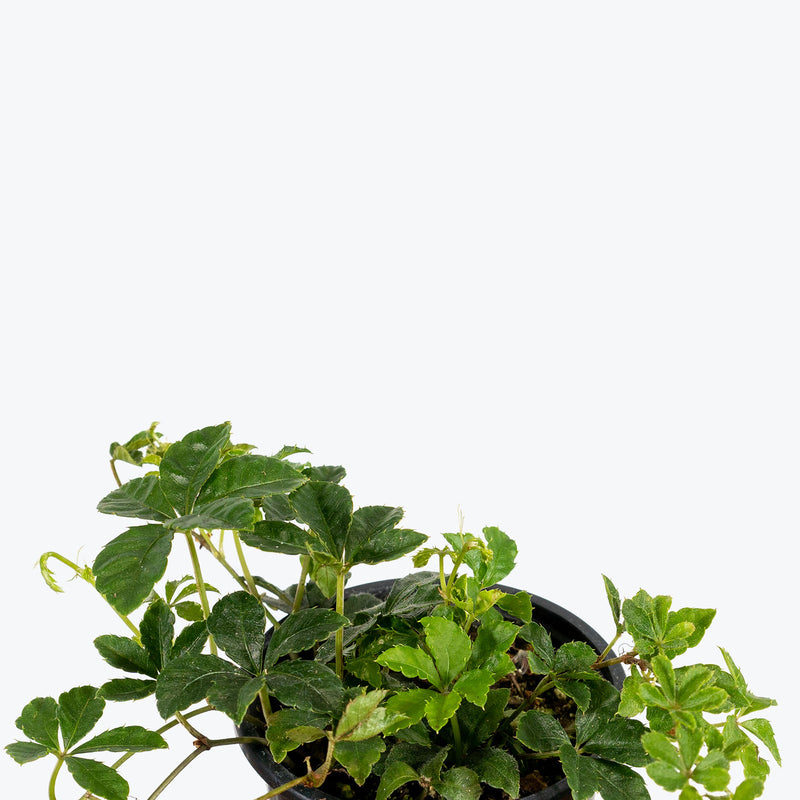
How to care for Cissus Striata
They should not be in a position to see the sun directly, although early morning or late evening sun is fine. Filtered sunlight through a sheer curtain is best and most homes are comprised primarily of indirect sunlight. The best spot for them is where they do not see the sun during the majority of the day but still get bright, indirect light.
They will thrive in bright light, but also can tolerate medium light. A good medium-light place in your home would be in the middle of a room that has a regular size window. They can be placed anywhere between the middle of the room and the window. Remember that plants will grow based on how much light they receive.
They need to be watered when the top half of the soil is dry to the touch. That usually takes about 1 week in an average home environment. It will vary depending on the time of year, your environment and lighting conditions, but it's always safer to underwater or give the soil a check before you water again. Expect to water more often in brighter light and less often in lower light.
They will do well in average humidity environments but will appreciate a little bit of humidity if provided, give them a mist daily or get a humidifier.
Fertilize your plant once a month during its active growing season, which is generally the spring and summer months. As a bonus, these little guys are pet-friendly, not toxic to our furry friends!
You can feel comfortable having this plant around your home in the potential case where your pet feels like nibbling on it. However, we typically recommend keeping your pets from eating any of your houseplants..
View PlantClusia Rosea

How to care for Clusia Rosea
Clusia Rosea should not be in a position to see the sun directly, although early morning or late evening sun is fine. Filtered sunlight through a sheer curtain is best and most homes are comprised primarily of indirect sunlight. The best spot for them is where they do not see the sun during the majority of the day but still get bright, indirect light.
Clusia Rosea will thrive in bright light, but also can tolerate medium light. A good medium-light place in your home would be in the middle of a room that has a regular size window. They can be placed anywhere between the middle of the room and the window. Remember that plants will grow based on how much light they receive.
Clusia Rosea likes the soil to be relatively dry before the next watering. That usually takes about 2 weeks in an average home environment. It will vary depending on the time of year, your environment and lighting conditions, but for them, it's always safer to underwater or water when you see signs of lack of water (i.e. droopy, floppy, or soft leaves). Expect to water more often in brighter light and less often in lower light.
Clusia Rosea will do well in average humidity environments but will appreciate a little bit of humidity if provided, give them a mist daily or get a humidifier.
Plant in a well-draining soil mix and avoid overwatering, as Clusia Rosea doesn't like soggy roots. Prune occasionally to maintain a compact shape. If growing outdoors in warm climates, it can adapt as a hedge or small tree. Indoors, a regular feeding every 4–6 weeks in spring and summer encourages healthy growth.
Clusia Rosea is moderately toxic and can cause some adverse reactions when ingested so it is best to not let your pets eat it, which we advise for all plants in general. The severity of the reaction will depend on how much of the plant is ingested but, if you know your pet typically does not eat your plants, this plant will be suitable for your home..
View PlantCoconut Palm
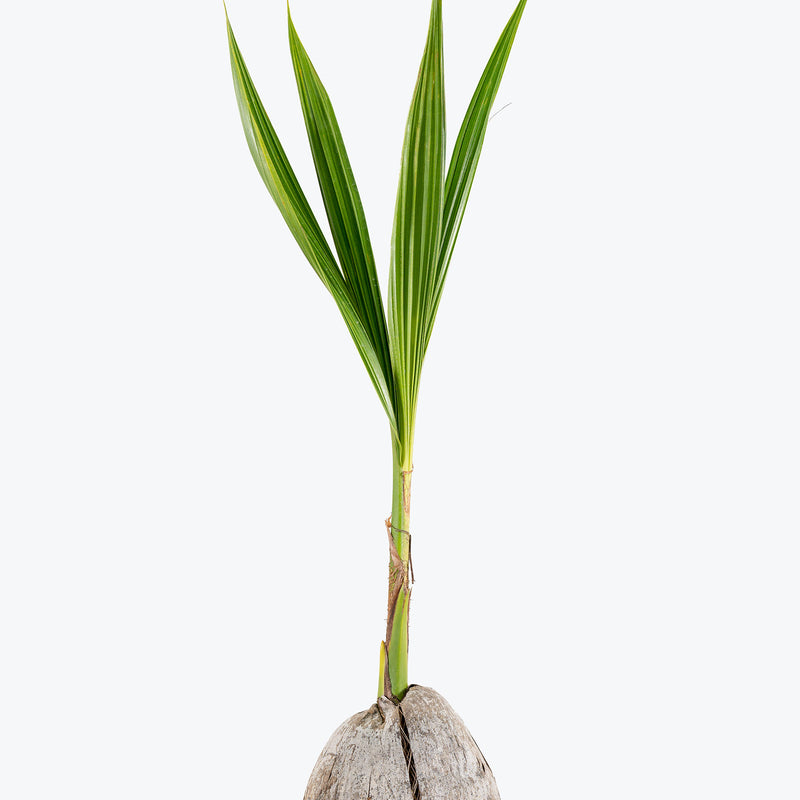
How to care for Coconut Palm
They love as much sun as possible. The best spot for them is where they can see the sun during the majority of the day.
They will do best in bright light. A nice bright place inside your home would be on the window sill or a stool that is right next to a window, either with or without blinds, depending on if the plant can handle sun. Remember that plants will grow based on how much light they receive.
They like the soil to stay consistently moist, but not soaking wet. Give them water whenever just the surface of the soil is starting to get dry.
They like a high humidity environment, give them a mist as often as possible, daily at a minimum. Alternatively, you can put them around a humidifier.
If your plant has roots coming out of the bottom of the pot, repot it into a larger pot! Water them with lukewarm, distilled or rain water if possible.
This plant is moderately toxic and can cause some adverse reactions when ingested so it is best to not let your pets eat it, which we advise for all plants in general. The severity of the reaction will depend on how much of the plant is ingested but, if you know your pet typically does not eat your plants, this plant will be suitable for your home..
Learn MoreView PlantCoffee Plant
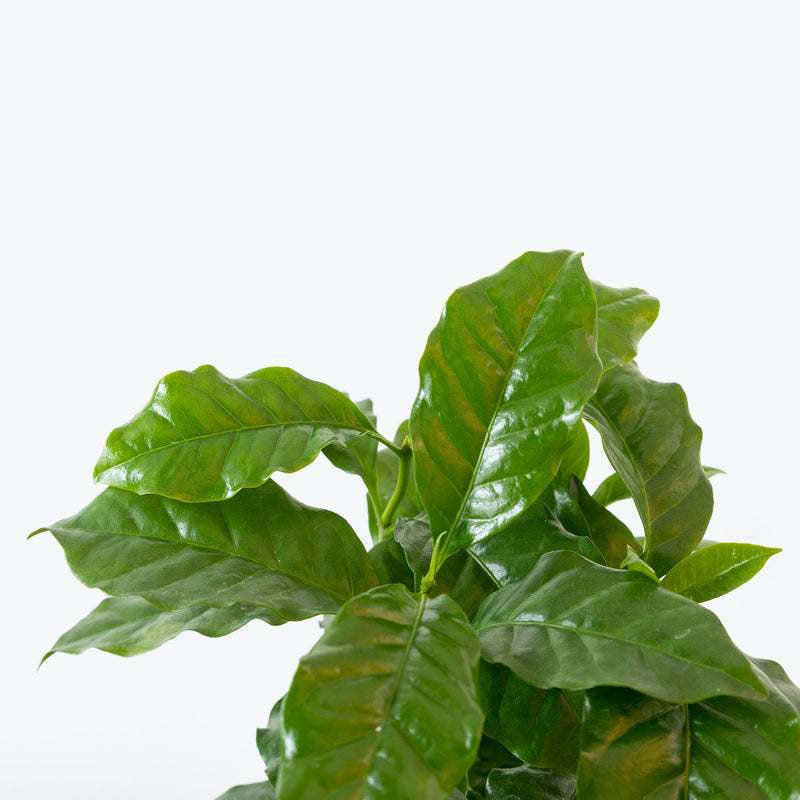
How to care for Coffee Plant
Coffee Plant should not be in a position to see the sun directly, although early morning or late evening sun is fine. Filtered sunlight through a sheer curtain is best and most homes are comprised primarily of indirect sunlight. The best spot for them is where they do not see the sun during the majority of the day but still get bright, indirect light.
Coffee Plant will thrive in bright light, but also can tolerate medium light. A good medium-light place in your home would be in the middle of a room that has a regular size window. They can be placed anywhere between the middle of the room and the window. Remember that plants will grow based on how much light they receive.
Coffee Plant needs to be watered when the top half of the soil is dry to the touch. That usually takes about 1 week in an average home environment. It will vary depending on the time of year, your environment and lighting conditions, but give the soil a check before you water again.
Coffee Plant likes a high humidity environment, give them a mist daily or as often as possible. Alternatively, you can put them around a humidifier. Although they won't die if they don't receive enough humidity, their leaves may have some dry, crunchy, or yellow edges.
Setting your coffee plant on a water-filled pebble tray will help with humidity. Like many houseplants, a coffee plant will need more water in the summer than in the winter.
Coffee Plant is moderately toxic and can cause some adverse reactions when ingested so it is best to not let your pets eat it, which we advise for all plants in general. The severity of the reaction will depend on how much of the plant is ingested but, if you know your pet typically does not eat your plants, this plant will be suitable for your home..
View PlantCojoba Arborea
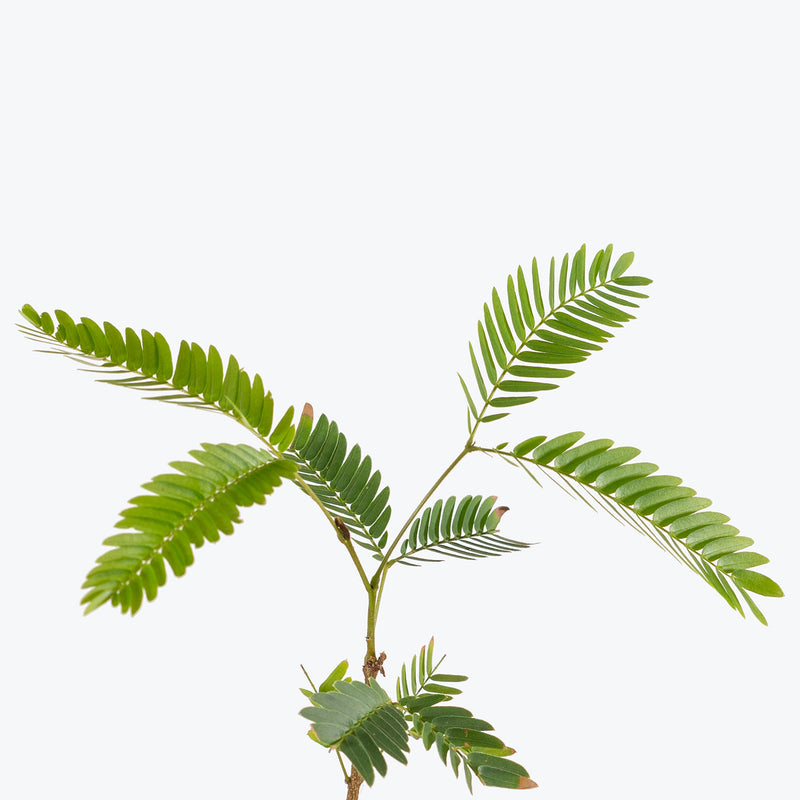
How to care for Cojoba Arborea
Cojoba Arborea should not be in a position to see the sun directly, although early morning or late evening sun is fine. Filtered sunlight through a sheer curtain is best and most homes are comprised primarily of indirect sunlight. The best spot for them is where they do not see the sun during the majority of the day but still get bright, indirect light.
Cojoba Arborea will do best in bright light. A nice bright place inside your home would be on the window sill or a stool that is right next to a window, either with or without blinds, depending on if the plant can handle sun. Remember that plants will grow based on how much light they receive.
Cojoba Arborea needs to be watered when the top half of the soil is dry to the touch. That usually takes about 1 week in an average home environment. It will vary depending on the time of year, your environment and lighting conditions, but it's always safer to underwater or give the soil a check before you water again. Expect to water more often in brighter light and less often in lower light.
Cojoba Arborea will do well in average humidity environments but will appreciate a little bit of humidity if provided, give them a mist daily or get a humidifier.
Cojoba Arborea appreciates a well-draining, loamy mix. Prune the tip to encourage strong structure and thick stems. Fertilize monthly during the growing season with a balanced, liquid plant food. In warmer regions, it can be planted in-ground and will mature into a striking, airy shade tree. Indoors, provide ample root space and support its tree-like form with a sturdy container.
Cojoba Arborea is moderately toxic and can cause some adverse reactions when ingested so it is best to not let your pets eat it, which we advise for all plants in general. The severity of the reaction will depend on how much of the plant is ingested but, if you know your pet typically does not eat your plants, this plant will be suitable for your home..
View PlantColocasia Black Runner
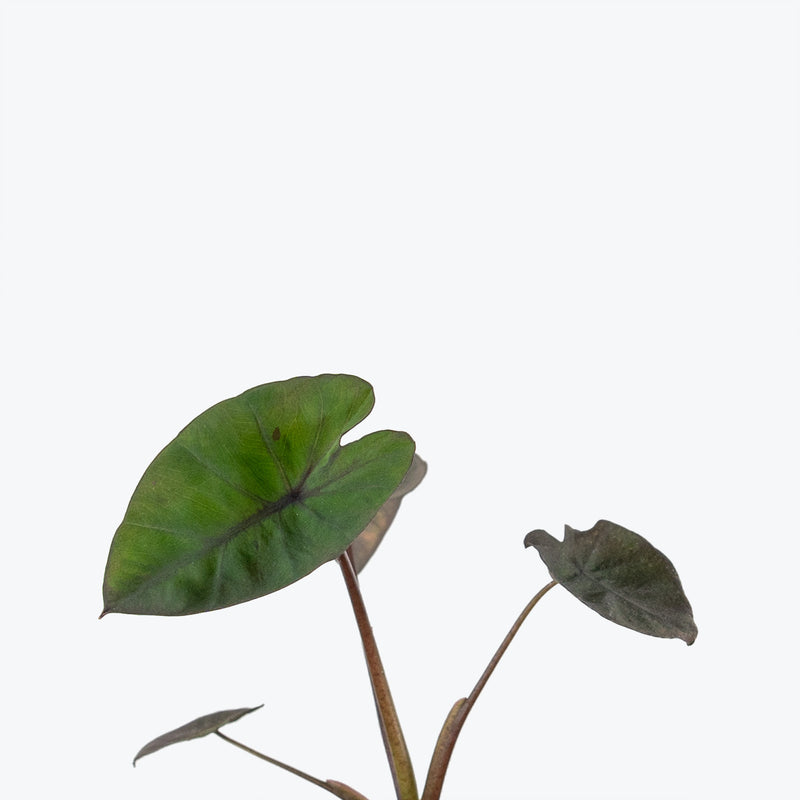
How to care for Colocasia Black Runner
They enjoy some direct sun, but they'll also do well in bright, indirect light. It is best to place this plant somewhere where it will receive some nice morning sun, or a couple hours of afternoon sun, and then indirect light the rest of the day.
They will thrive in bright light, but also can tolerate medium light. A good medium-light place in your home would be in the middle of a room that has a regular size window. They can be placed anywhere between the middle of the room and the window. Remember that plants will grow based on how much light they receive.
Allow the top quarter of the soil to dry before watering again. This usually takes about 3 - 4 days in an average home environment. It will vary depending on the time of year, your environment and lighting conditions. Expect to water more often in brighter light and less often in lower light.
They like a high humidity environment, give them a mist daily or as often as possible. Alternatively, you can put them around a humidifier. Although they won't die if they don't receive enough humidity, their leaves may have some dry, crunchy, or yellow edges.
The 'Black Runner' requires regular feeding during the growing season. Use a well-balanced, high-quality plant food, and be sure to follow the manufacturer's instructions.
This plant is moderately toxic and can cause some adverse reactions when ingested so it is best to not let your pets eat it, which we advise for all plants in general. The severity of the reaction will depend on how much of the plant is ingested but, if you know your pet typically does not eat your plants, this plant will be suitable for your home..
View PlantColocasia Kona Coffee
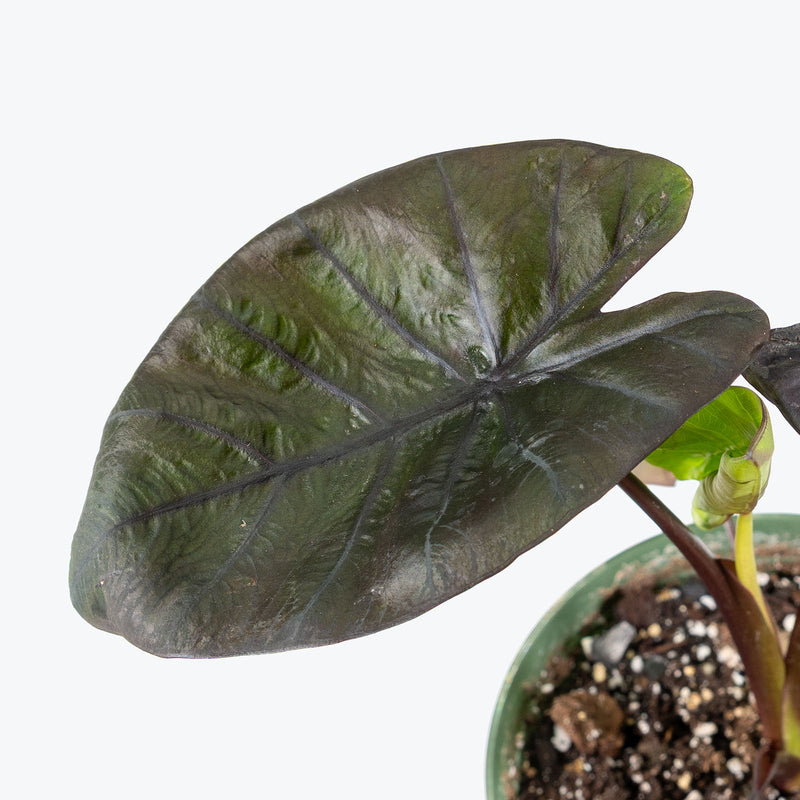
How to care for Colocasia Kona Coffee
Colocasia Kona Coffee enjoys some direct sun, but they'll also do well in bright, indirect light. It is best to place this plant somewhere where it will receive some nice morning sun, or a couple hours of afternoon sun, and then indirect light the rest of the day.
Colocasia Kona Coffee will thrive in bright light, but also can tolerate medium light. A good medium-light place in your home would be in the middle of a room that has a regular size window. They can be placed anywhere between the middle of the room and the window. Remember that plants will grow based on how much light they receive.
Allow the top quarter of the soil to dry before watering Colocasia Kona Coffee again. This usually takes about 3 - 4 days in an average home environment. It will vary depending on the time of year, your environment and lighting conditions. Expect to water more often in brighter light and less often in lower light.
Colocasia Kona Coffee likes a high humidity environment, give them a mist daily or as often as possible. Alternatively, you can put them around a humidifier. Although they won't die if they don't receive enough humidity, their leaves may have some dry, crunchy, or yellow edges.
Colocasia Kona Coffee thrives in consistently moist, rich soil — never let it fully dry out, especially in warm weather. Boost humidity indoors with misting or a humidifier to preserve its glossy, dark finish. For best leaf colour and fullness, feed every 2–3 weeks during the growing season with a balanced, nitrogen-rich fertilizer. Outdoors, mulch around the base to conserve moisture. Indoors, give it a roomy pot with excellent drainage and rotate it regularly for even growth.
Colocasia Kona Coffee is moderately toxic and can cause some adverse reactions when ingested so it is best to not let your pets eat it, which we advise for all plants in general. The severity of the reaction will depend on how much of the plant is ingested but, if you know your pet typically does not eat your plants, this plant will be suitable for your home..
View PlantColocasia Maui Sunrise

How to care for Colocasia Maui Sunrise
Colocasia Maui Sunrise enjoys some direct sun, but they'll also do well in bright, indirect light. It is best to place this plant somewhere where it will receive some nice morning sun, or a couple hours of afternoon sun, and then indirect light the rest of the day.
Colocasia Maui Sunrise will thrive in bright light, but also can tolerate medium light. A good medium-light place in your home would be in the middle of a room that has a regular size window. They can be placed anywhere between the middle of the room and the window. Remember that plants will grow based on how much light they receive.
Allow the top quarter of the soil to dry before watering Colocasia Maui Sunrise again. This usually takes about 3 - 4 days in an average home environment. It will vary depending on the time of year, your environment and lighting conditions. Expect to water more often in brighter light and less often in lower light.
Colocasia Maui Sunrise likes a high humidity environment, give them a mist daily or as often as possible. Alternatively, you can put them around a humidifier. Although they won't die if they don't receive enough humidity, their leaves may have some dry, crunchy, or yellow edges.
To get the brightest contrast from Colocasia Maui Sunrise’s bold variegation, plant it in rich, well-draining soil and provide consistent moisture — it prefers to stay evenly moist but not soggy. Outdoors, add mulch to help retain soil moisture and regulate temperature. Indoors, give it a large pot with drainage and bright, filtered light. Fertilize every 2–3 weeks during the growing season with a nitrogen-rich formula to support lush foliage and fast growth. Rotate occasionally to encourage upright, balanced leaves and show off that striking midrib from every angle.
Colocasia Maui Sunrise is moderately toxic and can cause some adverse reactions when ingested so it is best to not let your pets eat it, which we advise for all plants in general. The severity of the reaction will depend on how much of the plant is ingested but, if you know your pet typically does not eat your plants, this plant will be suitable for your home..
View PlantColocasia Redemption
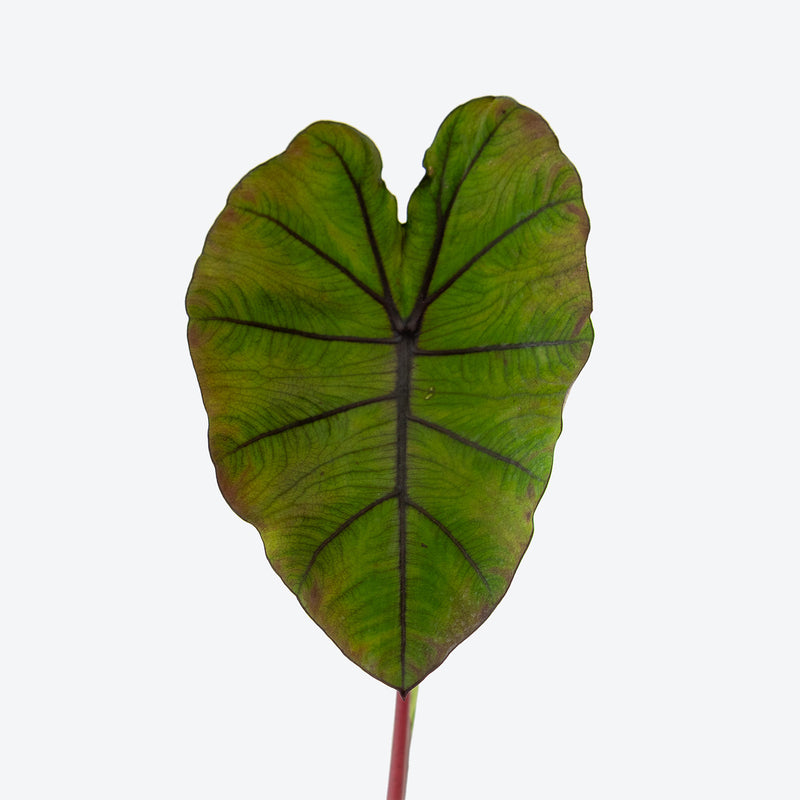
How to care for Colocasia Redemption
Colocasia Redemption enjoys some direct sun, but they'll also do well in bright, indirect light. It is best to place this plant somewhere where it will receive some nice morning sun, or a couple hours of afternoon sun, and then indirect light the rest of the day.
Colocasia Redemption will thrive in bright light, but also can tolerate medium light. A good medium-light place in your home would be in the middle of a room that has a regular size window. They can be placed anywhere between the middle of the room and the window. Remember that plants will grow based on how much light they receive.
Allow the top quarter of the soil to dry before watering Colocasia Redemption again. This usually takes about 3 - 4 days in an average home environment. It will vary depending on the time of year, your environment and lighting conditions. Expect to water more often in brighter light and less often in lower light.
Colocasia Redemption likes a high humidity environment, give them a mist daily or as often as possible. Alternatively, you can put them around a humidifier. Although they won't die if they don't receive enough humidity, their leaves may have some dry, crunchy, or yellow edges.
Colocasia Redemption is all about the foliage — and that foliage is best when the plant is mature and well-fed. Start fertilizing early in the growing season with a high-nitrogen fertilizer every 2–3 weeks to encourage leaf size and vibrancy. This is a thirsty plant: consistent watering is crucial, especially in heat. In containers, consider a saucer or tray to help maintain moisture. You can also grow it in waterlogged soil or even shallow water! Indoors, be sure the pot is large enough to support growth — it may seem slow at first, but once established, it fills in fast.
Colocasia Redemption is moderately toxic and can cause some adverse reactions when ingested so it is best to not let your pets eat it, which we advise for all plants in general. The severity of the reaction will depend on how much of the plant is ingested but, if you know your pet typically does not eat your plants, this plant will be suitable for your home..
View PlantColocasia Tropical Storm
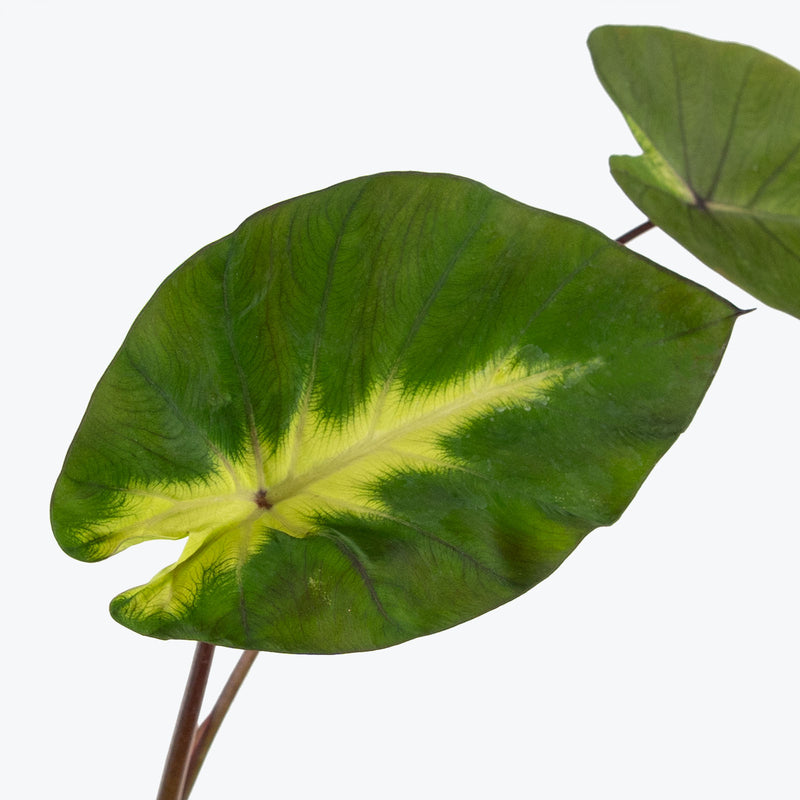
How to care for Colocasia Tropical Storm
They enjoy some direct sun, but they'll also do well in bright, indirect light. It is best to place this plant somewhere where it will receive some nice morning sun, or a couple hours of afternoon sun, and then indirect light the rest of the day.
They will thrive in bright light, but also can tolerate medium light. A good medium-light place in your home would be in the middle of a room that has a regular size window. They can be placed anywhere between the middle of the room and the window. Remember that plants will grow based on how much light they receive.
Allow the top quarter of the soil to dry before watering again. This usually takes about 3 - 4 days in an average home environment. It will vary depending on the time of year, your environment and lighting conditions. Expect to water more often in brighter light and less often in lower light.
They like a high humidity environment, give them a mist daily or as often as possible. Alternatively, you can put them around a humidifier. Although they won't die if they don't receive enough humidity, their leaves may have some dry, crunchy, or yellow edges.
Colocasia 'Tropical Storm' can be a heavy feeder during the growing season. Consider fertilizing every two weeks with a balanced plant food. And while it is a robust plant, it's still a good idea to keep an eye out for pests like spider mites and aphids.
This plant is moderately toxic and can cause some adverse reactions when ingested so it is best to not let your pets eat it, which we advise for all plants in general. The severity of the reaction will depend on how much of the plant is ingested but, if you know your pet typically does not eat your plants, this plant will be suitable for your home..
View PlantColocasia Waikiki

How to care for Colocasia Waikiki
Colocasia Waikiki enjoys some direct sun, but they'll also do well in bright, indirect light. It is best to place this plant somewhere where it will receive some nice morning sun, or a couple hours of afternoon sun, and then indirect light the rest of the day.
Colocasia Waikiki will thrive in bright light, but also can tolerate medium light. A good medium-light place in your home would be in the middle of a room that has a regular size window. They can be placed anywhere between the middle of the room and the window. Remember that plants will grow based on how much light they receive.
Allow the top quarter of the soil to dry before watering Colocasia Waikiki again. This usually takes about 3 - 4 days in an average home environment. It will vary depending on the time of year, your environment and lighting conditions. Expect to water more often in brighter light and less often in lower light.
Colocasia Waikiki likes a high humidity environment, give them a mist daily or as often as possible. Alternatively, you can put them around a humidifier. Although they won't die if they don't receive enough humidity, their leaves may have some dry, crunchy, or yellow edges.
Colocasia Waikiki demands consistent watering and rich soil to achieve its bold variegation and compact, full shape. Feed every 2–3 weeks during the growing season with a balanced fertilizer high in nitrogen to encourage larger, more colourful leaves. Avoid letting the soil dry out, especially during summer heat — dehydration can lead to smaller leaves and washed-out colours. Outdoors, apply a layer of mulch to retain soil moisture and regulate temperature. Indoors, ensure a large enough pot with excellent drainage. This variety benefits from slightly warmer nighttime temperatures to maintain vigorous growth and colour saturation.
Colocasia Waikiki is moderately toxic and can cause some adverse reactions when ingested so it is best to not let your pets eat it, which we advise for all plants in general. The severity of the reaction will depend on how much of the plant is ingested but, if you know your pet typically does not eat your plants, this plant will be suitable for your home..
View PlantColumnea Hirta
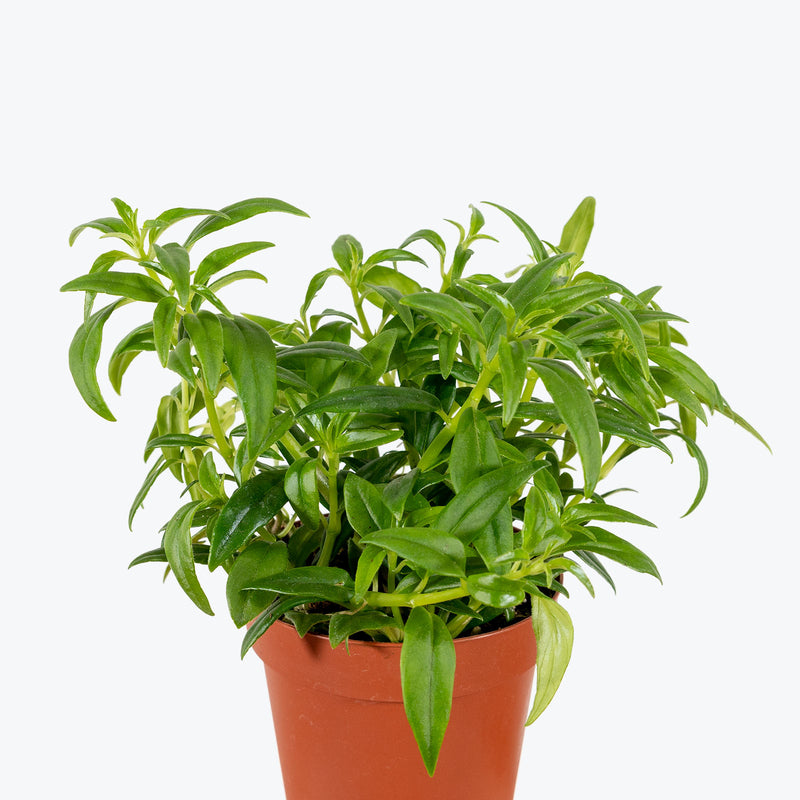
How to care for Columnea Hirta
They should not be in a position to see the sun directly, although early morning or late evening sun is fine. Filtered sunlight through a sheer curtain is best and most homes are comprised primarily of indirect sunlight. The best spot for them is where they do not see the sun during the majority of the day but still get bright, indirect light.
They will thrive in bright light, but also can tolerate medium light. A good medium-light place in your home would be in the middle of a room that has a regular size window. They can be placed anywhere between the middle of the room and the window. Remember that plants will grow based on how much light they receive.
They like the soil to stay consistently moist, but not soaking wet. Give them water whenever just the surface of the soil is starting to get dry. Expect to water more often in brighter light and less often in lower light.
They will do well in average humidity environments but will appreciate a little bit of humidity if provided, give them a mist daily or get a humidifier. Avoid misting them with cold water as this will damage the foliage.
Avoid getting cold water on the foliage, as this can burn the leaves! If you want your plant to keep on blooming, keep it in a location that receives bright, indirect light rather than medium light. They prefer to be slightly pot-bound, which will also encourage more blooms. Fertilize weekly during the growing season with diluted liquid fertilizer.
You can feel comfortable having this plant around your home in the potential case where your pet feels like nibbling on it. However, we typically recommend keeping your pets from eating any of your houseplants..
View PlantCoral Cactus

How to care for Coral Cactus
Coral Cactus enjoys some direct sun, but they'll also do well in bright, indirect light. It is best to place this plant somewhere where it will receive some nice morning sun, or a couple hours of afternoon sun, and then indirect light the rest of the day.
Coral Cactus will thrive in bright light, but also can tolerate medium light. A good medium-light place in your home would be in the middle of a room that has a regular size window. They can be placed anywhere between the middle of the room and the window. Remember that plants will grow based on how much light they receive.
Coral Cactus likes the soil to be completely dry before the next watering. That usually takes about 4 weeks in an average home environment. It will vary depending on the time of year, your environment and lighting conditions, but for them, it's always safer to underwater or water when you see signs of lack of water (i.e. wrinkly or soft leaves). Water a little more often in the warmer months.
Their humidity requirement is low, so do not mist Coral Cactus or put them in an enclosed terrarium.
Use cactus or succulent soil mix to provide the best drainage and environment for root health. Fertilize Coral Cactus during the growing season with a cactus-specific fertilizer diluted to half strength, but avoid feeding during the dormant winter months. Be cautious when handling this plant, as its sap can be irritating to the skin and eyes, and it is advisable to wear gloves.
Coral Cactus is moderately toxic and can cause some adverse reactions when ingested so it is best to not let your pets eat it, which we advise for all plants in general. The severity of the reaction will depend on how much of the plant is ingested but, if you know your pet typically does not eat your plants, this plant will be suitable for your home..
Learn MoreView PlantCrassula Muscosa
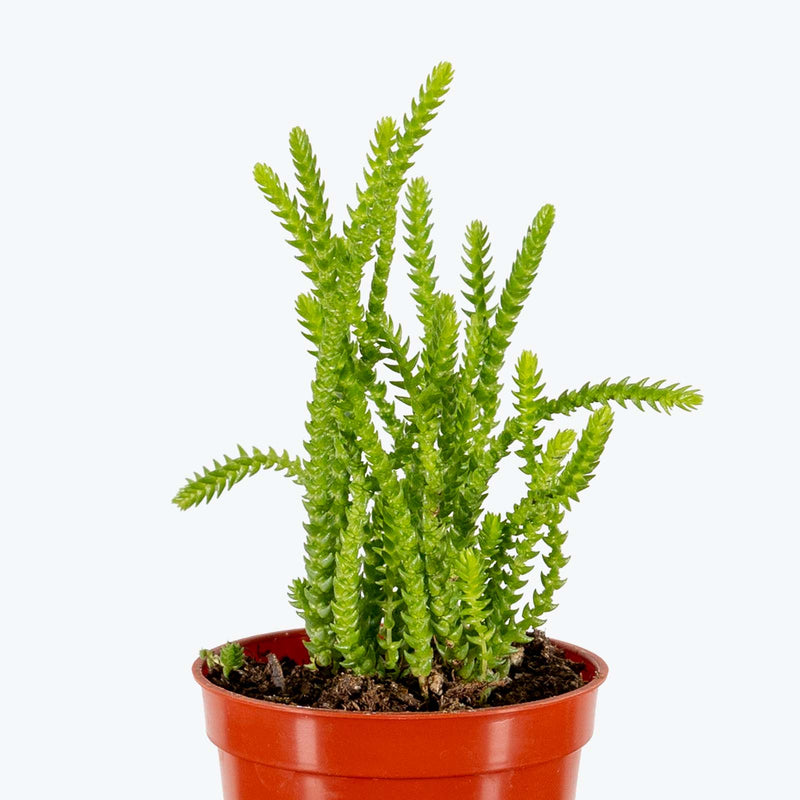
How to care for Crassula Muscosa
They enjoy some direct sun, but they'll also do well in bright, indirect light. It is best to place this plant somewhere where it will receive some nice morning sun, or a couple hours of afternoon sun, and then indirect light the rest of the day.
They will do best in bright light. A nice bright place inside your home would be on the window sill or a stool that is right next to a window, either with or without blinds, depending on if the plant can handle sun. Remember that plants will grow based on how much light they receive.
They like the soil to be completely dry before the next watering. That usually takes about 4 weeks in an average home environment. It will vary depending on the time of year, your environment and lighting conditions, but for them, it's always safer to underwater or water when you see signs of lack of water (i.e. wrinkly or soft leaves). Water a little more often in the warmer months.
Their humidity requirement is low, so do not mist them or put them in a terrarium.
Crassula is a drought-tolerant plant and prefers to be under-watered. Not sure when to water? Look for wrinkles on the leaves, as they are a telltale sign. To make the leaves denser and more tightly packed, place the plant in higher light!
You can feel comfortable having this plant around your home in the potential case where your pet feels like nibbling on it. However, we typically recommend keeping your pets from eating any of your houseplants..
View PlantCrassula Spiralis Black Curl
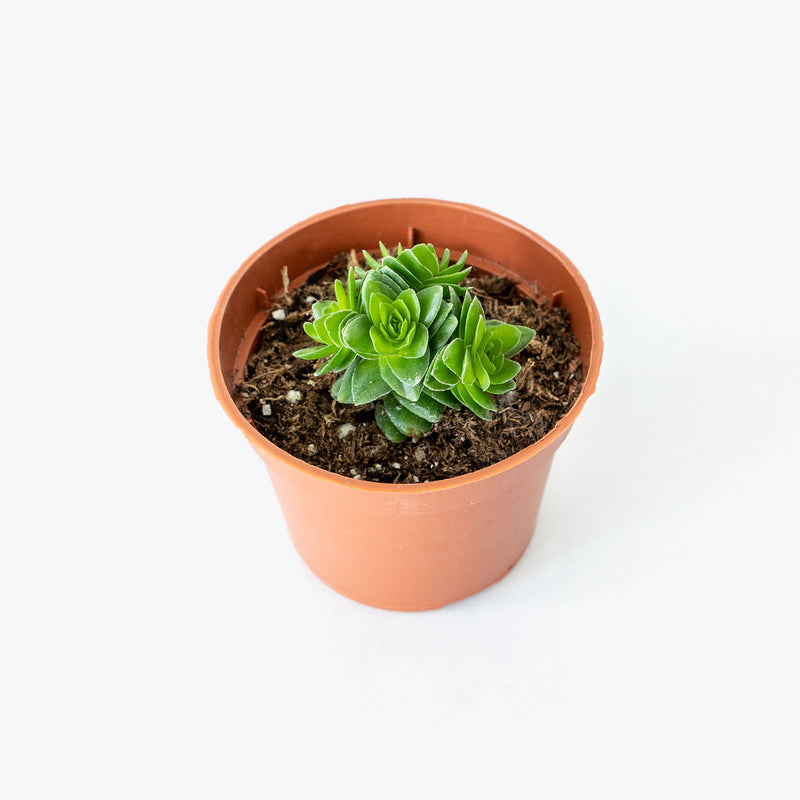
How to care for Crassula Spiralis Black Curl
They enjoy some direct sun, but they'll also do well in bright, indirect light. It is best to place this plant somewhere where it will receive some nice morning sun, or a couple hours of afternoon sun, and then indirect light the rest of the day.
They will do best in bright light. A nice bright place inside your home would be on the window sill or a stool that is right next to a window, either with or without blinds, depending on if the plant can handle sun. Remember that plants will grow based on how much light they receive.
They like the soil to be completely dry before the next watering. That usually takes about 4 weeks in an average home environment. It will vary depending on the time of year, your environment and lighting conditions, but for them, it's always safer to underwater or water when you see signs of lack of water (i.e. wrinkly or soft leaves). Water a little more often in the warmer months.
Their humidity requirement is low, so do not mist them or put them in a terrarium.
Crassula is drought-tolerant plant and prefers to be under-watered. Not sure when to water? Wrinkles on the leaves are a telltale sign. If you want the leaves to be more dense and tightly packed, place the plant in higher light!
You can feel comfortable having this plant around your home in the potential case where your pet feels like nibbling on it. However, we typically recommend keeping your pets from eating any of your houseplants..
View PlantCroton Batik
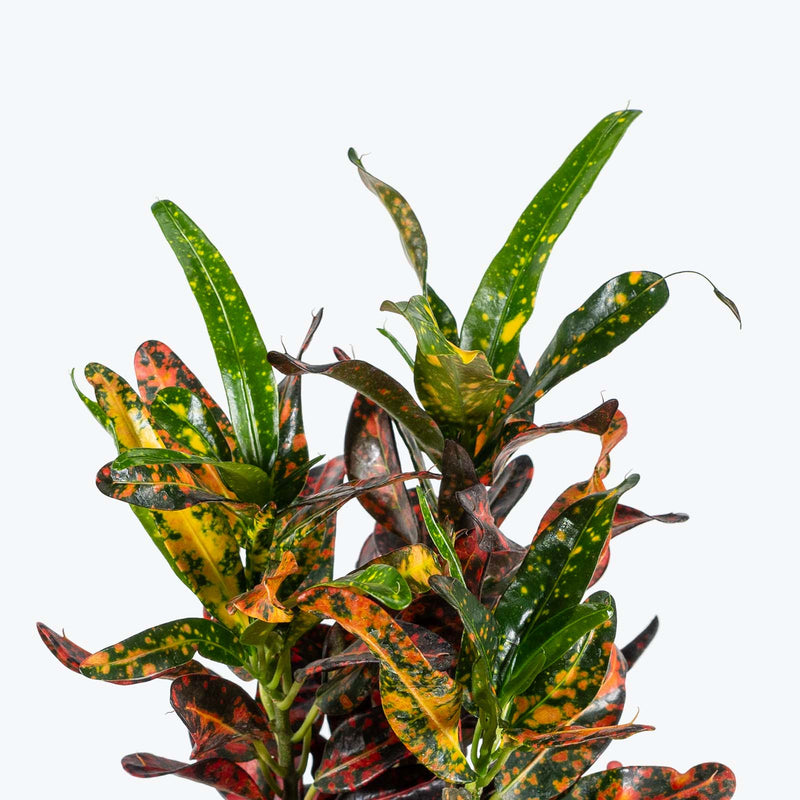
How to care for Croton Batik
They enjoy some direct sun, but they'll also do well in bright, indirect light. It is best to place this plant somewhere where it will receive some nice morning sun, or a couple hours of afternoon sun, and then indirect light the rest of the day.
They will do best in bright light. A nice bright place inside your home would be on the window sill or a stool that is right next to a window, either with or without blinds, depending on if the plant can handle sun. Remember that plants will grow based on how much light they receive.
Allow the top quarter of the soil to dry before watering again. This usually takes about 3 - 4 days in an average home environment. It will vary depending on the time of year, your environment and lighting conditions. Expect to water more often in brighter light and less often in lower light.
They like a high humidity environment, give them a mist daily or as often as possible. Alternatively, you can put them around a humidifier. Although they won't die if they don't receive enough humidity, their leaves may have some dry, crunchy, or yellow edges.
Croton 'Batik' can be a bit temperamental with changes in its environment. Avoid moving the plant frequently and ensure consistent watering and light conditions. Inadequate light or moisture can lead to leaf drop.
This plant is moderately toxic and can cause some adverse reactions when ingested so it is best to not let your pets eat it, which we advise for all plants in general. The severity of the reaction will depend on how much of the plant is ingested but, if you know your pet typically does not eat your plants, this plant will be suitable for your home..
View PlantCroton Oakleaf
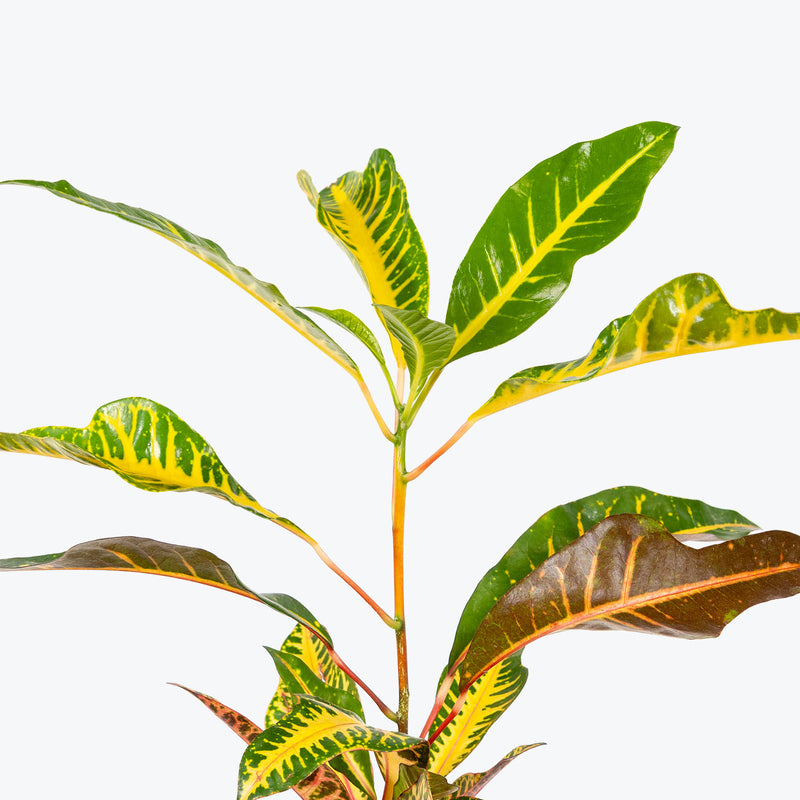
How to care for Croton Oakleaf
They enjoy some direct sun, but they'll also do well in bright, indirect light. It is best to place this plant somewhere where it will receive some nice morning sun, or a couple hours of afternoon sun, and then indirect light the rest of the day.
They will thrive in bright light, but also can tolerate medium light. A good medium-light place in your home would be in the middle of a room that has a regular size window. They can be placed anywhere between the middle of the room and the window. Remember that plants will grow based on how much light they receive.
Allow the top quarter of the soil to dry before watering again. This usually takes about 3 - 4 days in an average home environment. It will vary depending on the time of year, your environment and lighting conditions. Expect to water more often in brighter light and less often in lower light.
They like a high humidity environment, give them a mist daily or as often as possible. Alternatively, you can put them around a humidifier. Although they won't die if they don't receive enough humidity, their leaves may have some dry, crunchy, or yellow edges.
Fertilize your croton about once per week with a 3-1-2 liquid fertilizer during the growing season. They are a slow grower, even in bright light and proper conditions, so if your plant is in a lower light space it will grow very slowly. Avoid pruning them too much when they are at the peak of their growing season.
This plant is moderately toxic and can cause some adverse reactions when ingested so it is best to not let your pets eat it, which we advise for all plants in general. The severity of the reaction will depend on how much of the plant is ingested but, if you know your pet typically does not eat your plants, this plant will be suitable for your home..
View PlantCroton Petra
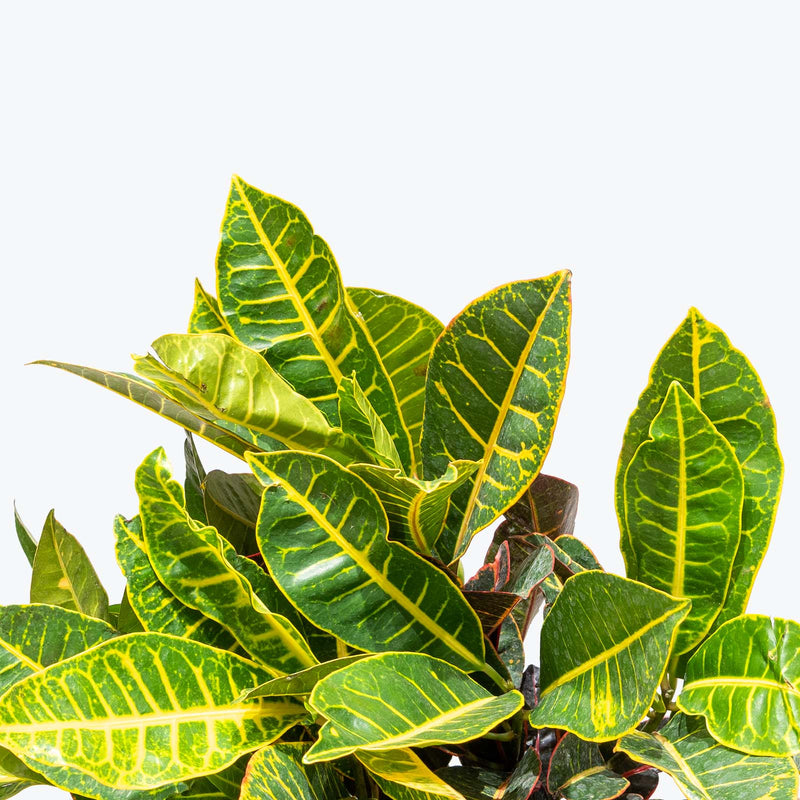
How to care for Croton Petra
Croton Petra loves as much heat and sun as possible. The best spot for them is where they can see the sun for the majority of the day. They can also handle indirect light but will lose most of their colouring.
Croton Petra will do their best in bright light. A nice bright place outside would be on a sunny balcony, deck, or backyard; inside your home, it would do best in a sunny window sill. Remember that plants will grow based on how much light they receive.
Croton Petra needs to be watered when the top half of the soil is dry to the touch. That usually takes about 1 week in an average home environment. It will vary depending on the time of year, your environment and lighting conditions, but it's always safer to underwater or give the soil a check before you water again. Expect to water more often in brighter light and less often in lower light.
Croton Petra will do well in average humidity environments but will appreciate a little bit of humidity if provided, give them a mist daily or get a humidifier.
Rotate Croton Petra regularly to keep its colour even and growth upright. Crotons are sensitive to change, so don’t be surprised if it drops a few leaves when moved — give it time to settle in. Use a well-draining mix and fertilize monthly in spring and summer to boost vibrant leaf colour. Wipe the leaves occasionally to remove dust and maintain their glossy finish.
Croton Petra is moderately toxic and can cause some adverse reactions when ingested so it is best to not let your pets eat it, which we advise for all plants in general. The severity of the reaction will depend on how much of the plant is ingested but, if you know your pet typically does not eat your plants, this plant will be suitable for your home..
View PlantCroton Picasso's Paintbrush
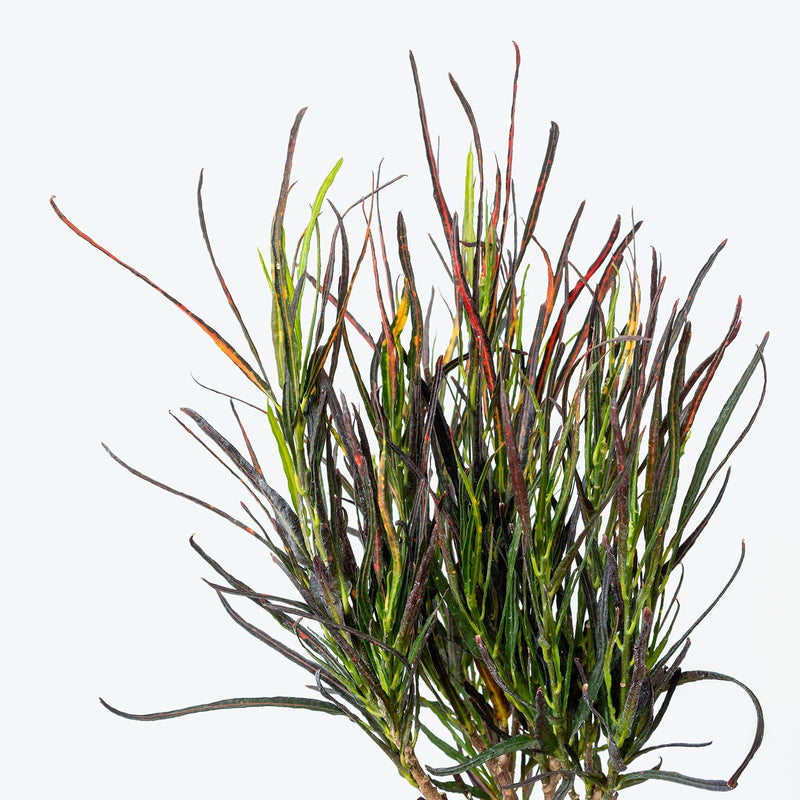
How to care for Croton Picasso's Paintbrush
They enjoy some direct sun, but they'll also do well in bright, indirect light. It is best to place this plant somewhere where it will receive some nice morning sun, or a couple hours of afternoon sun, and then indirect light the rest of the day.
They will thrive in bright light, but also can tolerate medium light. A good medium-light place in your home would be in the middle of a room that has a regular size window. They can be placed anywhere between the middle of the room and the window. Remember that plants will grow based on how much light they receive.
Allow the top quarter of the soil to dry before watering again. This usually takes about 3 - 4 days in an average home environment. It will vary depending on the time of year, your environment and lighting conditions. Expect to water more often in brighter light and less often in lower light.
They can live in any average home humidity condition and are fairly hardy.
They are little finicky in that they need bright light and evenly moist soil. But they have gorgeous colours when they receive that beautiful light.
This plant is moderately toxic and can cause some adverse reactions when ingested so it is best to not let your pets eat it, which we advise for all plants in general. The severity of the reaction will depend on how much of the plant is ingested but, if you know your pet typically does not eat your plants, this plant will be suitable for your home..
View PlantCrown of Thorns
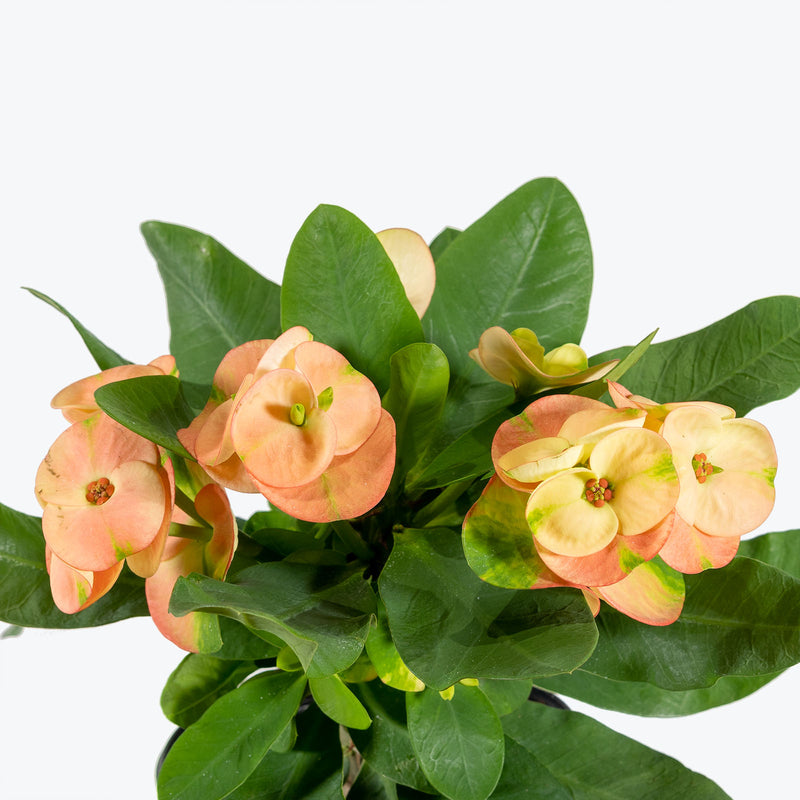
How to care for Crown of Thorns
They love as much sun as possible. The best spot for them is where they can see the sun during the majority of the day.
They will do best in bright light. A nice bright place inside your home would be on the window sill or a stool that is right next to a window, either with or without blinds, depending on if the plant can handle sun. Remember that plants will grow based on how much light they receive.
They like the soil to be relatively dry before the next watering. That usually takes about 2 weeks in an average home environment. It will vary depending on the time of year, your environment and lighting conditions, but for them, it's always safer to underwater or water when you see signs of lack of water (i.e. droopy, floppy, or soft leaves). Expect to water more often in brighter light and less often in lower light.
Their humidity requirement is low, so do not mist them or put them in a terrarium.
Give it a quarter turn every week to expose all sides to sunlight to promote even growth. To promote a full and bushy plant, give it some renewal pruning at the end of the season, cutting away any older leaves to encourage new growth. Try to avoid getting water on the leaves and stems because they can rot if they get too wet. Yellow leaves that fall off are a sign the plant is over-watered. Also, wear thick gloves when handling this plant to protect against the prickly thorns and sap, which can irritate the skin.
This plant is moderately toxic and can cause some adverse reactions when ingested so it is best to not let your pets eat it, which we advise for all plants in general. The severity of the reaction will depend on how much of the plant is ingested but, if you know your pet typically does not eat your plants, this plant will be suitable for your home..
View PlantCryptanthus Absolute Zero
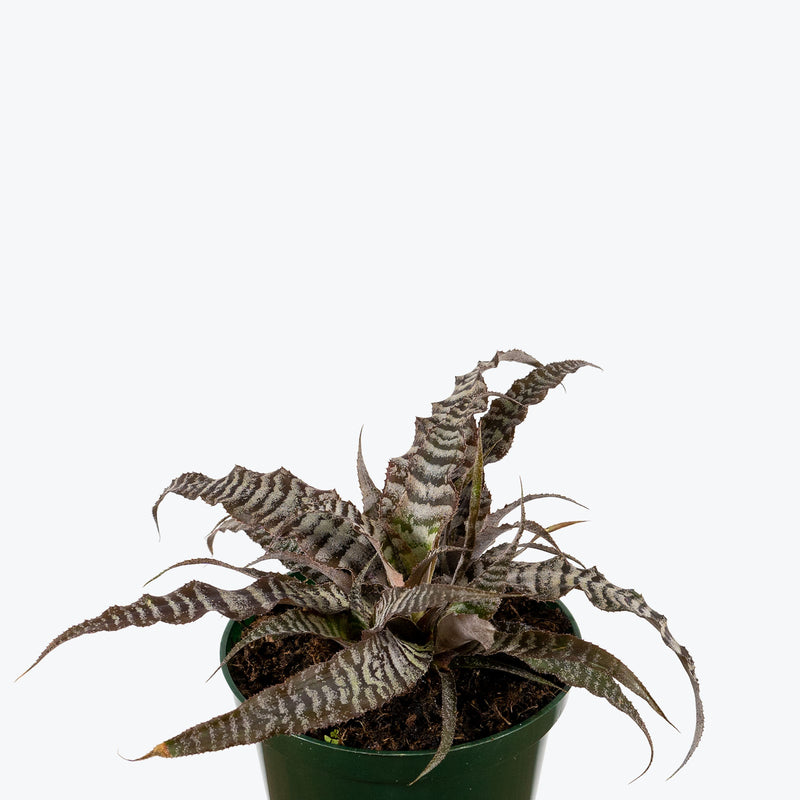
How to care for Cryptanthus Absolute Zero
They should not be in a position to see the sun directly, although early morning or late evening sun is fine. Filtered sunlight through a sheer curtain is best and most homes are comprised primarily of indirect sunlight. The best spot for them is where they do not see the sun during the majority of the day but still get bright, indirect light.
They will thrive in bright light, but also can tolerate medium light. A good medium-light place in your home would be in the middle of a room that has a regular size window. They can be placed anywhere between the middle of the room and the window. Remember that plants will grow based on how much light they receive.
They like the soil to stay consistently moist, but not soaking wet. Give them water whenever just the surface of the soil is starting to get dry. Expect to water more often in brighter light and less often in lower light.
They like a high humidity environment, give them a mist daily or as often as possible. Alternatively, you can put them around a humidifier. Although they won't die if they don't receive enough humidity, their leaves may have some dry, crunchy, or yellow edges.
To ensure the vibrant black and white leaf striping, grow in a bright location. If grown in shade or low light, the leaves can fade to green. Avoid direct sunlight which may bleach or burn the leaves.
You can feel comfortable having this plant around your home in the potential case where your pet feels like nibbling on it. However, we typically recommend keeping your pets from eating any of your houseplants..
View PlantCryptanthus Earth Star

How to care for Cryptanthus Earth Star
Cryptanthus Earth Star should not be in a position to see the sun directly, although early morning or late evening sun is fine. Filtered sunlight through a sheer curtain is best and most homes are comprised primarily of indirect sunlight. The best spot for them is where they do not see the sun during the majority of the day but still get bright, indirect light.
Cryptanthus Earth Star will thrive in bright light, but also can tolerate medium light. A good medium-light place in your home would be in the middle of a room that has a regular size window. They can be placed anywhere between the middle of the room and the window. Remember that plants will grow based on how much light they receive.
Cryptanthus Earth Star likes the soil to stay consistently moist, but not soaking wet. Give them water whenever just the surface of the soil is starting to get dry. Expect to water more often in brighter light and less often in lower light.
Cryptanthus Earth Star will do well in average humidity environments but will appreciate a little bit of humidity if provided, give them a mist daily or get a humidifier.
Cryptanthus Earth Star prefers warm temperatures and should be protected from cold drafts. They can be repotted every couple of years or as needed to refresh the soil. If grown in shade or low light, the leaves can fade to green. Avoid direct sunlight which may bleach or burn the leaves. Be careful not to over-fertilize, as this can damage the plant.
You can feel comfortable having Cryptanthus Earth Star around your home in the potential case where your pet feels like nibbling on it. However, we typically recommend keeping your pets from eating any of your houseplants..
View PlantCtenanthe Burle-Marxii
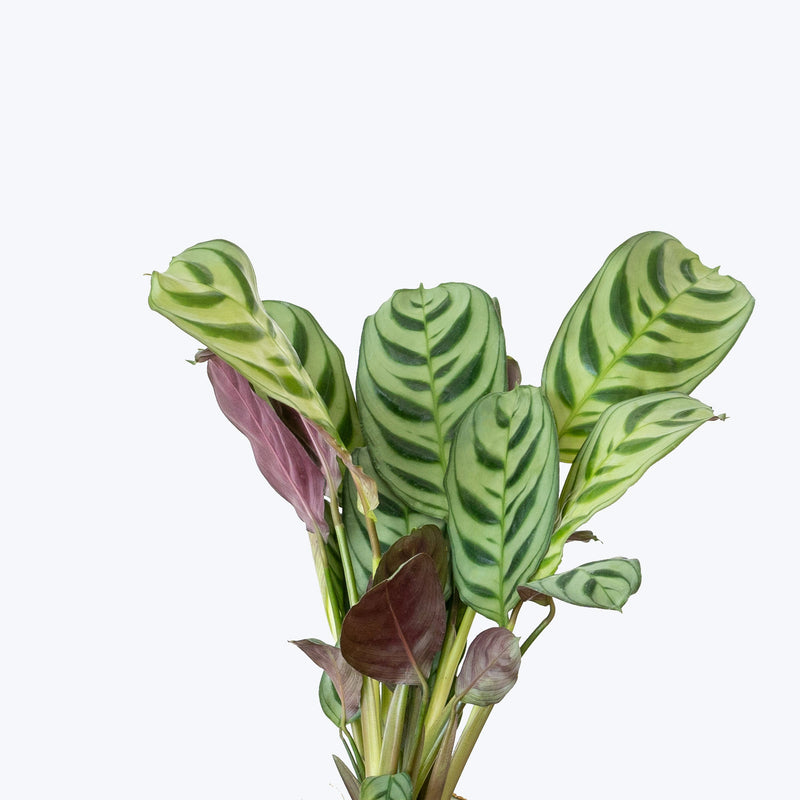
How to care for Ctenanthe Burle-Marxii
They should not be in a position to see the sun directly, although early morning or late evening sun is fine. Filtered sunlight through a sheer curtain is best and most homes are comprised primarily of indirect sunlight. The best spot for them is where they do not see the sun during the majority of the day but still get bright, indirect light.
They will thrive in bright light, but also can tolerate medium light. A good medium-light place in your home would be in the middle of a room that has a regular size window. They can be placed anywhere between the middle of the room and the window. Remember that plants will grow based on how much light they receive.
They need to be watered when the top half of the soil is dry to the touch. That usually takes about 1 week in an average home environment. It will vary depending on the time of year, your environment and lighting conditions, but it's always safer to underwater or give the soil a check before you water again.
They like a high humidity environment, give them a mist daily or as often as possible. Alternatively, you can put them around a humidifier. Although they won't die if they don't receive enough humidity, their leaves may have some dry, crunchy, or yellow edges.
Keep them guarded from direct afternoon sun and mist periodically, or set it on a pebble tray filled with water, to increase humidity around the plant and keep its leaves lush.
You can feel comfortable having this plant around your home in the potential case where your pet feels like nibbling on it. However, we typically recommend keeping your pets from eating any of your houseplants..
View PlantCtenanthe Lubbersiana
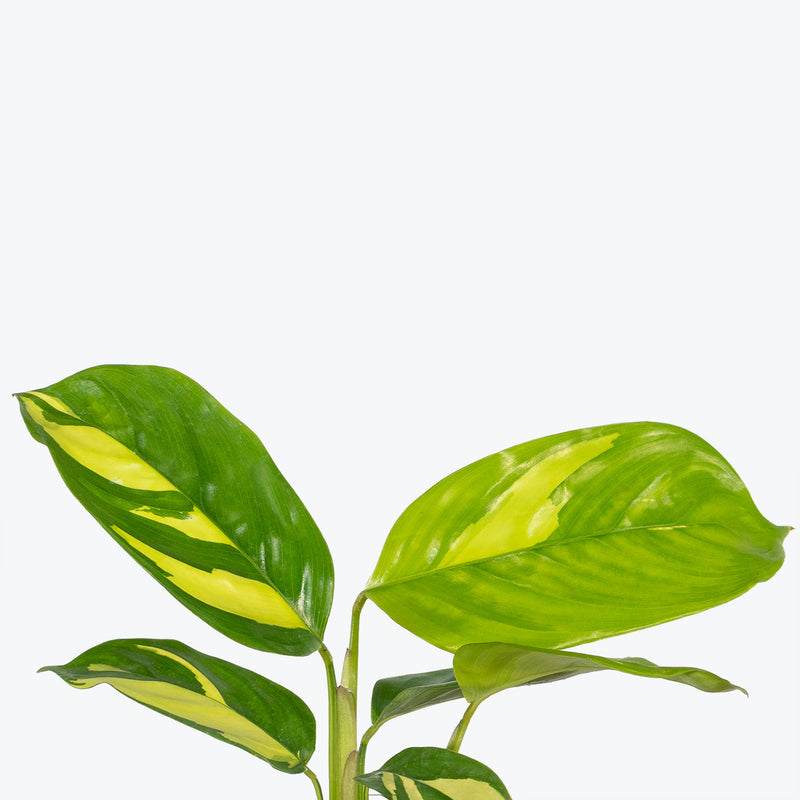
How to care for Ctenanthe Lubbersiana
They should not be in a position to see the sun directly, although early morning or late evening sun is fine. Filtered sunlight through a sheer curtain is best and most homes are comprised primarily of indirect sunlight. The best spot for them is where they do not see the sun during the majority of the day but still get bright, indirect light.
They will thrive in bright light, but also can tolerate medium light. A good medium-light place in your home would be in the middle of a room that has a regular size window. They can be placed anywhere between the middle of the room and the window. Remember that plants will grow based on how much light they receive.
They need to be watered when the top half of the soil is dry to the touch. That usually takes about 1 week in an average home environment. It will vary depending on the time of year, your environment and lighting conditions, but it's always safer to underwater or give the soil a check before you water again. Expect to water more often in brighter light and less often in lower light.
They like a high humidity environment, give them a mist daily or as often as possible. Alternatively, you can put them around a humidifier. Although they won't die if they don't receive enough humidity, their leaves may have some dry, crunchy, or yellow edges.
Keep it guarded against direct afternoon sun and mist periodically, or set it on a pebble tray filled with water, to increase humidity around the plant and keep its leaves lush. Consider using distilled or rainwater instead of tap water to avoid brown edges!
You can feel comfortable having this plant around your home in the potential case where your pet feels like nibbling on it. However, we typically recommend keeping your pets from eating any of your houseplants..
View PlantCtenanthe Oppenheimiana Tricolor
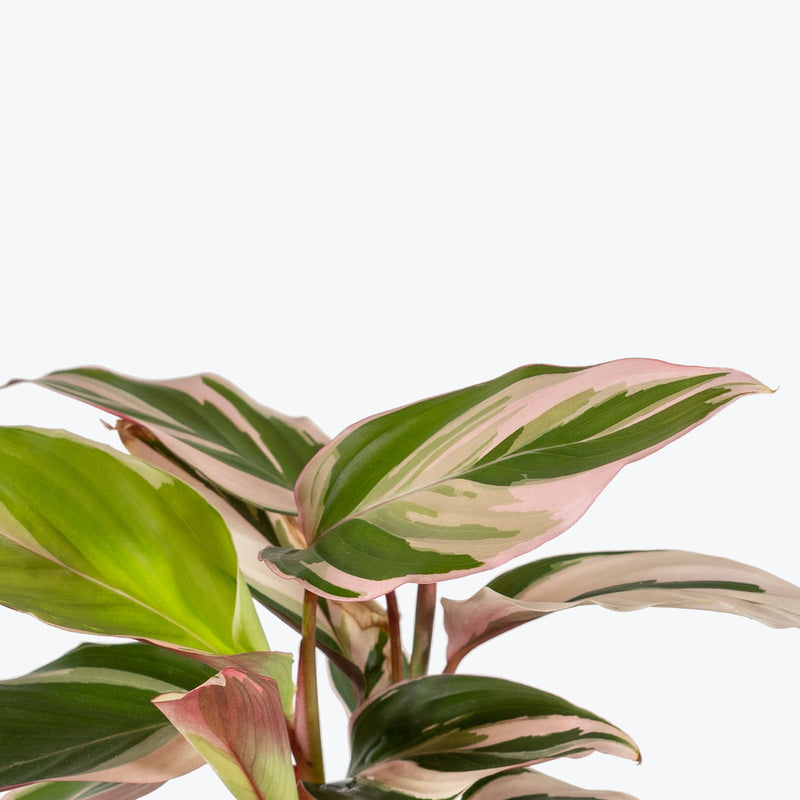
How to care for Ctenanthe Oppenheimiana Tricolor
Ctenanthe Oppenheimiana Tricolor should not be in a position to see the sun directly, although early morning or late evening sun is fine. Filtered sunlight through a sheer curtain is best and most homes are comprised primarily of indirect sunlight. The best spot for them is where they do not see the sun during the majority of the day but still get bright, indirect light.
Ctenanthe Oppenheimiana Tricolor will thrive in bright light, but also can tolerate medium light. A good medium-light place in your home would be in the middle of a room that has a regular size window. They can be placed anywhere between the middle of the room and the window. Remember that plants will grow based on how much light they receive.
Ctenanthe Oppenheimiana Tricolor needs to be watered when the top half of the soil is dry to the touch. That usually takes about 1 week in an average home environment. It will vary depending on the time of year, your environment and lighting conditions, but it's always safer to underwater or give the soil a check before you water again.
Ctenanthe Oppenheimiana Tricolor likes a high humidity environment, give them a mist daily or as often as possible. Alternatively, you can put them around a humidifier. Although they won't die if they don't receive enough humidity, their leaves may have some dry, crunchy, or yellow edges.
Feed Ctenanthe Oppenheimiana Tricolor with a weakened liquid fertilizer during the summer months. Can be cut back to ground level if it becomes leggy, and it will regrow. Divide the plant if it becomes too congested. Remove dead foliage regularly and keep the soil moist in warmer weather.
You can feel comfortable having Ctenanthe Oppenheimiana Tricolor around your home in the potential case where your pet feels like nibbling on it. However, we typically recommend keeping your pets from eating any of your houseplants..
View PlantCtenanthe Setosa Grey Star
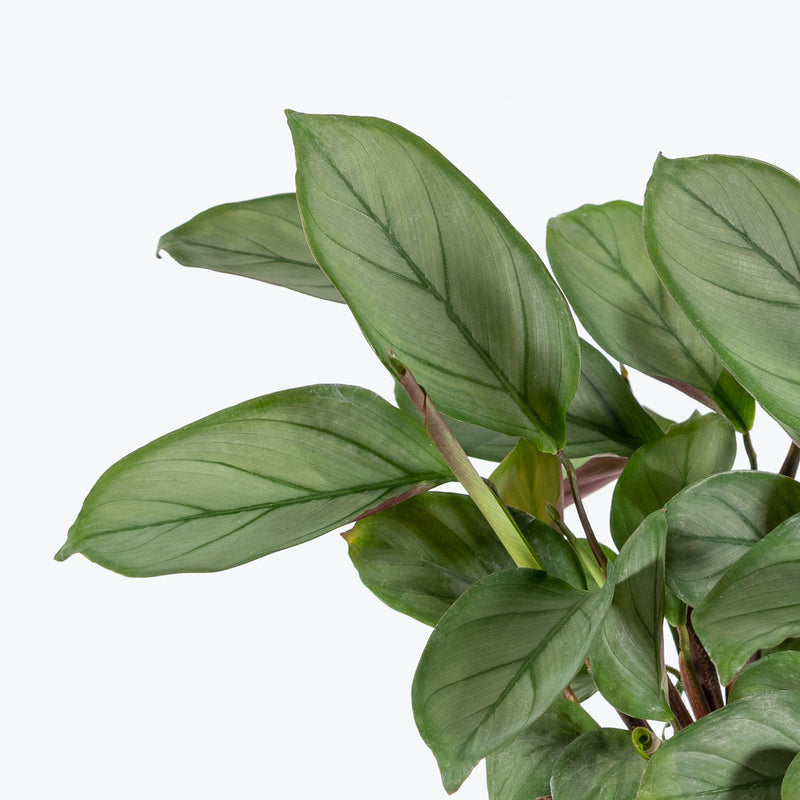
How to care for Ctenanthe Setosa Grey Star
They should not be in a position to see the sun directly, although early morning or late evening sun is fine. Filtered sunlight through a sheer curtain is best and most homes are comprised primarily of indirect sunlight. The best spot for them is where they do not see the sun during the majority of the day but still get bright, indirect light.
They will thrive in bright light, but also can tolerate medium light. A good medium-light place in your home would be in the middle of a room that has a regular size window. They can be placed anywhere between the middle of the room and the window. Remember that plants will grow based on how much light they receive.
They need to be watered when the top half of the soil is dry to the touch. That usually takes about 1 week in an average home environment. It will vary depending on the time of year, your environment and lighting conditions, but it's always safer to underwater or give the soil a check before you water again. Expect to water more often in brighter light and less often in lower light.
They like a high humidity environment, give them a mist daily or as often as possible. Alternatively, you can put them around a humidifier. Although they won't die if they don't receive enough humidity, their leaves may have some dry, crunchy, or yellow edges.
Keep in a highly humid environment with lots of bright, indirect light (no direct sun), watering only with distilled or rain water. Once this is achieved, you will sit and stare at your new plant with its stunning foliage for hours.
You can feel comfortable having this plant around your home in the potential case where your pet feels like nibbling on it. However, we typically recommend keeping your pets from eating any of your houseplants..
View PlantCuddly Cactus
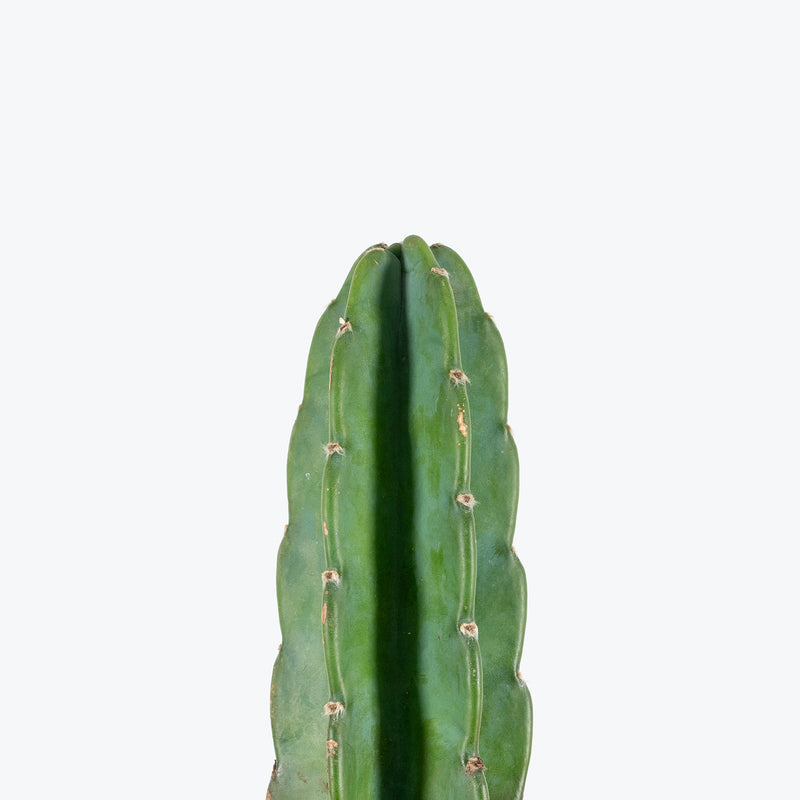
How to care for Cuddly Cactus
Cuddly Cactus enjoys some direct sun, but they'll also do well in bright, indirect light. It is best to place this plant somewhere where it will receive some nice morning sun, or a couple hours of afternoon sun, and then indirect light the rest of the day.
Cuddly Cactus will do best in bright light. A nice bright place inside your home would be on the window sill or a stool that is right next to a window, either with or without blinds, depending on if the plant can handle sun. Remember that plants will grow based on how much light they receive.
Cuddly Cactus likes the soil to be completely dry before the next watering. That usually takes about 4 weeks in an average home environment. It will vary depending on the time of year, your environment and lighting conditions, but for them, it's always safer to underwater or water when you see signs of lack of water (i.e. wrinkly or soft leaves). Water a little more often in the warmer months.
Their humidity requirement is low, so do not mist Cuddly Cactus or put them in an enclosed terrarium.
Use a well-draining cactus mix to prevent root rot. During the growing season, you can fertilize Cuddly Cactus with a cactus-specific fertilizer to support its growth and flowering. Prune only to remove dead or damaged stems, or to control its size. Due to its rapid growth and potential size, periodic repotting and structural support might be necessary.
You can feel comfortable having Cuddly Cactus around your home in the potential case where your pet feels like nibbling on it. However, we typically recommend keeping your pets from eating any of your houseplants..
Learn MoreView PlantCyrtosperma Johnstonii

How to care for Cyrtosperma Johnstonii
Cyrtosperma Johnstonii should not be in a position to see the sun directly, although early morning or late evening sun is fine. Filtered sunlight through a sheer curtain is best and most homes are comprised primarily of indirect sunlight. The best spot for them is where they do not see the sun during the majority of the day but still get bright, indirect light.
Cyrtosperma Johnstonii will thrive in bright light, but also can tolerate medium light. A good medium-light place in your home would be in the middle of a room that has a regular size window. They can be placed anywhere between the middle of the room and the window. Remember that plants will grow based on how much light they receive.
Cyrtosperma Johnstonii likes the soil to stay consistently moist, but not soaking wet. Give them water whenever just the surface of the soil is starting to get dry. Expect to water more often in brighter light and less often in lower light.
Cyrtosperma Johnstonii likes a high humidity environment, give them a mist daily or as often as possible. Alternatively, you can put them around a humidifier. Although they won't die if they don't receive enough humidity, their leaves may have some dry, crunchy, or yellow edges.
Because of its need for warm conditions, maintain a warm environment, especially focusing on water temperature. Cyrtosperma Johnstonii can tolerate cooler air temperatures if the water it is grown in remains warm. Fertilize with a diluted liquid plant food during the growing season to support its vigorous growth. Regularly check for pests, as the dense foliage and moist environment can attract them.
Cyrtosperma Johnstonii is moderately toxic and can cause some adverse reactions when ingested so it is best to not let your pets eat it, which we advise for all plants in general. The severity of the reaction will depend on how much of the plant is ingested but, if you know your pet typically does not eat your plants, this plant will be suitable for your home..
View Plant



